ADAPTATION SENSATION

INSULATION | AIRTIGHTNESS | BUILDING SCIENCE | VENTILATION | GREEN MATERIALS Issue 44 €6.95 IRISH EDITION SUSTAINABLE BUILDING Modern love 1960s modernist gem gets Enerphit treatment Down under wonder Australian passive house built around a tree Cold comfort Are energy ratings predicated on cold homes?
Landmark Dublin building pioneers adaptive comfort
indoor air for nearly 40 years. Easy



Publishers Temple Media Ltd PO Box 9688, Blackrock, Co. Dublin, Ireland
t +353 (0)1 210 7513
e info@passivehouseplus.ie www.passivehouseplus.ie

Editor Jeff Colley jeff@passivehouseplus.ie
Reporter John Hearne john@passivehouseplus.ie
Reporter Kate de Selincourt kate@passivehouseplus.ie

Reporter John Cradden cradden@passivehouseplus.ie
Production / IT Dudley Colley dudley@passivehouseplus.ie
Accounts Oisin Hart oisin@passivehouseplus.ie


Art Director Lauren Colley lauren@passivehouseplus.ie
Close your eyes and imagine your least favourite part of your least favourite song. And now imagine the record is scratched, so it’s playing in a hellishly unending loop. You’re welcome. My hope is that I’ve set a sufficiently low bar and that the broken record I’m about to play will seem like sweet relief.
I’ve lost count of the times over the years that I’ve argued in this letter that we must adopt evidence-based approaches if we are to make buildings sustainable. It may seem to suck the romance out of life, but quantification is essential to this, and for that to happen we need metrics. Those metrics must be robust, and they must be understood. Parroting numbers, without understanding and contextualising what they mean, is futile.
engaging way to explain what may seem unspeakably dull or obtuse: the thermal comfort assumptions in energy performance calculation methodologies.
Let me try to convey the meaning in this case: You design a house to achieve an A rating, and ensure that it’s built in accordance with all the requirements to hit that seemingly superlative standard. The house is marketed as an A-rated home, and the lucky homebuyers move in, expecting to reap the benefits of a cosy home with low energy use. Then the utility bills arrive, and the trouble begins.
Design
Aoife O’Hara aoife@evekudesign.com | evekudesign.com
Contributors
Lenny Antonelli Journalist
Hamish Bresnahan Alexander Symes Architect
Toby Cambray Greengauge Building Energy Consultants

Chris Croly BDP
Simon Jones Air Quality Matters
Marc Ó Riain Doctor of architecture
Peter Rickaby Energy & sustainability consultant




David W Smith Journalist
Jason Walsh Journalist
Print
GPS Colour Graphics www.gpscolour.co.uk | +44 (0) 28 9070 2020
Cover ESB HQ, Fitzwilliam Street
Photo: Ros Kavanagh
It’s challenging attempting to publish meaningful articles about sustainable building – articles that we hope will help inspire and inform our readers to make new and existing buildings fit for this new Anthropocene era, this confluence of climate emergency, biodiversity emergency, housing emergency, geopolitical emergency, bloody omni-emergency. Our task is to take complex subjects – in a range of related areas where continuous research is advancing humanity’s understanding at the leading edge – and make it somehow digestible, explicable so that people can have the confidence to apply these learnings on actual buildings. It’s not just a matter of keeping up with the latest evidence. It’s about explaining it.
If you’re explaining, you’re losing, according to B-movie actor and deregulation poster boy Ronald Reagan. But we must resist the Gipper’s advice, trust that our readers are sufficiently resolved to hear us out, and explain ourselves in the simplest way possible, short of dumbing down.
So how does this manifest itself, in practical terms, and how does it relate to the earlier bleatings about metrics? In this issue, it’s in having the audacity to publish a feature article on an EN standard, and trusting that our readers will stay awake and understand the significance of the issue, and find that we’ve found a – hopefully –
The energy crisis sparked by Russia’s invasion of Ukraine has helped bring matters to a head, but the problem is simple: the A-rating for the home was built on a model which assumes miserly heating levels – a whole house average of less than 15.6 C for sixteen hours per day for one notional house which complies with Ireland’s nearly zero energy building (NZEB) standard. And the UK assumptions while more generous, were still woefully inadequate.
The problem is that it’s not enough to have metrics. We need realistic targets too, and we need to ensure building users understand what they’re getting. We said we’d give you an A-rated house. We didn’t say it would be a comfortable house.
Worst of all, energy performance is one of the areas where we have the best understanding of the evidence. For over 30 years, the passive house standard has shown a route to essentially solve the energy, comfort and indoor air quality issues – though in this issue you’ll find a Dublin office building showing an intriguing alternative approach – so we have no excuse for not getting this right. True, there are many other areas of sustainability where we still have a way to go in terms of establishing, bedding-in and clearly explaining evidence-based metrics. But time is of the essence: we must play the notes we do know and learn the ones we don’t, before the record stops.
Regards, The editor
Publisher’s circulation statement: 7,000 copies of Passive House Plus (Irish edition) are printed and distributed to the leading figures involved in sustainable building in Ireland including architects; consulting; m&e and building services engineers; developers; builders; energy auditors; renewable energy companies; environmental consultants; county, city and town councillors; key local authority personnel; and to newsagents nationwide via Easons.
Disclaimer: The opinions expressed in Passive House Plus are those of the authors and do not necessarily reflect the views of the publishers.
ph+ | editor’s letter | 3 PASSIVE HOUSE+ EDITOR’S LETTER
Passive
Plus is an official partner magazine of the International Passive House Association. Passive House Plus (Irish edition) is an official magazine of the Passive House Association of Ireland. editor’s letter ISSUE 44
About
House
CONTENTS
PAUL DORAN 1977-2023
Jeff Colley remembers Paul Doran, one of Ireland’s foremost builders, who has tragically passed away.
BIG PICTURE
This issue features Pepper Tree Passive House, a small secondary dwelling attached to a young family’s home in the Australian Illawarra region.
EU votes through EPBD recast, WorldGBC launches green building policy principles for governments, and Scotland to mandate passive house for new homes.
28
COMMENT
Dr Marc Ó Riain writes about the emergence of the passive house standard; and while poor practice remains stubbornly persistent in parts of the industry, understanding why and how this persists could be a catalyst for change, argues Dr Peter Rickaby.
CASE STUDIES
Adaptation sensation
Landmark Dublin building pioneers dynamic adaptive comfort approach
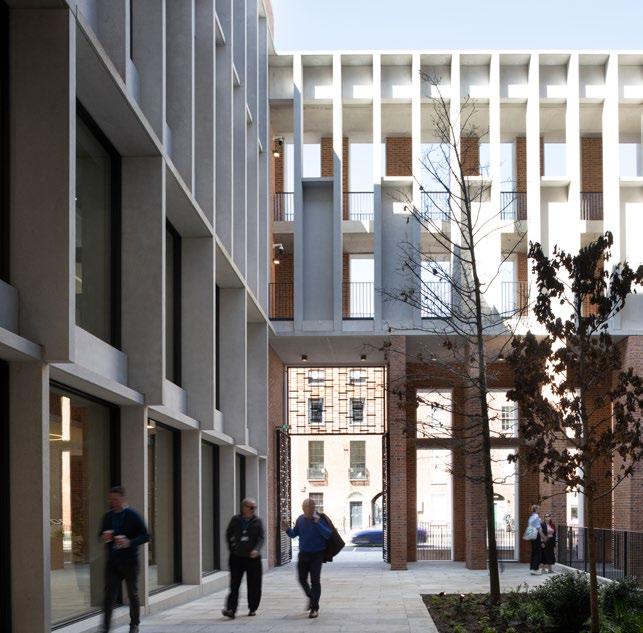
Sometimes a building comes along that asks challenging questions. Chris Croly, building services engineering director of BDP, describes one such example – a building designed to tackle the specific energy profile of offices, while trialling an innovative, dynamically-controlled approach to adaptive comfort.
Visionary vernacular
Passive inspired Dumfries home puts users first Can a low energy building be truly sustainable if it doesn’t fully consider its occupants needs? The latest offering from one of Scotland’s leading green designers uses passive house knowhow to signal the way to pragmatic, modest, occupantcentric architecture.
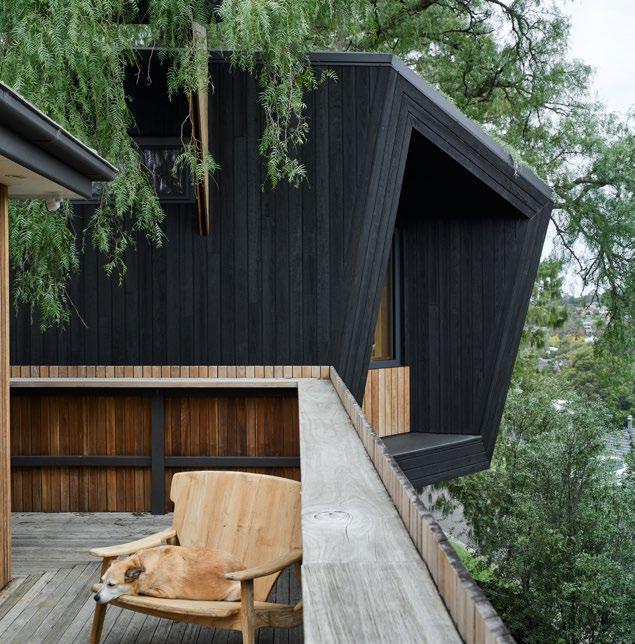

4 | passivehouseplus.ie | issue 44 CONTENTS PASSIVE HOUSE+
NEWS
10 20 32 20
10 32 COVER STORY 8 44
54 64
Military precision
West Country barn conversion brings low carbon comfort for army family
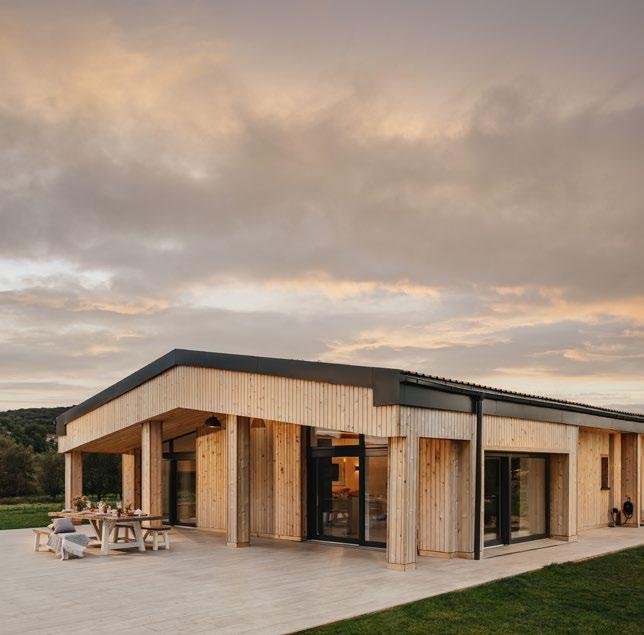
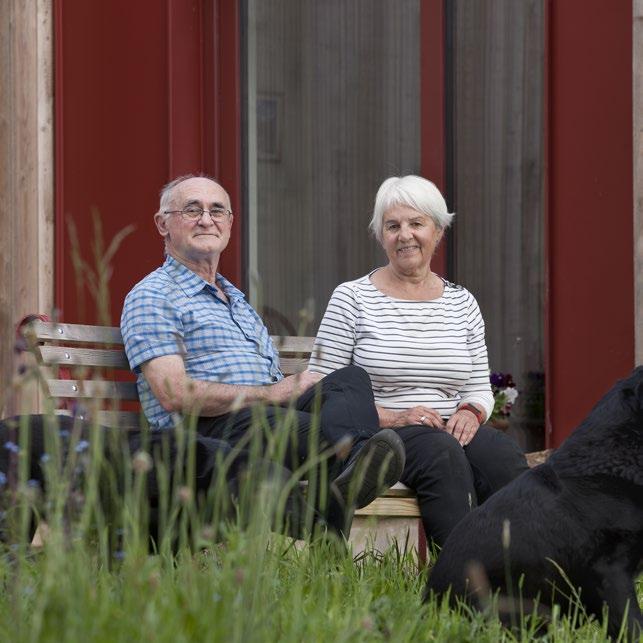
Designing a building to the passive house standard for the first time is one thing. But trying to do so when the client is a soldier, the design must accommodate the frame of a barn, and you’re straining to get it built precisely on schedule, during a pandemic, is quite another.
Modern love
1960s modernist gem gets Enerphit treatment
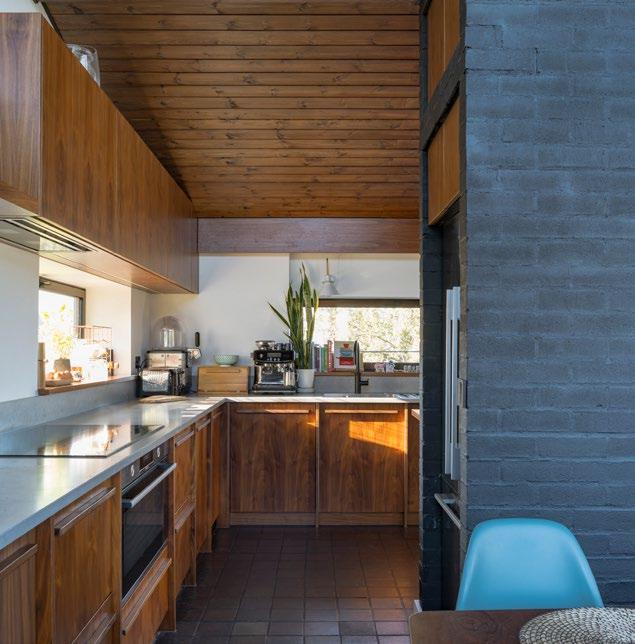
Where does the balance lie between conservation of buildings, energy and nature?
One deep retrofit to a London modernist house may point the way ahead, bringing light, form and avant garde energy performance to old ideas about contemporary living.
INSIGHT
Cold comfort
Are Ireland and the UK’s energy ratings predicated on cold homes?
Passive houses aside, attempts at low energy building have a long and inglorious history of using more energy than predicted, with a key reason being “comfort taking”, where occupants take back the benefit of energy efficiency by cranking up the thermostat. But is it rather that energy ratings are assuming miserly heating use –and temperatures that fail to meet the requirements of a new EN comfort standard?
MARKETPLACE
Keep up with the latest developments from some of the leading companies in sustainable building, including new product innovations, project updates and more.
What goes around comes around Why the history of refrigeration points to the future of heating
As efforts to decarbonise buildings gain pace, heat pumps powered by an increasingly clean grid are looking like an irresistible force. While reducing emissions from operational energy use rightly remains front and centre, embodied carbon is the next target – including the heat pump’s refrigerant. Toby Cambray goes back to refrigeration’s beginnings to find a route to a low carbon future.
ph+ | contents | 5 PASSIVE HOUSE+ CONTENTS ph+ | contents | 5 44 54 64
72 74 77


Paul Doran 1977-2023
ARTICLES BY OR ABOUT PAUL DORAN’S WORK
Several inspiring articles by Paul or about his work are available in the digital archive of Passive House Plus back issues at the following URL: https://tinyurl.com/digitalpassive
Issue 11: Why a passive house doesn’t cost extra, by Paul Doran

Issue 12: An award-winning Dublin Enerphit
Issue 15: An oak frame and SIPs passive house
Issue 19: A renovation which expertly balances period building restrictions with new build extension
Issue 32: A flat pack passive house.
Like so many in the Irish sustainable building community, I was shocked and saddened to learn of the tragic death in January of Paul Doran, one of the best and most forward-thinking builders I've ever encountered – a modest man who had a big impact.
Paul had recently moved to Australia with his wife Simonne and three children Vann, Lyra & Shay, to start a new life. Paul drowned on 18 January at Lennox Head in New South Wales, while together with Simonne, bravely saving their children. The family were enjoying an evening in the sea in shallow waters when conditions quickly changed, and they got into difficulty. Paul and Simonne quickly swung into action, getting their two boys Vann and Shay to shore, followed by their daughter Lyra. Tragically, Paul was caught in a riptide and didn’t make it.
The Dorans always struck me as a lovely family. I had the pleasure of meeting Simonne with Paul at the Green Awards a few years ago. The first time I met Paul was some years before, with his father Pat, at an Irish Green Building Council conference. While Paul had helped his father on construction projects from a young age, he had just come back into the industry at that stage – having left his career as a secondary school English and history teacher. It was immediately apparent he was no ordinary builder – his thirst for learning now focused on absorbing all he could about ways to deliver low energy, low impact buildings.
With Paul and Pat working together, Pat Doran Construction was a wonderful family
business, with a father who was the best type of old school builder, and a son bringing a new energy, and pushing his father to innovate. There was a great balance in this, with a seasoned pragmatism ensuring that any innovations which they took up had been thoroughly considered.
Paul, Pat and Simonne worked together to deliver some extraordinary buildings, including passive house and Enerphit projects, using a variety of approaches – anything from cavity wall and externally insulated masonry, to oak frame, structural insulated panels and an IKEA-style flat-pack timber-based build system. Paul's care, commitment, and genuine desire to deliver quality, low energy, green buildings was an example for the whole industry. The buildings he built, several of which we published, are an enduring testament to him.
One story sums up his diligence - an Enerphit project we published which Paul built, where the building services package wasn't included in the main contract. This was far from ideal, with an exacting airtightness target of 1 ACH to meet, and pipes, cables and duct penetrations flying in everywhere. Paul said he counted over two hundred penetrations in total. Yet his team patiently and methodically sealed them all, and they hit the airtightness target, against the odds.
Paul wrote for us on the cost of building to the passive house standard, which was key for us in successfully lobbying for new homes in Dún Laoghaire-Rathdown to be built to passive house or equivalent. As such his legacy won't just include the build-
ings he built. Without him, the likes of the 600-unit Shanganagh project - which will be Ireland's largest passive house projectwouldn't be happening.
I’d urge readers to go back to the articles we've published by him or about his work as early, inspirational examples showing that traditional Irish builders can do extraordinary things. People like Paul have shown the way - it's up to the whole industry now to follow suit.
Paul’s father Pat kindly agreed to provide a few words about Paul for this piece:
"I am really proud of my son Paul and everything he achieved, and to have been able to call him a colleague and friend. After working over 40 years in the business, Paul pushed me to try new things, and I learned so much from working with him as a result. His passion and drive for passive housing was evident in everything he did. It gives me gratitude to know he has influenced the sector in such a positive and meaningful way".
Paul will be sorely missed, but he has left a lasting legacy of buildings which the rest of the industry should aspire to emulate.
Donate
To donate and help support Paul’s young family through this unthinkably difficult time, visit https://tinyurl.com/ pauldoranRIP. •
Jeff Colley remembers Paul Doran, one of Ireland's foremost builders, who has tragically passed away.
8 | passivehouseplus.ie | issue 44 PAUL DORAN PASSIVE HOUSE+
A complete low energy solution for internal wall insulation
Suitable for traditional solid stone and brick walls, Retro EcoWall combines the breathable, insulating and sustainability benefits of natural materials to optimise thermal performance and manage moisture.
Diasen Diathonite Thermactive.037 Lime and cork insulating plaster

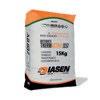
Gutex Thermoroom Adhesive Adhesive mortar for Thermoroom
Gutex Thermoroom Natural wood fibre insulation boards


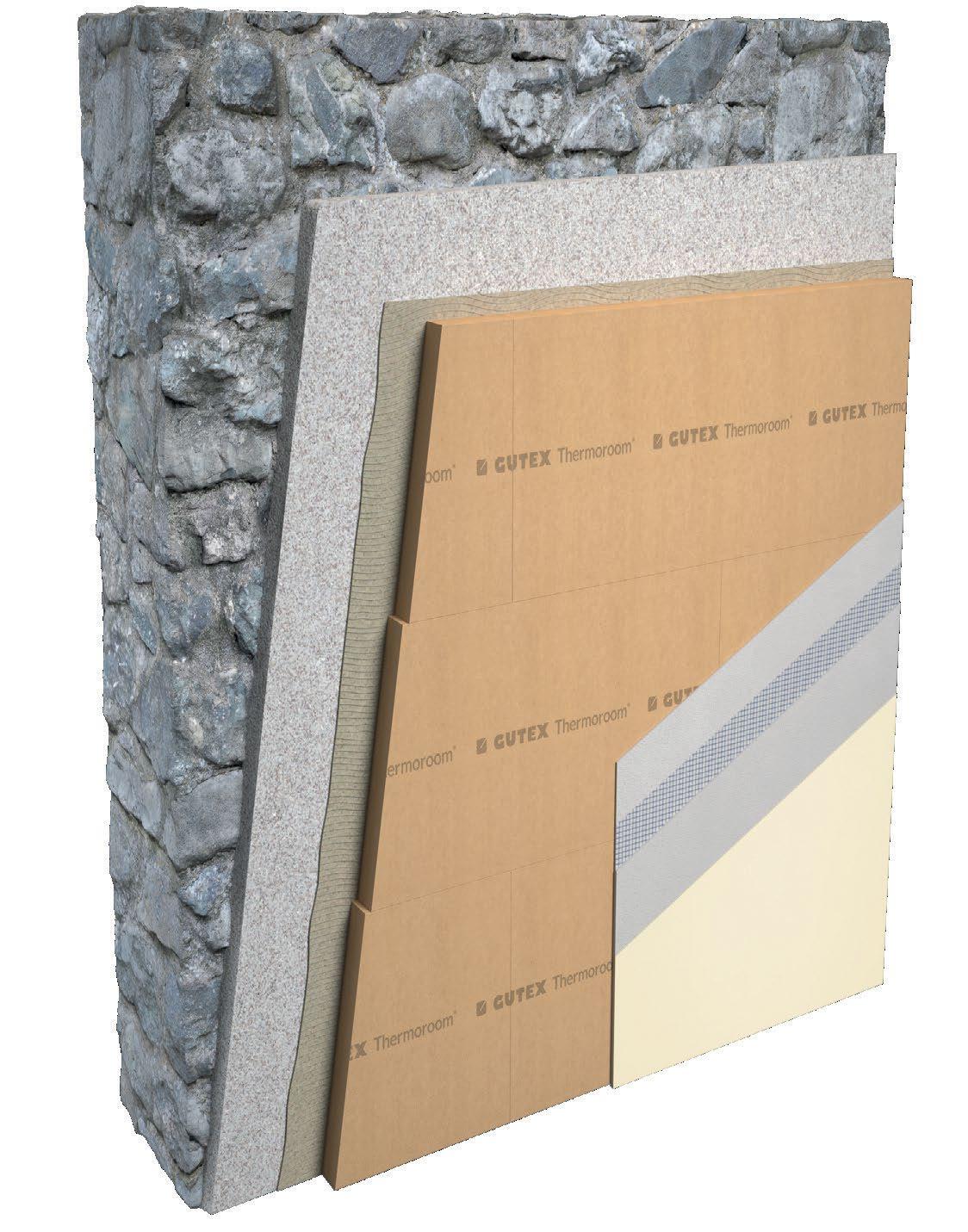
Lime Green Solo One coat lime finishing plaster

Reinforcing Mesh Embedded within Lime Green Solo
Auro Natural Paint Breathable natural paint
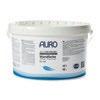
Discover our solutions online at ecologicalbuilding systems.com
1 2 3 4 5 6
1 2 3 4 5 6
BIG PICTURE
PASSIVE & ECO BUILDS FROM AROUND THE WORLD
While genuine efforts to address aspects of sustainability are becoming common in construction projects, all too often those efforts remain couched in an oil age mindset – typified by the likes of a remotely located passive house McMansion with two SUVs in the driveway.
But sometimes a building comes along where, rather than feeling incongruous, energy targets like passive house are manifestly functioning as part of a well-rounded conception of sustainability, using resources sparingly to deliver a home that is at once modest and delightful – a blueprint for an architecture fit for the Anthropocene.
Hamish Bresnahan of Alexander Symes Architect explains the practice’s work on one such project: Pepper Tree Passive House
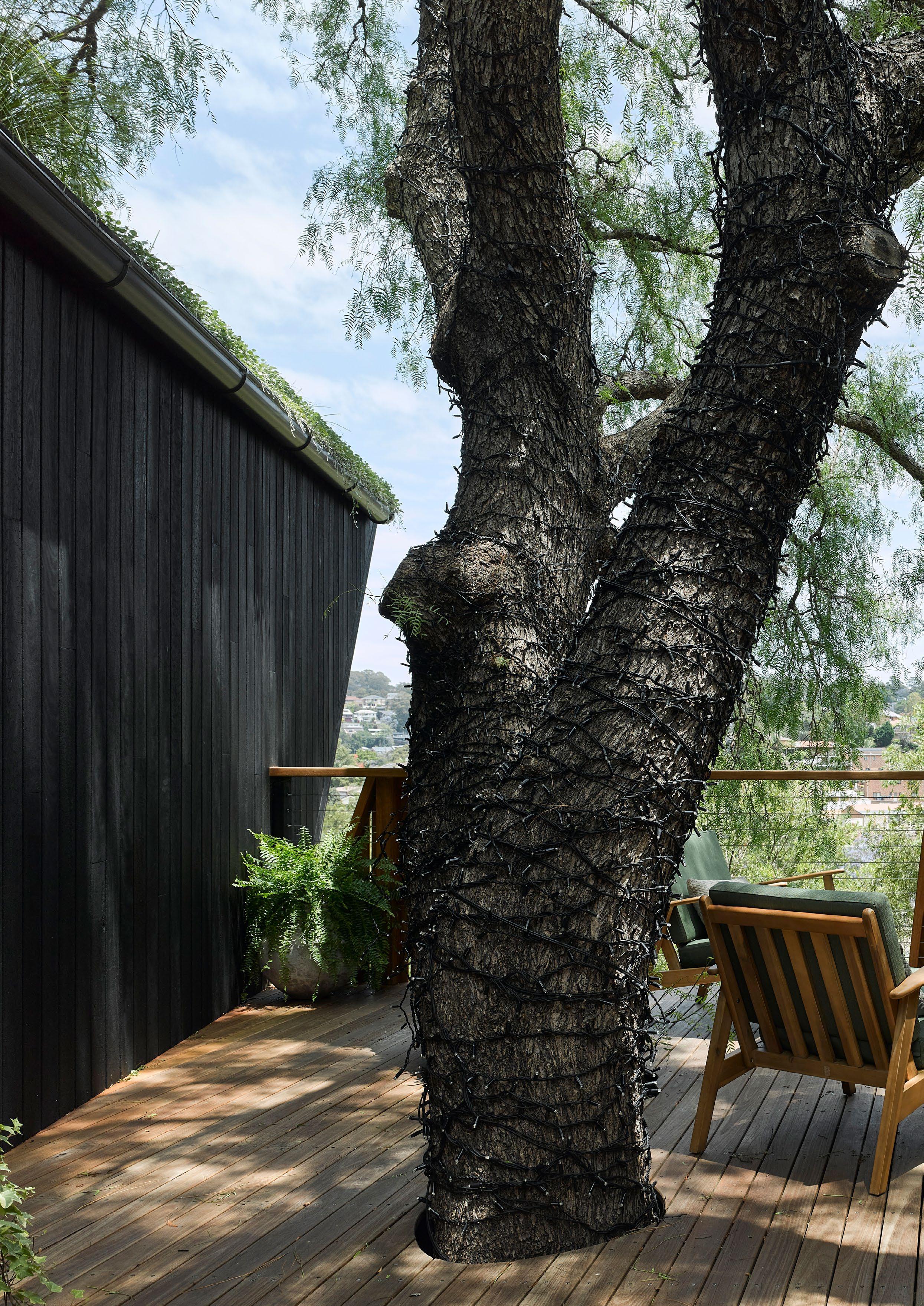
1. Introducing Pepper Tree Passive House

Pepper Tree Passive House is a small secondary dwelling, attached to a young family’s home in the Australian Illawarra region, perched on a steep site and elevated into the canopy of the site’s 60-year-old pepper tree. Built to the passive house standard, sustainability is at the core ethos of the project – embodied between the natural material palette, high performance design and strong biophilic connection.
The ambition of this project was to do more with less. While light touches to the existing home were made to improve its thermal performance, building the new secondary dwelling to the passive house standard has created a future proofed refuge to escape to in future peak temperature days.
11
2. An ambitious upgrade
Adam Souter approached Alexander Symes Architect with the ambitious project, looking to upgrade his family’s Unanderra home as well as use the opportunity to showcase the technical expertise of his emerging construction firm, Souter Built.
Adam is passionate about the future of sustainable housing in Australia, trying to implement sustainable change to the way we build, one house at a time. A certified passive house tradesperson, Adam and his partner Ame Rooke-Jones wanted to create a sustainable, healthy space to raise their three kids.
3. Preserving nature
From the outset, the intention of the additions to the home was to protect the pepper tree and explore the potential of high performance, future-proofed technologies that are respectful of our natural environment and a step towards regenerative architecture.
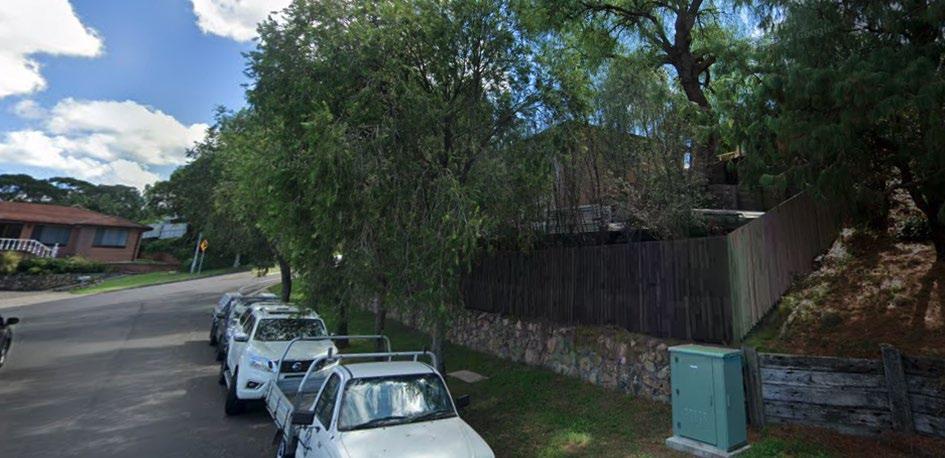
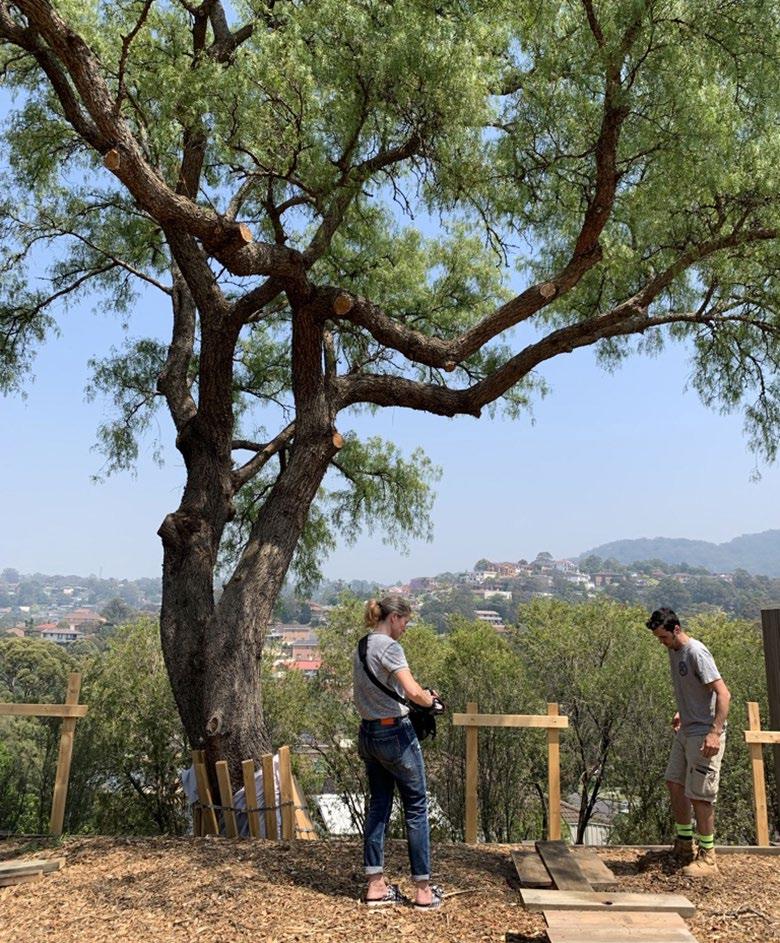
PEPPER TREE BIG PICTURE 12 | passivehouseplus.ie | issue 44
4. Work / life balance
The brief was developed to envision the secondary dwelling as a 24-hour space; used as a home office by the family’s growing business during the day, and a short-term stay cabin at night that would give visitors an experience of the higher quality of space that the passive house standard affords, all while creating a future-proofed studio with western views to Mount Kembla and the treetops outside. Pepper Tree Passive House gives the clients a perfect space to work while being able to create a distinct separation between work and home life, without the lengthy commutes and empty building hours experienced in a traditional workplace model.
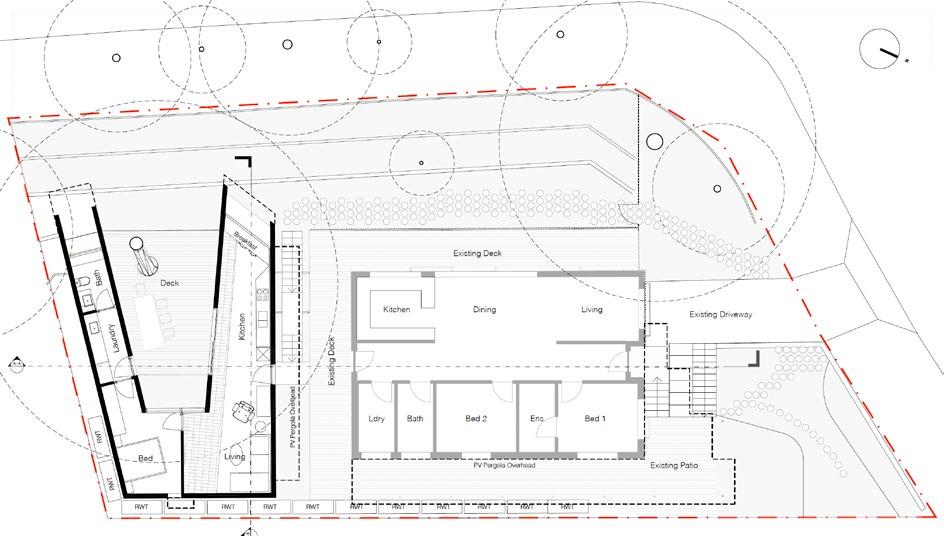

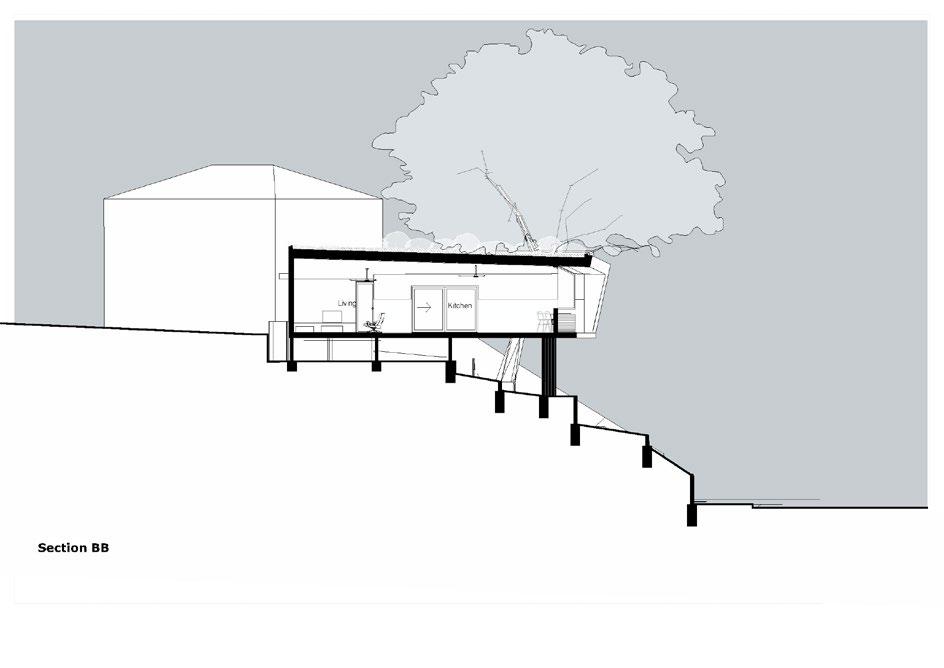
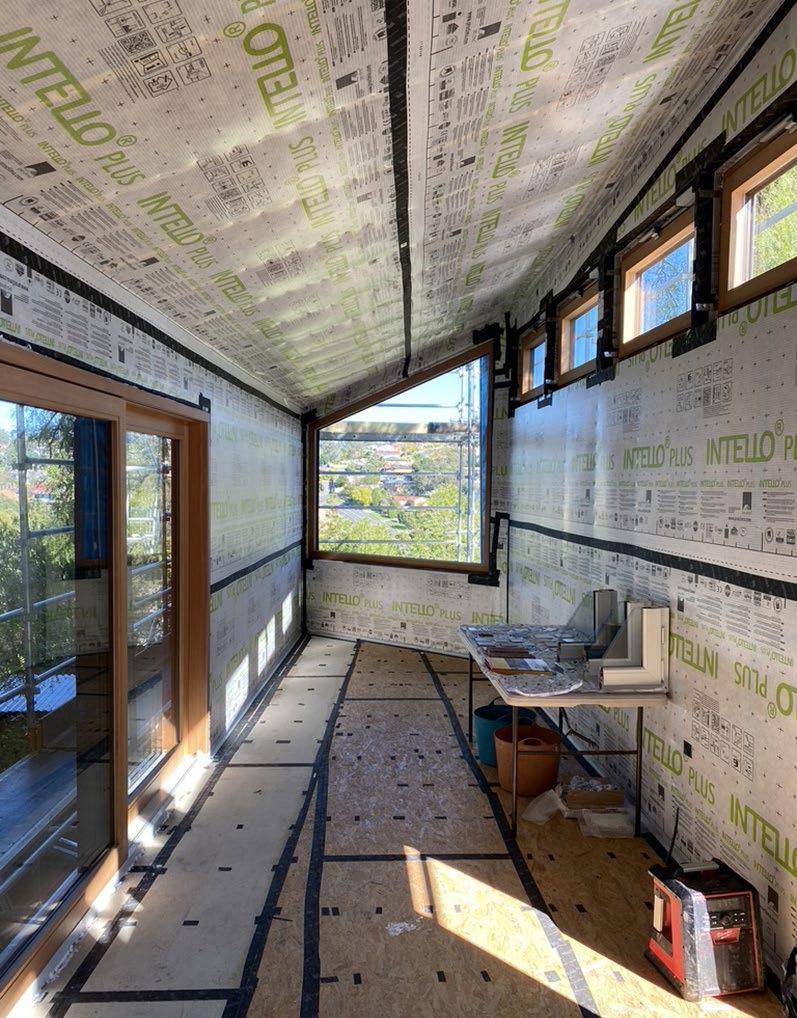
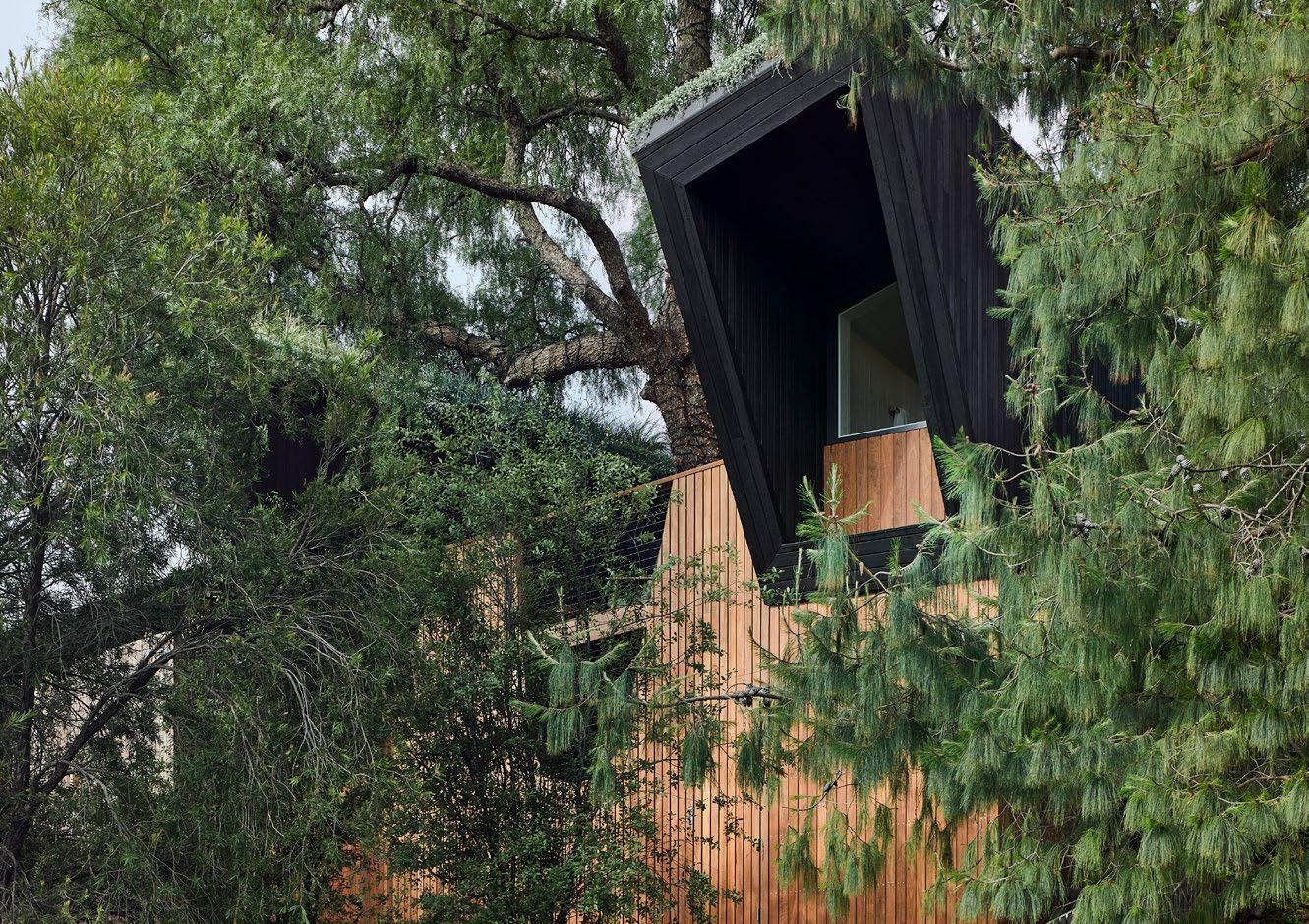
5. Year-round views
The west-facing views over the suburb’s tree canopy toward Mount Kembla are one of the key elements of the site. The timber alu clad triple-glazed full height windows ensure that these views are enjoyed year-round without the significant compromises to thermal comfort that would be experienced with a typical window system, thanks to the harsh western afternoon sun of the local climate.
Subservient to the existing pepper tree, the U-shaped form of the new building creates a high ratio of external envelope to internal volume which proved difficult to achieve airtightness, especially given the project was Souter Built’s first passive house project. They succeeded though, achieving 0.51 ACH @50 Pa on the final blower door test.
ph+ | pepper tree big picture | 13 BIG PICTURE PEPPER TREE
Photos: Barton Taylor
Section BB
Section AA
6. Seeking approval
There was an extensive coordination process with the local council, because of the unique form and building makeup that isn’t commensurate with standard secondary dwellings.
Under current legislation, the size of secondary dwellings is measured to the external wall finishes. Although the detached studio is under 60 sqm in internal floor space, there was great difficulty in getting the council to approve the proposed works as the highly insulated walls meant that they were thicker than a standard build, thereby increasing the perceived footprint. This is something that architect Alexander Symes still believes needs addressing, as the current legislation punishes higher performing building envelopes.
7. Subtle upgrades
Although the clients were also looking to upgrade their Illawarra home, the existing house functioned well for their needs already.
Instead of extensive alterations and additions, light touches were made to the existing home to upgrade its thermal performance – including new external insulation and timber cladding, repainting the existing concrete tiles lighter to reduce heat gain and the addition of a 12 kW building-integrated photovoltaic pergola.
Wrap around decks were added to the existing home to strengthen its ability to connect with the gardens, and improve the usability of the entire site. New recycled timber fencing to the front garden provided space for chickens and an edible garden.


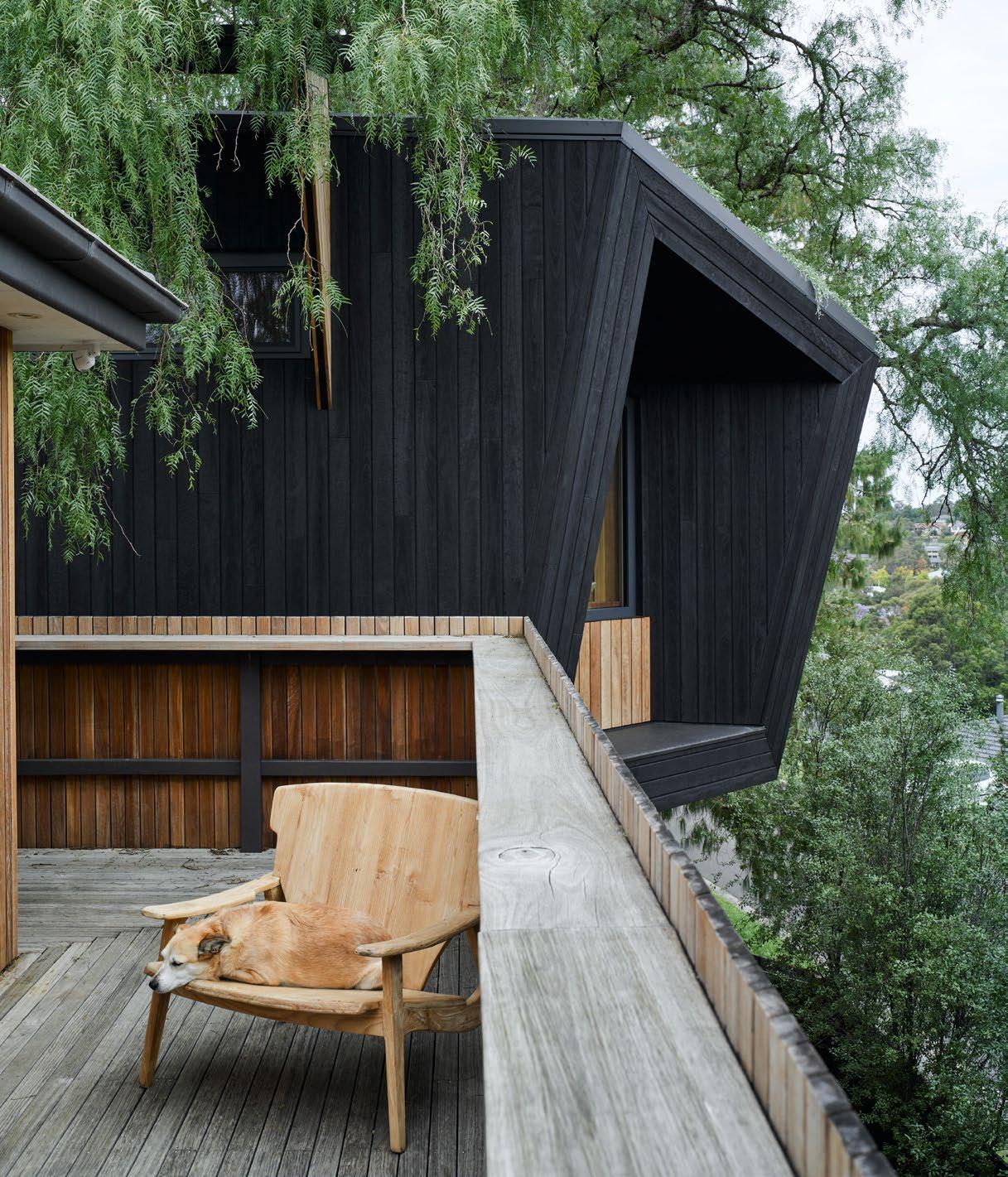
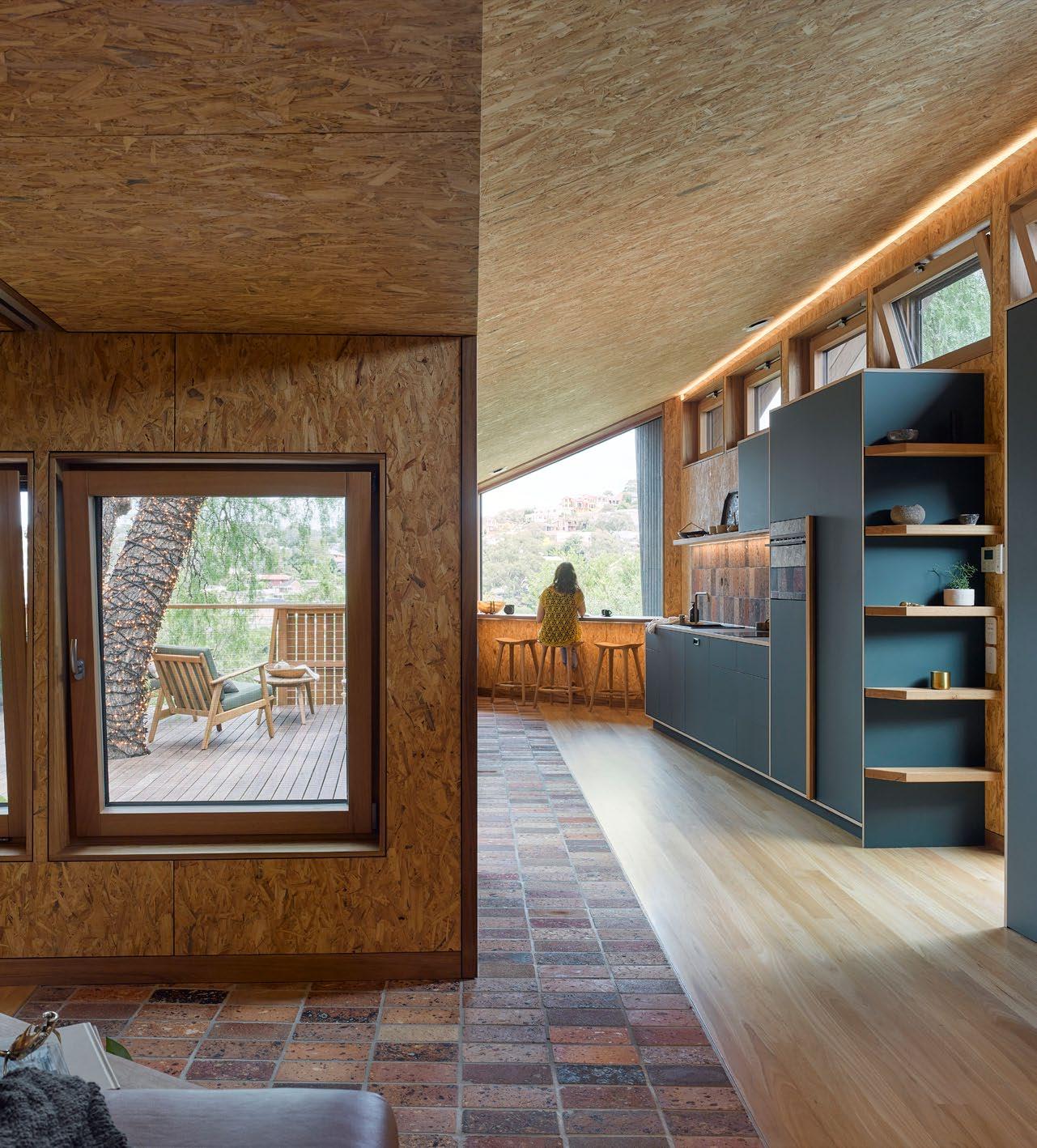
PEPPER TREE BIG PICTURE 14 | passivehouseplus.ie | issue 44
NORDAN WINDOWS & DOORS
With secured by design accreditation and weather performance far exceeding the standard, it’s clear that no one can like NorDan can. Visit our showrooms in Cork, Dublin or Galway to experience the NorDan difference first hand www.nordan.ie

ph+ | pepper tree big picture | 15 PEPPER TREE 38 North Point Business Park, New Mallow Rd, Cork City Bluebell Industrial estate, Bluebell, Dublin Sustainable Design, Energy Efficient, and Virtually Zero Maintenance 56b Briarhill Business Park, Briarhill, Galway
8. Celebrating the natural environment
From the project’s outset it was critical for the design to use both materials and landscaping in a way that strengthened the biophilic connection to the pepper tree, as well as regenerate the biodiversity of the site. Despite the small building footprint, it was critical to the project’s success that the site’s natural environment was dis-

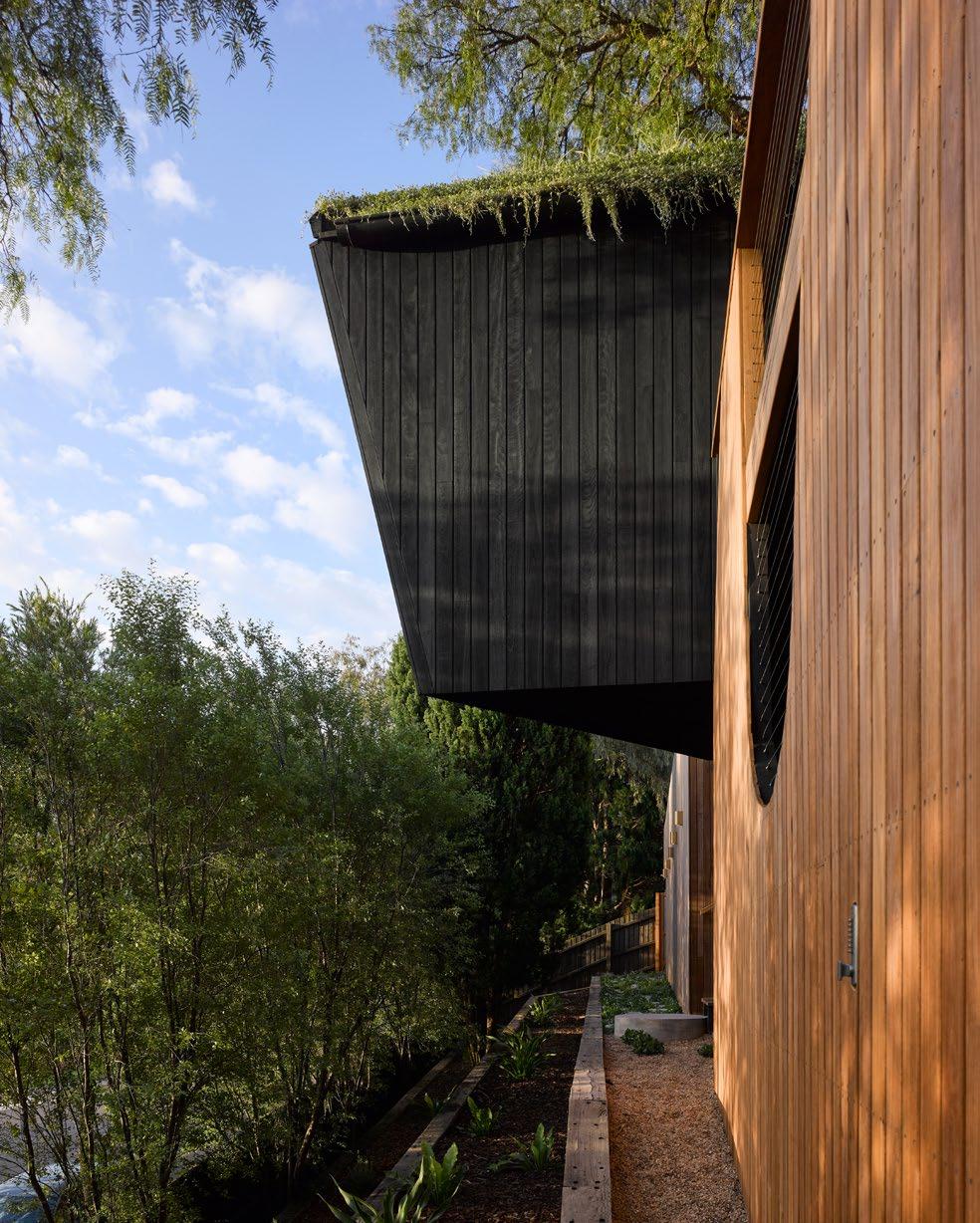
turbed as little as possible.
The building’s two cantilevered wings each host an extensive roof garden, filled with a variety of drought tolerant native plants, collecting excess rainwater to be used in the dwelling, and helping to blend the building into the site.
The choice of charred Shou Sugi Ban
timber cladding behind the existing street trees adds to this effect, while removing the need for ongoing maintenance over the material’s lifecycle. Internally, timber products with non-VOC finishes were used, reducing total embodied energy while still providing a warm material palette.
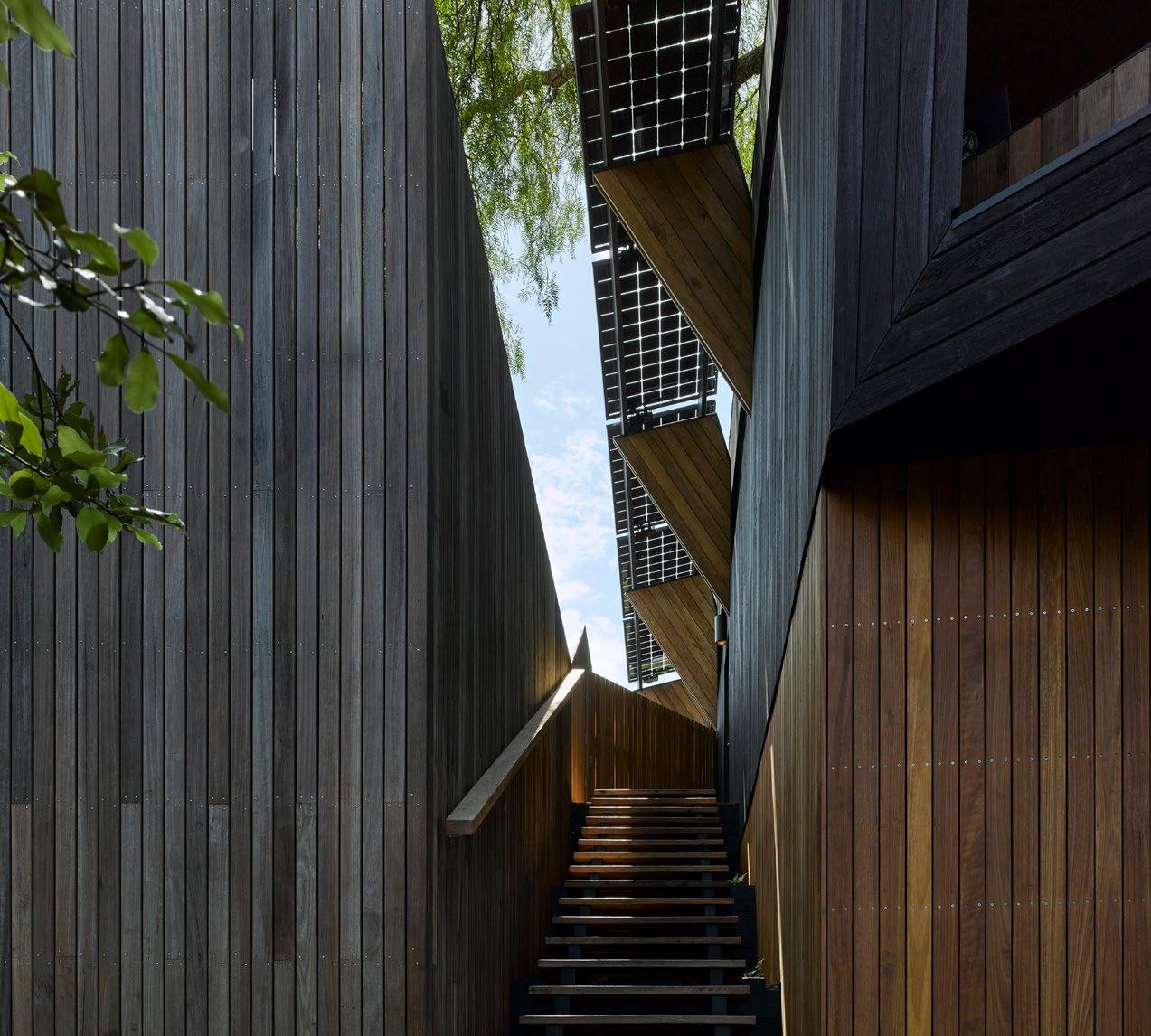
9. Reclaimed materials
To reduce the amount of new materials used and total embodied energy of the project, Adam constantly saved materials that otherwise would have gone to waste as part of the work of Souter Built, stockpiling a catalogue of reclaimed materials to be used on the project.
Adam’s constant innovation in holistic material approach is exemplified throughout this project, such as salvaging the structural timber from the demolition of a 100-year-old home in Bondi (which became Pepper Tree Passive House’s external staircase) as well as ensuring all leftovers from Souter Built’s concrete pours of the last few years were poured into empty buckets (which became the external pavers for Pepper Tree Passive House).
PEPPER TREE BIG PICTURE 16 | passivehouseplus.ie | issue 44
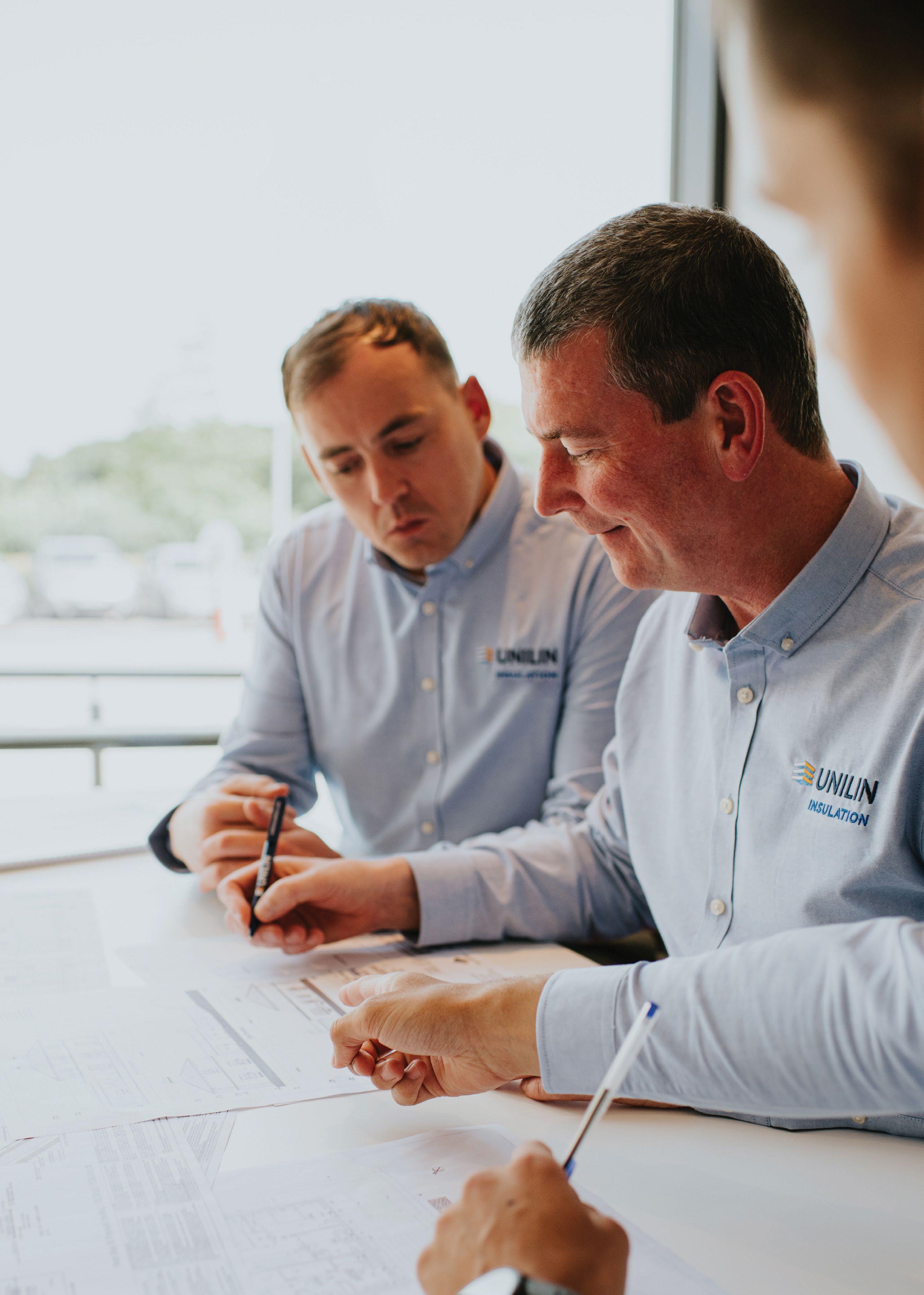
10. Form and function
The northern wing houses the living, office and kitchen spaces with a breakfast bar, carefully framing a view of Mount Kembla. Recycled sandstock bricks line the floor and wall area where direct sunlight from the northern highlight windows projects during winter, acting as a thermal battery.
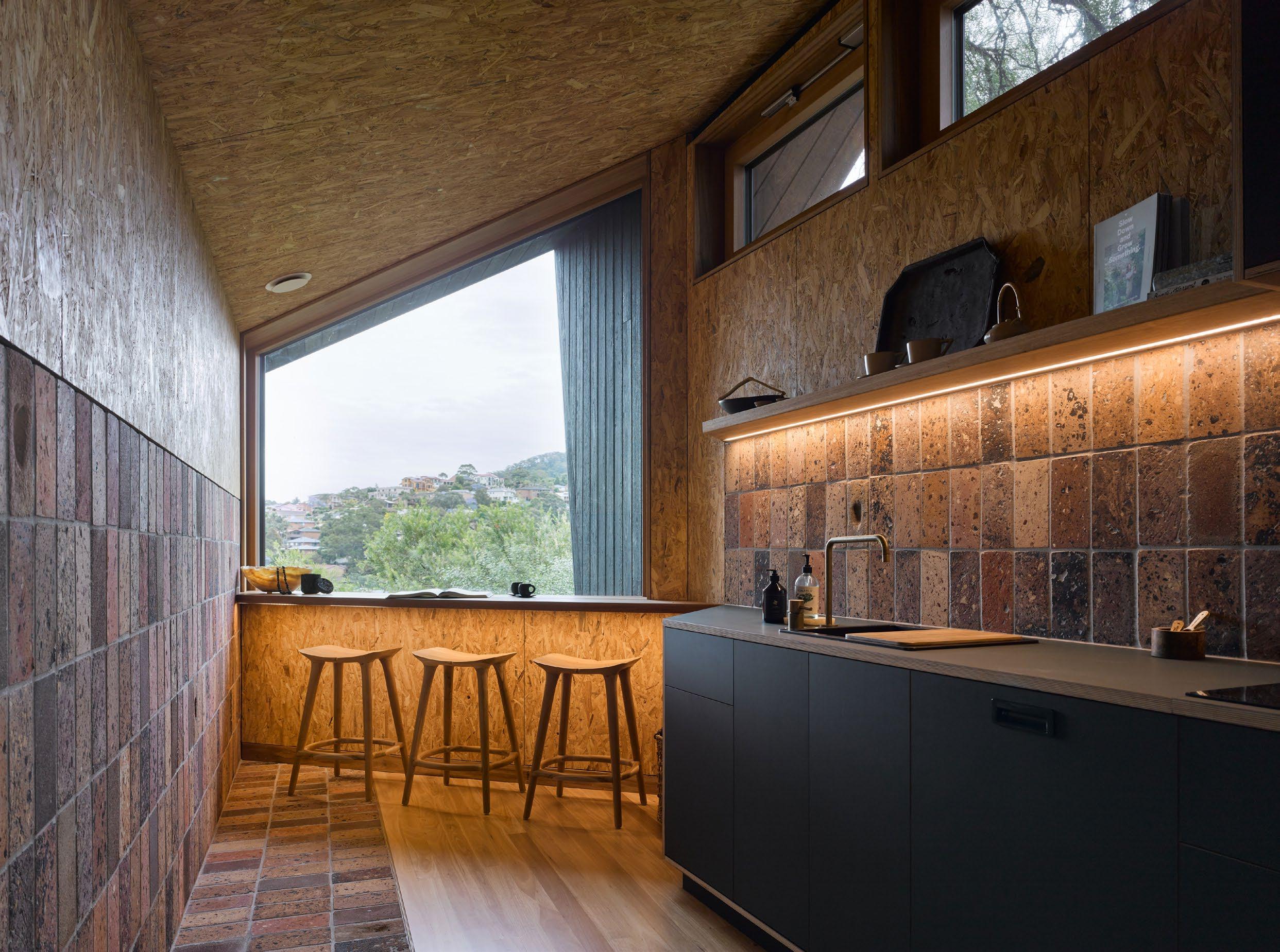
The more private southern wing contains the bedroom, laundry and bathroom, ensuring the total volume of the building is only as big as it needs to be to protect the existing pepper tree. The floating deck between the two wings has been carefully scribed around the pepper tree, providing a meditative retreat immersed in the tree canopy.
11. Performs as designed
A life-cycle assessment was conducted that showed despite the higher amount of embodied energy associated with passive house construction, due to the small, high performance building envelope, low-embodied carbon material selection and significant on-site generated & exported renewable energy, the building’s environmental footprint is 64 per cent less than a comparable built-as-usual home in the same climate zone.
The use of Shou Sugi Ban recycled hardwood cladding means that no re-oiling of the timber is required, and protects the timber from pests and rot.
Between the passive house standard and the 12 kW photovoltaic system installed, the whole home uses 94 per cent less grid energy than a comparable five-person home in the same climate zone. This ensures the young family has energy security, and is not susceptible to grid electricity market increases. The home will also be a bastion against unpredictable future climate peaks – during the recent cold snap the space was a comfortable 20 C internally while outdoor temperatures were below 1 C (without using any internal heating).

18 | passivehouseplus.ie | issue 44


EU votes through EPBD recast
Changes include embodied carbon, zero emission buildings and minimum energy standards
The EU is set to introduce imminent minimum energy performance standards for existing buildings, among several changes in a recast to the Energy Performance of Buildings Directive (EPBD). The proposed recast also includes a zero-emission new build standard, mandatory whole life carbon calculation and targets, indoor environmental quality requirements and building renovation passports, among other measures.
On 14 March, the European Parliament voted through proposals to overhaul the directive, including a requirement for whole life carbon (WLC) calculation for new buildings by 2027, followed by WLC targets from 2030. Whole life carbon takes account of the embodied carbon required to construct, maintain and dispose of a building, along with carbon emissions from operational energy use across its lifespan. The directive frames this in terms of the life-cycle global warming potential (GWP) of the building.
Minimum energy performance standards based on harmonised energy performance classes are set to be introduced to phase-out the worst-performing buildings and prompt the continuous improvement of Europe’s building stock, targeting the EU’s longterm goal of a decarbonised building stock by 2050. Member states will be required to introduce building renovation passports to help facilitate this change.
The proposals include a major overhaul of how the energy performance of buildings is calculated, with implications for national calculation methodologies such as Ireland’s DEAP and iSBEM and associated Building Energy Rating scale. Member states will be required to set the energy performance of
buildings on an A to G scale, and to define the G band to align with the worst-performing 15 per cent of the national building stock. Excluding exemptions, all non-residential buildings will be required to reach D class by 2030, followed by residential buildings by 2033. Energy performance certificates with a D class or lower will only have a fiveyear validity.
Exemptions will be made for conservation and heritage buildings, although the EU plans to set technical guidelines to enable the renovation of these buildings while maintaining cultural value.
The proposals will require member states to ensure that the life-cycle GWP of new buildings is disclosed through energy performance certificates by 1 January 2027.
All new buildings will be required to meet a new “zero-emission building” standard by 1 January 2028, with new buildings “operated, occupied or owned by public authorities” required to be zero-emission buildings by 1 January 2026.
The proposed changes also require member states to set “optimal indoor environmental quality levels, including air quality, thermal comfort, [and] a high capacity to mitigate and adapt to climate change through, inter alia, green infrastructure”, within two years of the proposed directive coming into force.
While the text includes proposals for member states to ban fossil fuel heating systems in new buildings from the date of transposition of the directive, this proposal comes with a significant caveat in the statement that “hybrid heating systems, boilers certified to run on renewable fuels and other technical building systems not exclusively
using fossil fuels […] shall not be considered to be fossil heating systems”, a move which may create a gap for hydrogen and fuels such as hydrotreated vegetable oil (HVO).
At the Plenary session in Strasbourg on 14 March, the European Parliament adopted its position on the directive. “A compelling case for the renovation of buildings,” exclaimed Dublin MEP Ciaran Cuffe, lead rapporteur on the directive.
“The Parliament vote is an important step in the right direction to cutting Europe’s addiction to imported fossil fuels,” explained Adrian Joyce, Renovate Europe campaign director. “The buildings directive is the opportunity to translate the political discourse on slashing energy imports into tangible action.”
The parliament’s position also facilitates new instruments to mobilise finance for renovation in order to support homeowners with renovations (such as mortgage portfolio standards) in addition to significant EU funding already available for renovation. With a stubbornly low renovate rate across the EU at only 1 per cent, and a highly fragmented sector with over 95 per cent SMEs, setting a clear regulatory framework with the EPBD could have a transformative effect in delivering the EU’s Renovation Wave, for the benefit of citizens and businesses, and for the planet.
All eyes are now on the trilogue discussions, and especially on the European Council, where member states will also have to demonstrate their commitment to delivering a sustainable long-term solution to Europe’s energy crisis. •
Solar panels to receive VAT drop in aim to boost uptake
In a bid to increase the uptake of solar technology in Ireland as families and businesses continue to negotiate the energy and cost of living challenges, the Irish government has announced they intend to drop the VAT rate on the supply and installation of solar panels to zero.
The Department estimates that if this VAT rate cut is passed onto consumers, the average solar installation cost should fall from €9,000 to €8,000, at a cost of €19m
to the exchequer. They further estimate that this will reduce the payback period for installation from 7 to 6.2 years.
Minister for Finance Michael McGrath said he believes the significant reduction in the installation cost “will encourage more people to avail of this innovative technology.”
Minister for the Environment, Climate and Communications Eamon Ryan said that, along with removing planning require-
ments to install solar panels on residential homes, “this move… is yet another step on Ireland’s journey to cleaner, cheaper, renewable energy.”
Department figures indicate that currently over 50,000 Irish homes have solar panels with 17,000 installations in just the last year. “This is expected to increase further as prices come down and solar becomes more mainstream,” said Minister Ryan. •
20 | passivehouseplus.ie | issue 44 NEWS PASSIVE HOUSE+ NEWS
Passive house isn’t just about efficiency – it’s about social justice
The potential of the passive house standard to change the world isn’t restricted to tackling climate change – it’s about social justice too.
Speaking at the 26th International Passive House Conference in Wiesbaden, Passive House Plus reporter Kate de Selincourt spoke about the role of highly energy efficient buildings in enabling lower-income communities to live in a healthy environment. "So much of the passive house is about health and well-being," said de Selincourt, who had researched the human consequences of the energy crisis in the Cold Proof series of articles in issue 43 of Passive House Plus.
De Selincourt told the conference that a growing number of British people are unable to heat their homes properly. Low-income families and elderly people have been living in winter in cold and damp buildings with room temperatures of 15 C – and sometimes even below 10 C, leading to enormous suffering and health threats. De Selincourt also told the audience about the gratitude of residents when they move into homes that meet the passive house standard. "The heat stays in the house for a long time, and the demand for heating energy is generally low. The whole lives of these people are changed," de Selincourt said. A separate series of lectures was devoted to the topic of social housing, with projects from around the world.
The conference covered other benefits of passive house projects, such as delivering good indoor air quality in buildings with vulnerable occupants such as schools and health care buildings, and protecting the power grid against overloading.
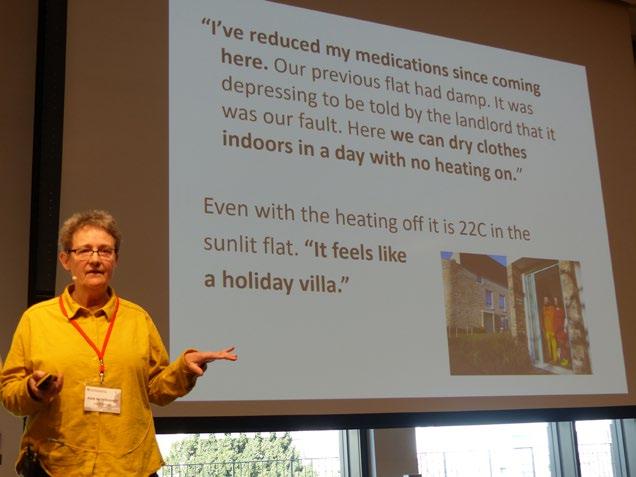
Around 600 international participants attended the three-day conference, which was held in Wiesbaden and online. Excursions took visitors to impressive projects such as the passive house district Bahnstadt Heidelberg and the first certified passive house hospital in Frankfurt.
"It is motivating to see that a high level of energy efficiency is having a ripple effect around the world. Here we have heard about impressive large projects, also in the area of energy retrofits, which are changing lives for the better for inhabitants in the long term," said Jan Steiger, member of the management board of the Passive House Institute.
Nora Steurer of the Global Alliance for
Buildings and Construction (GlobalABC), a network associated with the United Nations, pointed out that global CO2 emissions in the building and construction sector rose by five per cent in 2021 compared with the previous year. The decarbonisation of this sector must therefore be "enormously accelerated." This requires a structural change, according to Steurer. Passive House Institute founder Prof Wolfgang Feist and director Dr Benjamin Krick highlighted the urgency of the conference’s theme, Efficiency NOW! "Unless the heating demand of buildings is reduced, the power grid won't suffice if the majority of our buildings are equipped with heat pumps", explained Krick.
Delegates also learned of Enerphit retrofit projects in Germany, Ireland, Spain, Poland and Denmark, and large scale projects such as the 18-storey Ken Soble Tower in Hamilton, Canada, which is providing 146 healthy and affordable apartments with low energy costs to the predominantly elderly residents. In northern Mexico, where summer temperatures can reach 52 C, one project provided crucial information on the feasibility and cost-effectiveness of Enerphit retrofits in emerging economies. A workshop on the EU outPHit project focused on large-scale and fail-safe deep retrofits using prefabricated components. Municipalities were invited to attend a workshop specifically tailored to their needs, which also presented the outPHit concepts for quality assurance in retrofits to the Enerphit standard. •
Government supported almost 27,200 home energy upgrades through SEAI in 2022
In the first of planned quarterly updates on the government funded SEAI grant schemes, Environment minister Eamonn Ryan and the Sustainable Energy Authority of Ireland (SEAI) have announced that almost 27,200 energy upgrades were completed in 2022, up 80 per cent on 2021, while applications are up 140 per cent. Expenditure was €188m, an increase of 90 per cent on the previous year.
Of these upgrades, 4,438 were fully funded retrofits for low-income households, up 85 per cent year on year. 8,481 homes were upgraded to a targeted B2, with 12 One Stop Shop service providers commencing operations.
Minister Ryan said “the message from the most recent IPCC report on climate is clear. We need to go further and faster in tackling climate change… We have everything to gain by ramping up year on year – better homes, cheaper bills and less use of polluting and climate damaging fossil fuels.”
Dr Ciaran Byrne, Director of National Retrofit at SEAI said “for much of the year, there was an unmet demand for home energy upgrades. The One Stop Shop and contractor base is continuing to scale up to meet this burgeoning demand. Construction sector inflation and material supply chain constraints are likely to remain significant risks in the medium term.”
The Climate Action Plan target is to upgrade 500,000 homes to BER B2 or better by 2030. •
ph+ | news | 21 PASSIVE HOUSE+ NEWS
(above) Passive House Plus reporter Kate De Selincourt spoke at the 26th International Passive House Conference about the human consequences of the energy crisis – and how the passive house standard can help.
WorldGBC launches green building policy principles for governments
The World Green Building Council (WorldGBC) has launched a set of principles aimed at guiding national governments to develop effective building policies and programmes to accelerate a decarbonised future.
The principles, developed by WorldGBC with its network of 75+ green building councils, were released ahead of the G7 ministers’ meeting on climate, energy and environment on 15–16 April, and take into account sobering analysis from the latest Intergovernmental Panel on Climate Change (IPCC) report, and the conclusion that there is a rapidly closing window of opportunity to implement policies that will keep the world within the 1.5 C warming limit.
Many of the priority topics for the G7 ministers meeting can be addressed by buildings — from achieving both energy security and net zero, to advancing the transition to circular economies. Worldwide, buildings are responsible for 37 per cent of energy-related carbon emissions and 34 per cent of energy demand. With such a significant environmental and carbon impact, leaders and policymakers must recognise the built environment as a key agent of change to close the 1.5 C gap.
WorldGBC and its network have launched “Global Policy Principles for a
Sustainable Built Environment”, to support policymakers around the world to adopt a holistic approach to built environment sustainability, and ensure that new and updated policies and legislations deliver the transformative action needed to reach the Paris Agreement and the UN’s Sustainable Development Goals.
The principles are structured around seven key focus areas: carbon, resilience, circularity, water, biodiversity, health, equity and access. These areas are supported by detailed policy levers to show how they can be effectively implemented through regulation, information and incentives. Despite being the largest contributing sector to carbon emissions, the building and construction industry is still not on track to achieve total decarbonisation by 2050, meaning the gap between actual climate performance of the sector and its pathway to decarbonisation is widening.
This creates a dual challenge for the built environment — with markets in Asia and Africa expecting their building stock to double by mid-century. Meanwhile other regions are grappling with the challenges of renovating energy inefficient buildings. Cristina Gamboa, CEO, WorldGBC, said: “Our sector is in a strong position to deliver resilient development that integrates
mitigation and adaptation measures, whilst also addressing other pressing societal issues, including energy security, resilience, health and equity. In this global stocktake of the Paris Agreement year, and ahead of countries submitting updated nationally determined contributions (NDCs) in 2024, it is crucial that political leaders take bold actions to strengthen and implement building policies that deliver transformative change.”
By supporting the delivery of these principles, governments will be sending a clear signal to the market that decarbonised built environments are a priority, therefore enabling industry to deliver more innovative solutions. But governments must take a holistic approach, embracing public funding and influencing financial investment decisions and tools that consider carbon mitigation, resilience and green buildings.
WorldGBC and its green building council network invite governments to use “Global Policy Principles for a Sustainable Built Environment” as a tool to review and update existing legislation; as well as offering their support within a local and global context.
Download the report here: https://tinyurl. com/WorldGBCreport. •
Must listen: Zero Ambitions Podcast
Over the past two years Passive House Plus editor Jeff Colley has been moonlighting as co-host of Zero Ambitions, a weekly podcast that wrestles with the challenge of how to deliver the scale and ambition of decarbonisation and sustainability in buildings required to avoid a hellish future. The focus is very much on keeping listeners engaged and informed – with a necessary dose of gallows humour.
Jeff’s co-hosts are user experience experts Alex Blondin and Dan Hyde (co-founder of Passive House Plus’s progenitor, Construct Ireland), who help to ensure the podcast couches the technical minutiae that Jeff loves in a manner that might chime with different
kinds of users – designers, tradespeople, policymakers and building users.
Some recent highlights:
• Learning from our mistakes: looking back at ten retrofits, ten years later, with retrofit pioneer Marion Baeli (PDP, Passivhaus Trust)
• Systems design for passive houses, radon research as a proxy for ventilation, and some further education. With Dr. Barry McCarron (PHAI, CREST)
• Passive house can lead to more than just houses: community engagement, control pathologies, and propagating systemic change. With Helena Fitzgerald (Department of Economics at the University of Limerick)
• Unconventional approaches to space heating: infra-red, ceramics, and the necessity for good design. With John Morehead (Wain Morehead Architects)
• EPCs are just a ritual (pt. 1): fundamental flaws in how we assess energy performance and how we got here, with Adrian Leaman and Bill Bordass (UsableBuildings.co.uk)
• Retrofit, energy ratings, and improving Europe's energy performance, with Ciarán Cuffe MEP
The podcast is available wherever you listen to podcasts. But you can find all ninety-five episodes here: https://tinyurl. com/zeroambitionspod. •
22 | passivehouseplus.ie | issue 44 NEWS PASSIVE HOUSE+
Scotland to mandate passive house for new homes
Scotland’s minister for zero carbon buildings is proposing to make the passive house standard, or a new Scottish equivalent, the minimum energy efficiency standard for new build homes from the end of 2024.
It follows Alex Rowley MSP’s proposal last year for a Domestic Building Environmental Standards Bill, which aimed to introduce the passive house standard into Scottish law, and which received support from across the political spectrum.
The Scottish government has now said it will give effect to the proposal through its own legislation by the end of 2024. Patrick Harvie MSP, Scotland’s minister for zero carbon buildings and a Scottish Green Party MSP for Glasgow, said: “I look forward to working with Mr Rowley – and with colleagues across parliament – to continue supporting improvements and enhancements to energy and environmental standards across our new housing stock, and delivering our vision to make all homes in Scotland warmer, greener and cheaper to run.”
The Green Party in Scotland supports the SNP-led government through a power sharing deal. The shared policy programme between the two parties, published in September 2021, expressed “explicit support for passivhaus and equivalent standards” and says that all buildings that apply for a building warrant from 2024 onwards must use “zero emissions heating as the primary heating source and meet significantly higher
energy efficiency standards”.
Passive House Plus understands that Alex Rowley, a member of Scottish Labour, will be involved in the drafting of the bill, and that the Passivhaus Trust has also been consulted.
A consultation on Mr Rowley’s proposal last year received 629 responses, with 80 per cent being fully supportive, 13 per cent partially supportive and only six per cent opposed.
“A move to the Passivhaus ‘gold standard’ for all new-build homes would be radical, ambitious, practical and forward-thinking,” Rowley wrote when proposing his bill last year. “It would future proof homes and prevent them from having to be retrofitted in the near future, upskill the construction sector and make Scotland a leading player with exportable skills and knowledge.”
One group who voiced their objection, though, was Homes for Scotland, a representative body for the country’s home building sector. The group’s submission said that the proposal was “not required” as the “current direction of travel” in the building regulations would improve energy efficiency and thermal performance. The group said that proposing new standards without allowing adequate time for transition would lead to a “significant reduction” in the number of new homes built in Scotland.
The Royal Incorporation of Architects in Scotland, meanwhile, was partially supportive and called for a “flexible Scottish equivalent to the Passivhaus Standard”. It said that any
new energy efficiency standards should be implemented through the existing framework of building regulations.
Writing in the construction magazine Project Scotland, solicitors Keith Emerson and Andrew Leslie cautioned that two years “was not a lot of time to formulate new standards, educate all parts of the industry on it and implement these changes.”
They also wrote that building to the passive house standard typically costs 5 to 10 per cent more. However, while specific research for Scotland is not available, a 2019 paper by leading passive house expert Dr Shane Colclough and chartered surveyor Martin McWilliams concluded that the extra cost for a developer to build a three-bed dwelling to the passive house standard compared to the 2012 English building regulations was £1,984, or £1,368 for a new build social house, figures closer to one per cent of building costs. Previous research by Colclough and colleagues found that the extra cost of building a passive house in Ireland, where minimum energy efficiency regulations for buildings are tighter, was as low as 0.1 per cent.
The Passivhaus Trust, meanwhile, said in 2019 that “best practice” passive house construction would cost 8 per cent more, but that this could be reduced to four per cent once the standard is adopted at scale. n
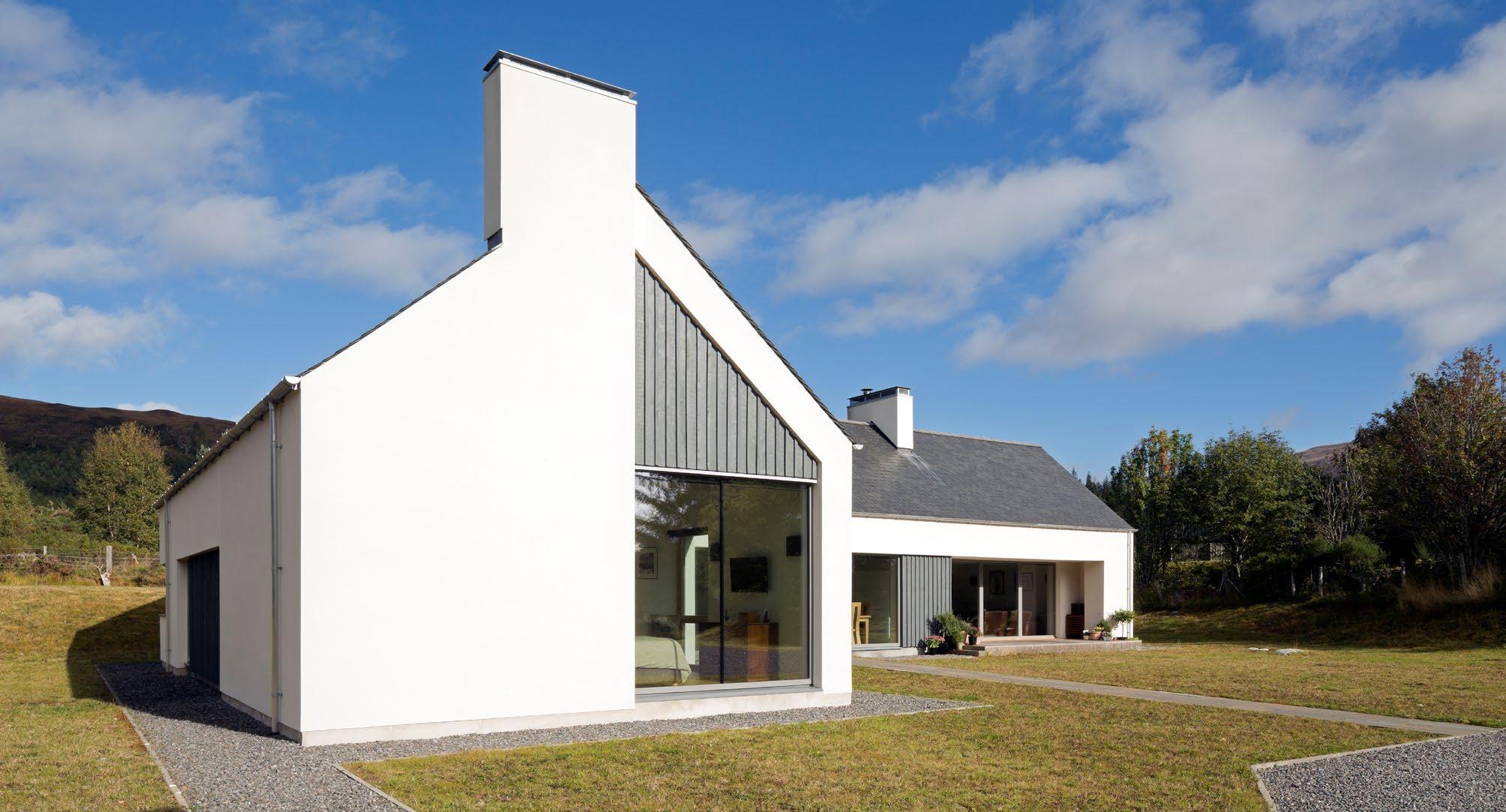
ph+ | news | 23 PASSIVE HOUSE+ NEWS



Book review Show Me the Bodies: How We Let Grenfell Happen, by Peter Apps
Review: Simon Jones
porter, Peter Apps, is a forensic review, as it stands today, of the evidence presented at that inquiry. And it is an indictment of the entire sector.
But it is the account from those that were there that night and the stories of the community that lived in Grenfell that lifts this book to another level. Each chapter starts at a point in time in the evening and sets the scene as the disaster unfolds, followed by powerful personal testimonies and stories of the lives it touched and destroyed.
It is an emotional rollercoaster of the shock of the events, the heartache of the lives it ruined, and anger at a system that let Grenfell happen. I found myself shaking my head in disbelief one minute, taking a minute to compose myself another (that's crying like a baby), to wanting to break something.
of June 2017, our government got what it had asked for”.
From the first chapter, this book smacks you in the face and doesn’t let up. It’s a story of loss and unbelievable bravery, it’s a story of neglect and obfuscation at a grand scale and ultimately a story of failure to protect the vulnerable including families and children.
It’s a story that everyone involved in the built environment should read, think about for a while, read again, and imprint in their memory.
The entire industry needs to ask itself the question, what kind of culture creep takes a company to a place that these found themselves in? And what systems can it put in place to make sure it never happens again?
On 14 June 2017, 72 people needlessly died in what was to become the UK’s worst housing disaster. For anyone watching at the time, as flames ripped up the sides of the high rise building in West London, it was clear something had gone horribly wrong, and what followed in the years afterward through the subsequent inquiry and investigations, sent shockwaves through the sector – shockwaves that should change everything.
I, like many, followed the inquiry as it happened, facilitated largely by the excellent reporting of Peter Apps, deputy editor at Inside Housing, a publication with a focus on social housing.
I was shocked by the testimony, and being from industry, was particularly interested in how something so extraordinarily flammable could find itself on the outside of any building, let alone a tower block. The answers, as they were coming out from the inquiry at the time, were explosive.
This book "Show Me the Bodies: How We Let Grenfell Happen", by the same re-
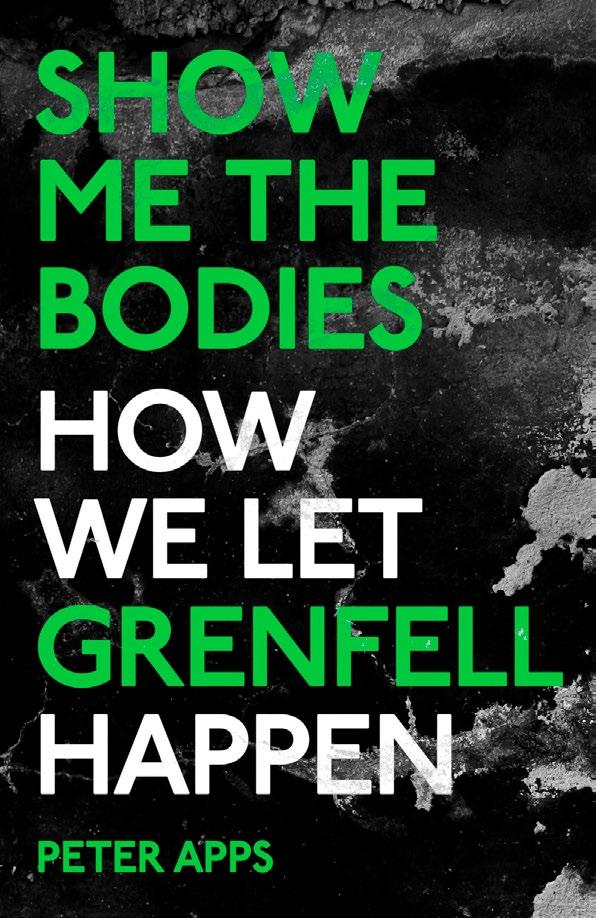
But this disaster was foretold by many, from industry experts to the residents of the flats themselves. Warnings to the local authority about the state of disrepair of many of the safety systems that would ultimately hinder rescue efforts on the night, went unheeded.
It’s hard to even begin to explain the industry's part in what led to the products being used on the high-rise, which ultimately turned Grenfell into a towering inferno. With one manager's response to questions about the products fire safety, years beforehand, saying they could “go fuck themselves”. An employee of another describing a test on its product as a "towering inferno", buried the testing and marketed it for use on high-rise buildings. There were failings, all the way to the top of the system itself, with the false reliance on declining deaths by fire used as an excuse for inaction and the citing of unreasonable burdens and costs to industry. As one senior civil servant put it when pressed to justify its failure to tighten fire safety rules, “show me the bodies.”
As Apps notes in the book, “on the 14th
And as a society, this book asks uncomfortable questions of us all. Ultimately, how did we let Grenfell happen? And this time, this time, will we learn the lessons? •
ABOUT THE REVIEWER
Simon Jones has been in building services, air quality and the built environment for nearly two decades and has consistently been a voice for better standards and approaches in the industry. He has built up a reputation of integrity and knowledge in that time across the ventilation and indoor air quality sector.
ph+ | news | 25 PASSIVE HOUSE+ NEWS
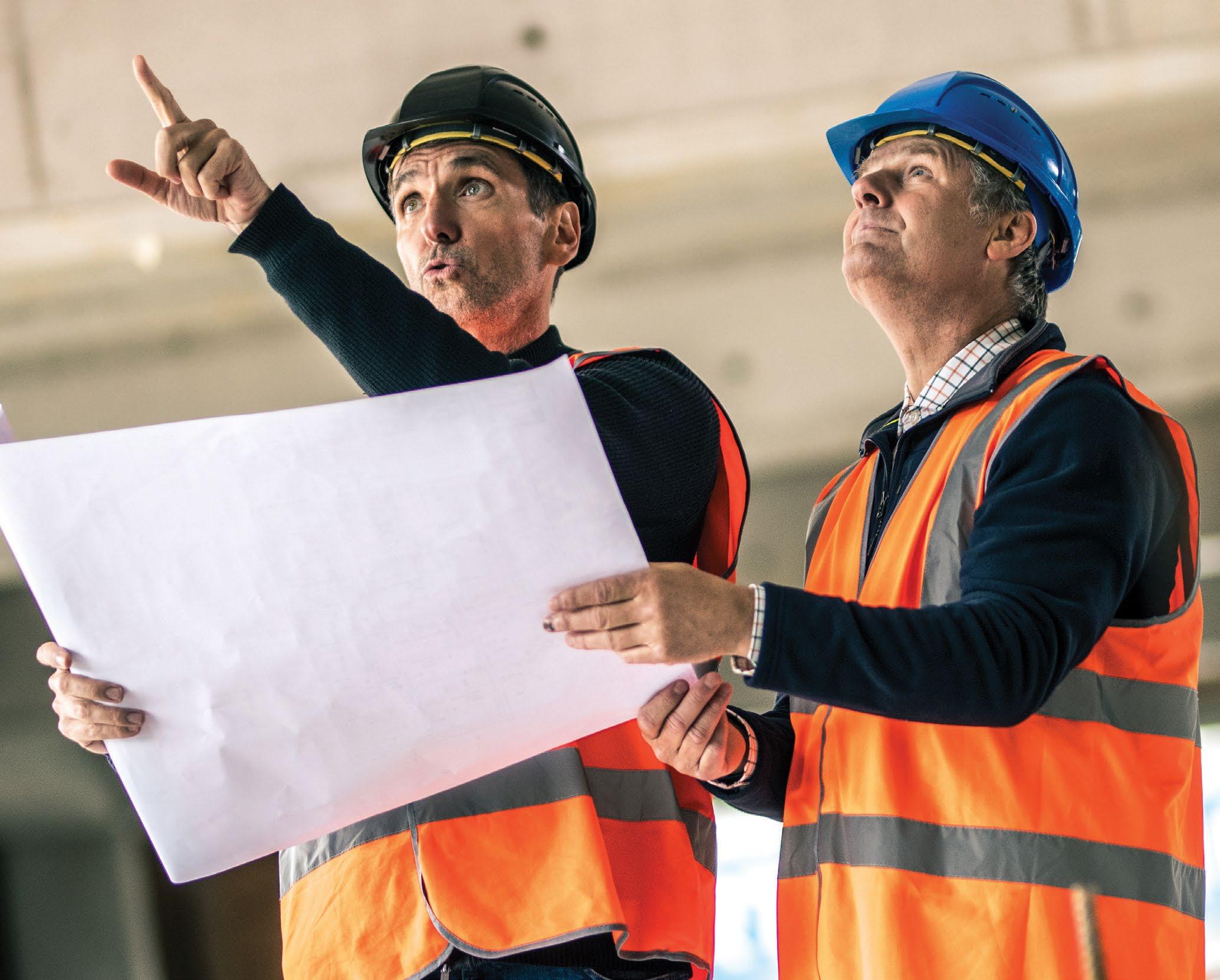
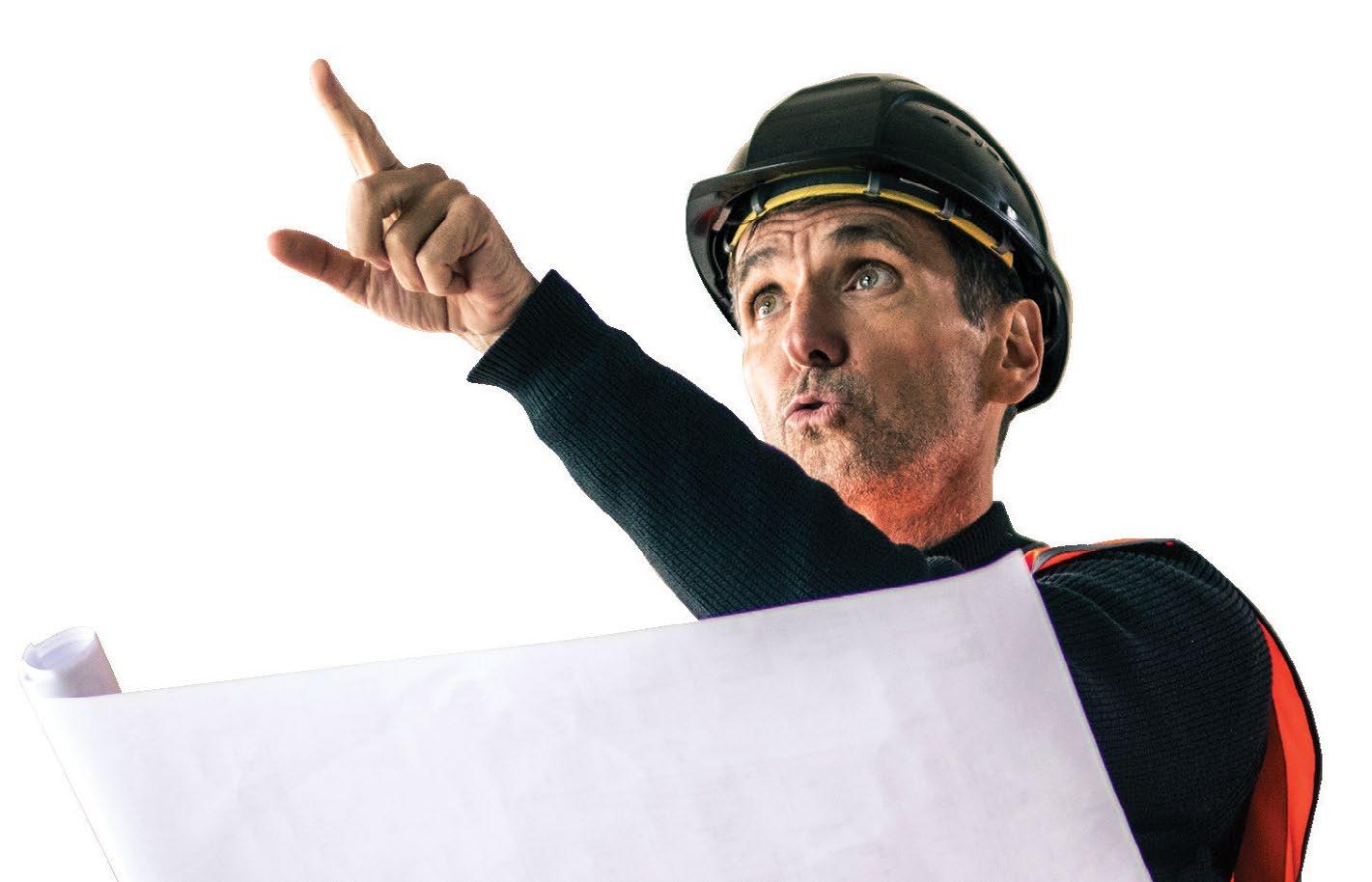
26 | passivehouseplus.ie | issue 44 NEWS PASSIVE HOUSE+ Get in touch with our technical team: Email: enquiries@gyproc.ie | ROI: 1800 744480 | NI: 0845 3990159 MAKING THE DIFFERENCE Where deep technical knowledge meets product innovation you’ll find that the Gyproc experience really makes the difference. Check out how Gyproc is Making the Difference: http://bit.ly/2KUnlSk
Ireland joins whole life carbon data initiative
Ireland is to participate in a pioneering European initiative aiming to boost the availability of quality building whole life carbon data, a critical step towards full decarbonisation.
The initiative, titled Indicate, will bring together government, industry, and academia to tackle one of the key barriers to decarbonising Ireland's built environment: a lack of reliable and comprehensive whole life carbon emissions data for buildings. Whole life carbon takes account of emissions across a building’s full life cycle, including emissions from operational energy use along with embodied carbon.
Pat Barry, CEO of the Irish Green Building Council (IGBC) said: “In Ireland, embodied carbon emissions associated with the production, transport, construction, maintenance, repair, and disposal of buildings and infrastructure account for 14 per cent of our national emissions. These are likely to increase significantly over the next decade as we build more homes and infrastructure, yet they remain unregulated”.
The EU recently took its own first steps towards whole life carbon regulation with proposals to introduce mandatory reporting for larger buildings by 2027 and all buildings by the end of the decade in the revision of a key piece of European buildings policy, the Energy Performance of Buildings Directive (EPBD). Countries such as Denmark, Finland, France, and the Netherlands, are moving faster and have already regulated embodied carbon emissions. In all these markets, the first crucial step in mandating whole life carbon measurements and reduction was to develop a robust methodology and establish high-quality baselines.
Commenting on the launch of the project, Francis Noel Duffy TD and #BuildingLife Ambassador added: “Addressing embodied carbon emissions is critical to halve our emissions by 2030 and reach carbon neutrality by 2050. The development of high-quality data and baseline data for buildings constructed in Ireland through pilot projects is a key step in supporting the regulation of these emissions in Ireland.”
The Indicate initiative seeks to accelerate this policy development in Ireland, Spain, and Czechia by generating critical baseline data for buildings, which will allow policymakers to set carbon limits that cover the
full life cycle impact of buildings, from manufacture and construction through to deconstruction and waste processing – so-called “whole life carbon limits”. In Ireland, the project will be delivered through Construct Innovate, Ireland's national research centre for construction technology and innovation with core personnel from University of Galway, IGBC and University College Dublin in the project delivery team, supported by the Sustainable Energy Authority of Ireland (SEAI).
Reacting to the launch of the initiative, Joe Durkan, head of technical – national retrofit at SEAI commented: “High-quality data on whole life carbon emissions associated with our built environment is critical to support policymaking and the decarbonisation of our building stock. SEAI recognises the importance of collecting standardised data through the development of a national methodology to assess these emissions and is pleased to support the Indicate project.”
The innovative public-private approach of Indicate aims to secure broad support from industry and policymakers alike, helping to ensure the resulting data is quickly put to use. The project is just the beginning of what the coalition hope will be a Europe-wide programme to finally quantify and drive a quick reduction in unregulated carbon emissions.
The Indicate initiative supports the implementation of the “Building a Zero Carbon Ireland” roadmap launched by the Irish Green Building Council in late 2022. The roadmap sets a clear path to reach net zero by 2050 and highlights the importance of developing a national methodology and a database of building life cycle assessments, leading to benchmarks being set and the introduction of a mandatory whole life carbon disclosure.
Call for embodied carbon case studies
Meanwhile, the IGBC is calling for volunteers to prepare case studies assessing the embodied carbon of construction projects using a new national calculation methodology being developed and tested by the IGBC. Funded by SEAI, the new UpfrontCO2 methodology has been developed by the IGBC to enable consistent whole life carbon calculation based on EN 15978 and the EU Level(s)
framework for measuring the sustainability of buildings.
“Current case studies are hard to compare with one another as they are assessed using different methodologies,” said IGBC whole life carbon lead Stephen Barrett. “We need a set of consistently assessed case studies so we can better understand the carbon intensity of our different building typologies today.”
Barrett said that in the process, volunteer partners will help to identify and re-think the most impactful decisions or so-called “carbon hotspots”, measure the kinds of differences that can be made, design out waste and design in circularity. In the process volunteers will learn about the future of EU legislation, the use of the whole life carbon calculation methodology, and the balance between operational and embodied carbon, while discussing problems and sharing results in the process Indicate was launched in December 2022 by a European consortium including the Building Performance Institute Europe, the Catholic University Leuven and World Green Building Council, and is coordinated by Danish consultancy, Smith Innovation. It is co-funded by the Laudes Foundation and cash or in-kind contributions from national partners, including national governments. •
More information can be found here: https://www.indicatedata.com/
ph+ | news | 27 PASSIVE HOUSE+ NEWS
The road to Damascus: The Passive House Standard
Set against a 1980s backdrop of abundant, cheap, dirty energy and reckless “greed is good” free market capitalism, a quiet revolution in low energy building was brewing in Germany, as Dr. Marc O Riain writes.

All the development of active and passive low energy buildings throughout the 20th century, much of which has been discussed in this column previously, was leading somewhere. From Solar 1 MIT in 1933, through to the first ‘Zero energy house’ in Copenhagen (1974), Bentley’s double wall construction (1976), the development of heat pump technology in the Phillip’s experimental house (Aachen 1975), the discovery of thermal bridging and thermal bypass by the Princeton House Doctors (1977), and the combination of heat recovery ventilation with a high degree of tightness and super-insulation in the Saskatchewan Conservation House (1977). Pioneering projects like these provided the deep research precedents required for the development of the passive house standard by Wolfgang Feist and Bo Adamson in 1988.
The voluntary German building energy performance standard was primarily centred around passive solar, thermal comfort, super-insulation, airtightness and mechanical ventilation with heat recovery (although not exclusively), and thermal bridge-free construction. Supported by government subsidies, Bott, Ridder and Westermeyer Architects developed a four-house terrace to the passive house standard in 1990. Each unit was 156 m2 and 50 per cent of the cost of the build was met by the Hesse state government.
The standard set quantitative performance targets for designers to meet to achieve a very low whole building energy use. The system synthesized most of the previous passive strategies with MVHR into a quantifiable design process. Interestingly, active solar (potentially due to cost) was not a core part of this strategy in 1988, but later welcomed by Feist as a suitable renewable component.
The passive house is only really ‘passive’ in the sense that the design approach takes a “passive-first” approach to energy conservation, leaving the building with a small amount of fixed primary energy balance (120 kW/m2/yr) to then be met with active systems. It might be better defined as a hybridised low energy or zero energy house.
This standard attempts to isolate the enclosed habitable environment from the external environment irrespective of the building’s location, making the standard globally appli-
cable, using local climate data sets. Criticisms of some aspects of passive house highlight issues with space heating capacity in colder environments (Straube 2009) and overheating in the summer (Goncalves et al. 2022, Mitchell & Natarajan 2019, Finegan 2022).
In a similar strategy to the Lo-cal House of 1976, designers must use high performance glazing (<0.8 W/m2k) and achieve thermal bridge-free design (identified at Twin Rivers - Nisson and Dutt 1985). The standard allows for shading devices to moderate summer overheating, employing natural shading such as deciduous trees or building integrated shading (again, similar to the Lo-cal House). The highly technical system is based on knowledge of building physics, a level of sophistication or specialization not commonly found in architectural education (Tzonis 2014) and as a result not abundant in architectural practice.
By 2016, there were only 3,000 certified passive house designers worldwide, with 323 in Ireland out of 2,507 registered architects at the time (Maguire 2016). The passive house standard, and its Excel-based planning software, requires the building designer to become familiar with local climactic conditions, mechanical systems, solar heat gain calculations, and thermal bridging calculations. The key energy performance standards are 15 kWh/m2/ yr for heating and cooling demand, and/or 10 W/m2 heating/cooling load, with remaining loads attributable to lighting and process loads, leaving a total overall building primary energy demand of 120 kWh/m2/yr for all energy loads – including a significant aspect absent from national methodologies such as DEAP and SAP: unregulated (plug) loads.
In 1996, an economical planning package was developed to demonstrate payback periods based on unit costs of energy plus inflation (Passivhaus 2016). In 2011, the institute introduced a standard for building retrofit, called Enerphit. While it relaxed standards for space heating demand (25 kWh/m2a) and airtightness (1 ACH @50 Pa), the overall whole building performance remained the same (120 kWh/m2a).
Passive house is the single most popular voluntary low energy design process in the world, with an estimated 60,000 (as of 2016) certified passive houses built worldwide (Passipedia 2015). The weakness of the system is
perhaps the need for so much training and the lack of intuitive design software. For architects passive house offers a measurable, quantifiable results-based matrix for design decision-making. It offers a clear, if complex strategy, that can inform the design process.
Several factors combine to limit the standards wider adoption due to cost and time-constraints: its detailed application software (PHPP), optional use of ‘localised’ climate data and in some instances use of secondary software (Trnsys, Therm, WuFi) to validate inputs. The standard is voluntary whereas national energy performance standards are mandatory, meaning one might or not achieve regulatory compliance by meeting the standard without additional measures, further limiting practice adoption.
At a very strategic level, passive house is both an insightful and useful design approach that every architect and engineer should learn in college. It teaches us to understand aspects of the whole building as an energy performing unit. Since Tomás O’Leary’s first passive house in Ireland in 2004, the growth of the standard has been both exceptional and global, influencing the EU definition of nearly zero energy buildings (2010) and the subsequent member state adoption in to building codes.
The passive house standard has been a valuable education, policy and practice tool, that has resulted in a complete modal shift in the design and construction of our buildings, and has the ability to eliminate fuel poverty through energy conservation while mitigating CO2 released into our atmosphere. In the lee of an energy crisis we have become far more aware of the importance of energy efficient buildings and the passive house standard. n
Dr Marc Ó Riain is a lecturer in the Department of Architecture at Munster Technological University (MTU). He has a PhD in zero energy retrofit and has delivered both residential and commercial NZEB retrofits In Ireland. He is a director of RUA Architects and has a passion for the environment both built and natural.
28 | passivehouseplus.ie | issue 44 DR MARC Ó RIAIN COLUMN
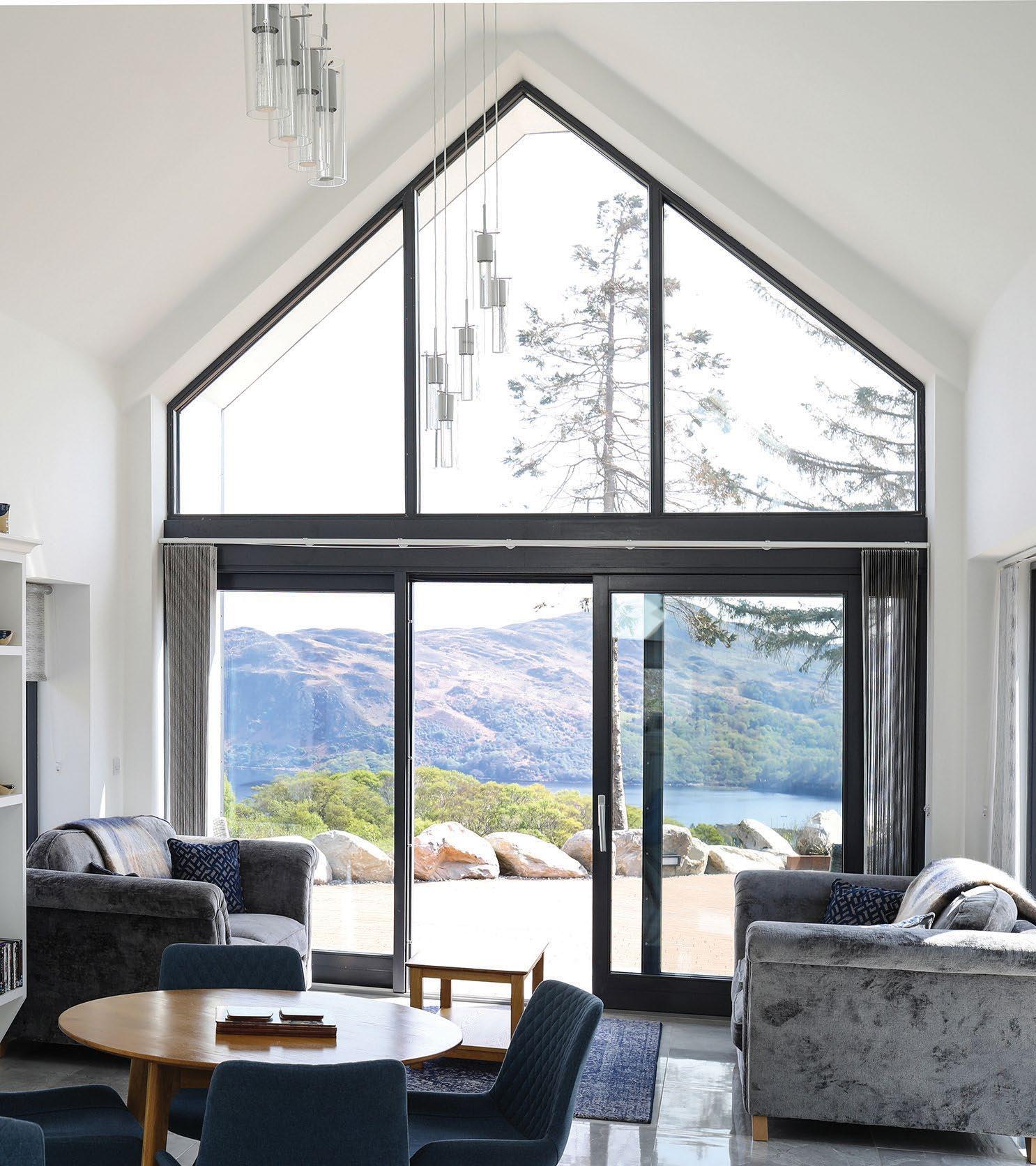



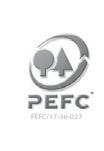
UNPARALLELED CHOICE OF PASSIVE CERTIFIED
– OUTWARD OPENING, INWARD OPENING, UPVC,
T. 064 7751151 E. info@munsterjoinery.ie www.munsterjoinery.ie
PRODUCTS
ALUMINIUM, ALUCLAD
SHOWROOMS: CORK, DUBLIN, GALWAY & BELFAST
& DOORS
GROUND BREAKING U-VALUES FROM AS LOW AS 0.47W/M2K
WINDOWS
Cynicism and inspiration
In spite of everything we know about how to build and retrofit high quality low energy buildings, poor practice remains stubbornly persistent in parts of the industry. But understanding why and how this persists could be a catalyst for change, argues
Dr Peter Rickaby

Readers of this column may have detected some cynicism in recent editions. After years promoting energy efficiency and retrofit, a little cynicism seems appropriate, especially about the chances of the UK government rising adequately to the challenge of climate change. However, my cynicism is more broadly based than that: it has been reinforced by recent projects and by Peter Apps’s book Show me the Bodies, about revelations from the Grenfell Tower enquiry. Apps paints a picture of an industrial culture of lying, cheating, and minimal compliance
and reporting on defects in a block of over 250 flats in south London owned by a housing organisation. The block was designed over ten years ago by a leading housing architect and a leading M&E consultancy, who adopted the passive house standard. Unfortunately, the housing organisation chose to procure the building via design and build, from a contractor who appears to have been incompetent at best. The design air permeability was changed from 1 m3/m2h@50Pa to 4 m3/m2h@50Pa, the wall U-value as built was 40 per cent higher than specified (be-
with or avoidance of regulations, combined with government complacency and wilful inaction in the face of uncomfortable truths. In short, focusing on the bottom line and ignoring the health and safety of everyone else.
Recently, I have been assisting a couple who bought a house from a housebuilder and have never been able to heat it adequately. In winter, they wear anoraks at home, and cannot invite friends and family to visit. After years of fruitless argument between my clients and the housebuilder, we used airtightness testing and thermography to show that the house is riddled with thermal bridging and thermal bypass, and with the help of a solicitor we finally nudged the housebuilder into offering limited remedial work. Then the housebuilder argued that further thermography to demonstrate that the proposed work has been effective is unnecessary because it is not required by Building Regulations. Wait – what? This is not about Building Regulations. Does the housebuilder care so little for its customers that it couldn’t just admit that the house is not fit for purpose, apologise for the defects and promptly correct them?
Another project has involved investigating
cause wall ties and fixings were not allowed for), the windows and external doors didn’t fit properly, the never-serviced MVHR systems were the cheapest available, and the ductwork leaked. In the as-built SAP/EPC assessments the air permeability of every flat was recorded as exactly 4 m3/m2h@50Pa, a barely credible result that doesn’t seem to have attracted the attention of the building control body. Recent testing suggests that 7 m3/m2h@50Pa would have been more accurate. To compound the mess the housing organisation is now procuring remedial work through another design and build process.
Finally, my colleagues at the UK Centre for Moisture in Buildings have been receiving requests from housing organisations for training about condensation, damp and mould (CDM). Of course, we are pleased to provide such training, but it is difficult to avoid the conclusion that the sudden interest is driven by the tragic death of Awaab Ishak, the loss of £1m funding by his family’s landlords, and the consequent sacking of their chief executive. There has been mould in social housing for decades, and it has either been ignored or dealt with by blaming
residents’ ‘lifestyle’ and perhaps installing an inadequate ventilation fan. If the objective of social housing is to provide accommodation for low-income families, how can mouldy housing that they cannot afford to heat properly be considered fit for purpose? Peabody’s ground-breaking CDM strategy for Thamesmead showed five years ago that a risk-based approach and good ventilation can deal with the problem. Cynicism is not helpful, of course, unless it drives effective action. I have said before that what the building and housing industries need to help them rise to the challenge of climate change is inspirational leadership. So, to finish on a positive note, there has always been plenty of that around, even if it hasn’t been as effective as we might like. Colleagues have undertaken and disseminated research and demonstration projects, written and published guidance, developed and delivered training, contributed to reviews, written technical standards, developed and implemented improvement strategies, and delivered cutting-edge retrofit. Organisations such as the Passivhaus Trust, the Good Homes Alliance, the Sustainable Traditional Buildings Alliance, the London Energy Transformation Initiative, the Architects Climate Action Network and the amazing Make a Difference network have many energetic and inspirational members. But why is exhausting work needed to counter the lazy, complacent bottom-liners who pushback? That’s life, I guess, so I’m minded to repeat some Latin advice from my late father: “Nil illegitimae carborundum” (which, very loosely translated, means “Don’t let the bastards grind you down”). n
Dr Peter Rickaby is an independent energy and sustainability consultant, and a retrofit consultant with Savills social housing team. He helps to run the UK Centre for Moisture in Buildings at University College London, where he is an Honorary Senior Research Fellow. He is also helping Rise International with research into sustainable building materials for Lesotho. The views expressed here are his own and not necessarily those of Savills, the UKCMB, UCL or Rise International.
DR PETER RICKABY COLUMN 30 | passivehouseplus.ie | issue 44
I’m assisting a couple who bought an unheatable house from a housebuilder. In winter they wear anoraks at home, and can’t invite friends to visit.
Building remarkable Making life remarkable

Our expert team drives an active programme of collaboration and innovation. We are building a network of the most forward-thinking partners and suppliers, to improve how we live through research, design and implementation.

D/RES incorporates international best practice in Environmental Social Governance (ESG) and was awarded GRESB accreditation in 2021.




www.dres.ie














We design and build homes with high levels of comfort and healthier living environments. Establishing sustainable communities is always at the forefront of our thinking.
ADAPTATION SENSATION
LANDMARK DUBLIN BUILDING PIONEERS DYNAMIC ADAPTIVE COMFORT APPROACH

Sometimes a building comes along that asks challenging questions. Chris Croly, building services engineering director of BDP, describes one such example – a building designed to tackle the specific energy profile of offices, while trialling an innovative, dynamicallycontrolled approach to adaptive comfort.
IN BRIEF
Building type: Large office block subdivided into two, totalling 39,000 m2 gross internal area
Key method: Adaptive comfort-based approach to cooling, heating and ventilation
Location: Dublin City
Standard: BREEAM Excellent
Energy use: 83 kWh/m2/yr*
* Total delivered energy use, based on the first five months of monitored usage.
83 kWh/m2 per year
32 | passivehouseplus.ie | issue 44 ESB OFFICES CASE STUDY
32
ESB OFFICES CASE STUDY
The carbon intensity of electricity in Ireland has reduced by 50 per cent over the last 15 years and is on track to achieve an 80 per cent renewable energy content by 2030.
The Electrical Supply Board (ESB) is a semi state group that has contributed to this achievement. They have set a target of being completely carbon neutral by 2040, investing heavily in renewable generation and associated technology such as energy storage.
As an energy company working within this context, the redevelopment of their offices in Dublin’s Fitzwilliam Street presented an opportunity to invest in the advancement of sustainable office development.

The majority of new offices rely on either a LEED or BREEAM environmental certificate to demonstrate their environmental credentials. While these certificates can give the impression of a building that performs well in all environmental aspects, they often mask a monitored energy performance that differs little from offices constructed decades earlier. Modern office design requires a step change in approach to achieve genuine energy savings.
The Fitzwilliam project contains two next generation office buildings, the first of which is used as the ESB’s headquarter offices, and also serves as a research tool. It provides a treasure trove of new techniques and technologies that have been shown (through subsequent monitoring) to dramatically reduce energy usage in offices.
The second building includes many of the same techniques but is optimised for the commercial market. This was an important aspect of the project as the office market
in Dublin invariably offers sealed, air conditioned buildings that struggle to achieve their energy aspirations. There was a need to introduce an alternative precedent and guide the market to low energy solutions.
The commercial office produced offers a new hybrid ventilation strategy that takes advantage of free cooling while offering comfort and air quality levels that exceed that of a typical air conditioned office. The market responded by showing a strong approval of the approach and placed a value on the building that notably exceeded the cost.
Procurement process
A design competition was held to select the project architect and their overall approach to the building. The unusual step was taken of appointing the mechanical/electrical and sustainability consultant (BDP) in advance of the architectural appointment to ensure that sustainability formed a key element of the architectural competition. Grafton Architects were appointed in conjunction with O’Mahony Pike Architects with a scheme that had the potential to embrace hybrid ventilation.
While a design and build contract was used for the shell and core of the buildings, BDP were conscious that the design and build process by its nature rarely prioritises environmental innovation. For the commercial block it was also important that a future fit-out would not dilute the services design envisaged. The solution was to fully design the key fabric elements for both blocks and the core services within the commercial block prior to the design and build competition. PJH were then appointed as

ph+ | ESB offices case study | 33 CASE STUDY ESB OFFICES
LEED and BREEAM certificates often mask a monitored energy performance that differs little from offices constructed decades earlier.
Exterior photos: Alice Clancy / Ros Kavanagh | Interior photos: Donal Murphy
Fitzwilliam Street elevation
James Street East elevation
the design and build contractor to complete the shell and core construction.
The ESB offices were then fitted out by Walls Construction with Jones Engineering Group as services sub-contractors, and Aecom were the fit-out architect. BDP were retained as sustainability and mechanical/ electrical consultant, while also assisting with monitoring the design and build contract to ensure consistency of environmental approach at all stages.
The approach allowed BDP to invest in the buildings as a research project and fully develop the new strategies implemented in both buildings.
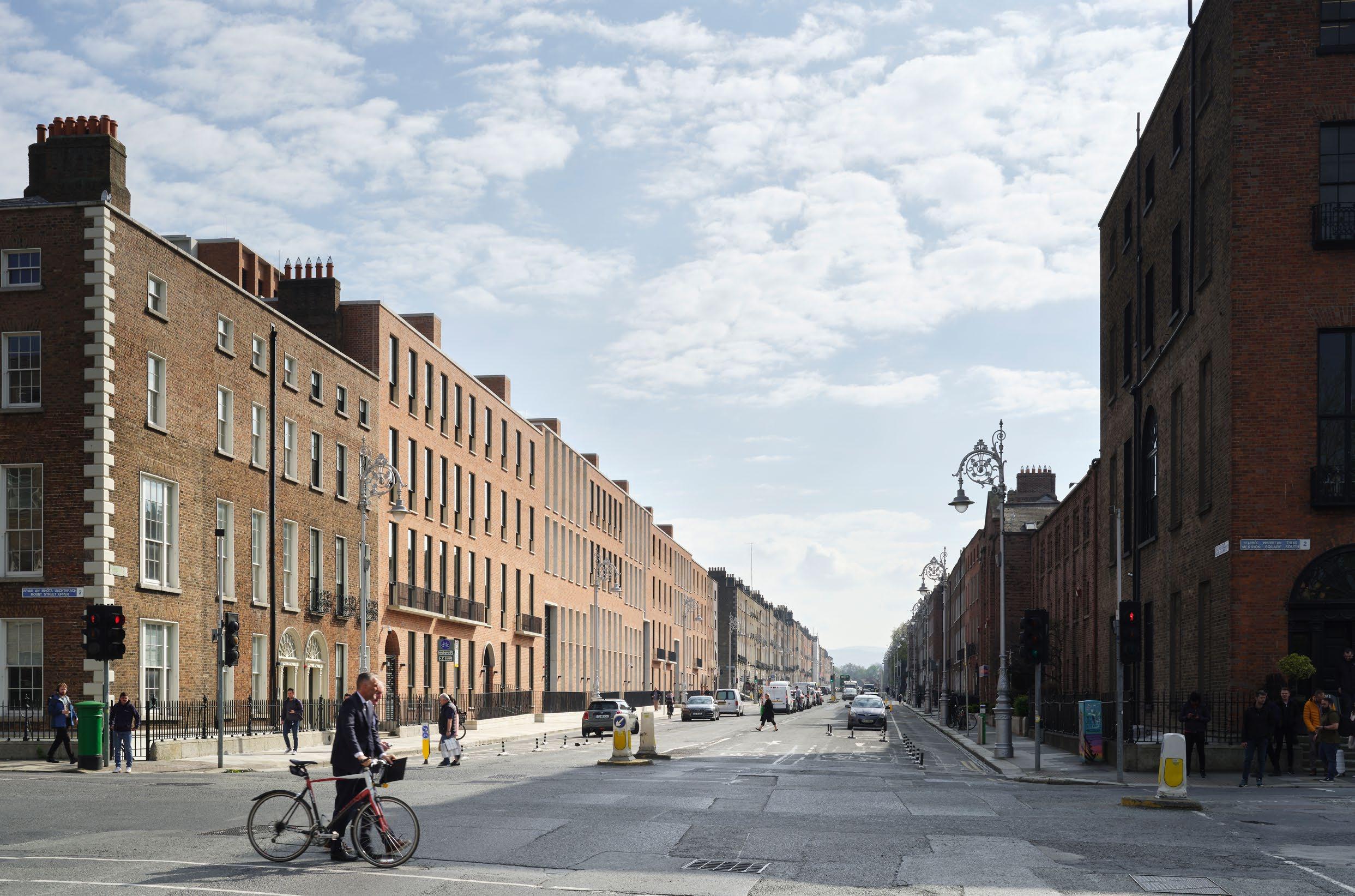
Passive design
Traditional office design norms such as the use of fully glazed facades were banned, and each element of design was required to reflect the principles of building physics to reduce the building’s demand for heat, cooling and lighting.
Hybrid ventilation
Modern offices often have a net cooling load throughout the year and external temperatures in Ireland are almost always lower than the internal temperatures required. This means that the tradition of sealing offices from their cooler external environment and then actively cooling them must end.
It can be tempting to think of a naturally ventilated office as the ultimate low energy solution, but the approach doesn’t allow heat recovery and often struggles to produce a comfortable and healthy environment.
A sealed air conditioned office guarantees precise internal conditions but is energy hungry and often produces a sterile environment that ultimately doesn’t deliver on health and comfort.
The new hybrid ventilation approach combined the best of all systems to achieve an enhanced level of air quality and an energy performance that has proven to be better than most naturally ventilated offices.
It was not possible to identify a clear precedent for this approach as tradition
frowns on the use of opening windows in fully air conditioned buildings. In part due to a concern that the energy used to cool them will be lost through open windows, air conditioned offices are invariably designed as sealed buildings. This is a valid concern where fixed internal set point temperatures are used but the constraint has been overcome by adopting a new approach to adaptive comfort.
The human response to temperature is complex and adaptation occurs naturally in warmer weather. Following several days of warm weather, people become more comfortable at warmer temperatures and even start to feel cold if the internal temperature is held down artificially.
This building pioneers a new control solution that allows the peak comfort temperature to be influenced by external temperatures that have occurred in previous days and weeks, with a higher weighting given to the most recent weather conditions.
As the resulting internal temperature is almost never below the external temperature, staff are free to intuitively open windows to naturally improve both energy usage and comfort. It is hoped that the demonstration of this control method will offer an invaluable example for future reference.
Early monitoring results have demonstrated that the strategy is very effective and has produced a record breaking monitored
34 | passivehouseplus.ie | issue 44
A naturally ventilated office may seem the ultimate low energy solution, but it doesn’t allow heat recovery and often struggles to produce a comfortable, healthy environment.
cooling energy usage below 4.5 kWh/m2/yr. This figure includes the comms room and specialist facility cooling and the cooling in open plan office areas was close to zero, reaching only 4 W/m2 when external temperatures peaked at 29 C during the summer 2022 heat wave.
The combination of natural and mechanical strategies with a new fan control technique has also reduced fan energy by more than 85 per cent compared with a typical office. Air quality is continuously measured by both CO2 and VOC sensors and excellent air quality has been achieved.
Façade design
The glazing areas have been adjusted by location, considering the yearly simulations of sunlight falling on each window. In particular, glazing on the upper floors, which are more exposed, have a smaller area. South and west-facing glazing is provided with solar control while solar gains are encouraged from the north and east. The key south façades are also provided with vertical external shading that is optimised to block solar gains in the afternoon.
Insulation and infiltration
Opaque elements have a U-value in the order of 0.15. The monitored building heating load is so close to zero that any increase in thermal performance would increase the embodied energy of materials used at a higher rate than the savings produced.
In most sealed offices, the level of air leakage achieved has become so small that it unwittingly increases the energy used by reducing natural cooling. It increases cooling loads more than it reduces heating loads. During the night in winter, when it is

important to prevent heat from escaping there is a benefit to having an airtight structure but later in the day, even in very cold weather, offices need to be cooled. Cracking open the high-level motorised windows encourages useful air transfer without causing draughts. This is implemented automatically whenever there is a net cooling load in the building.
Monitored heating energy demand has been less than 7 kWh/m2/yr. and roughly 25 per cent of that energy has been provided by recovering waste heat from cooling processes.
Ventilation
The building is set around a series of planted courtyards with all office areas having access to external spaces, natural light, and ventilation. Because the courtyards are set back from the street, they allow natural ventilation with less traffic noise and improved air quality.
Low level manual openings are provided for staff and motorised openings are provided at high level to reduce draughts and allows warm air out above head height. The automated windows have multiple functions including cracking open in cold weather, opening fully in warm weather, and providing night cooling. The high-level openings can also be manually overridden by staff.
An often-ignored constraint of opening windows is that in warm weather, blinds are pulled over the openings to prevent glare, blocking the free flow of air. Solid window sections were used to prevent this contradiction. The openings are also protected by external shading which takes the form of vertical fins that do not restrict airflow.
Exposed mass
A strip of 1.5 m of exposed mass is used at the perimeter, raising the glazing level and projecting daylight deeper into the plan. Deeper plan areas are reserved for tea stations as they have less need for natural ventilation and daylight. In these spaces an open timber grid ceiling is used. This allows the concrete to be thermally visible while still providing the visual benefits of a ceiling. During the day, the concrete absorbs heat and at night it is released and removed by natural cooling.
A 70 per cent GGBS content was used in the foundations and 50 per cent for the structure resulting in a reduction of 7,200 tonnes of CO 2 (160 kg/m2).
ACTIVE SYSTEMS
Fresh Air
Office air is traditionally supplied continuously for all staff, irrespective of how many people are in the building, even to empty meeting rooms and canteens.
In this case fresh air is only supplied at the rate required and reduces automatically as windows are opened. The air control system includes a number of innovations including the lowering of fan pressures in addition to volume with load. This rarely understood technique produces dramatic savings in fan energy, particularly during low load conditions.
Typically, in office buildings, a constant supply air temperature is used at all times which wastes both heat and cooling energy, and fails to take full advantage of free cooling. A number of innovative new control strategies are under test in the offices
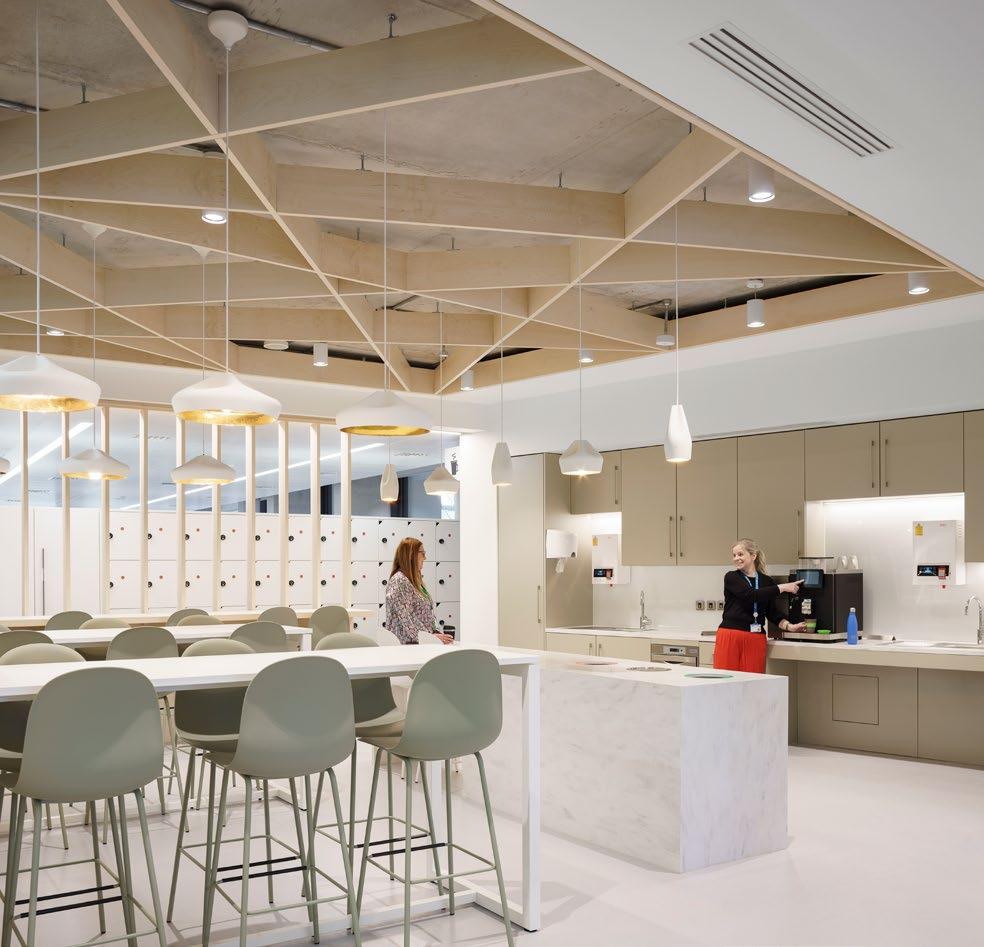
ph+ | ESB offices case study | 35 CASE STUDY ESB OFFICES
including a self-learning strategy which adjusts the level of free cooling provided based on the net loads.
Open breakout spaces are used for informal meetings which limits the use of more closely controlled meeting rooms.
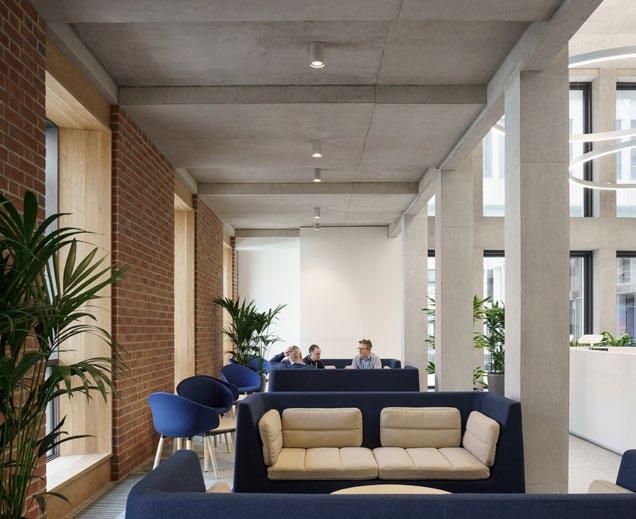
Heating and cooling
The building is a zero local pollution building with no fossil fuel connections, even for cooking. The operational carbon impact of the building will approach zero along with the national grid.
Air source heat pumps are used to generate heating, cooling and recover heat when simultaneous loads occur.
Cooling is provided from several sources:
• 100 per cent of the hot water for showers, hand washing, catering etc., is provided by a heat pump that recovers heat from the cooling system, offering cooling as a by-product.
• Free cooling is provided by a 4.8 km closed loop ground collector.
• Cooling is recovered from any live heating demands in the building.
• A phase change store is used to transfer cooling loads to the night when there is less demand on the electrical grid.
The phase change material used for the energy store is an advanced product which is similar to ice but changes phase at 10 C. This product is not in common use and is under test in this building. It has charac-
teristics that differ from ice which are not widely understood.
In winter an office has a net heating load in the morning and a net cooling load in the afternoon. The phase change material stores the cooling potential from the morning for use as free cooling later in the day.
The fan coils used for heating and cooling only have one coil which reduces fan energy. This is achieved by using an innovative six port valve that switches each coil between heating and cooling mode. This technique reduces capital and running costs, and embodied energy.
A glycol free system is used which reduces chemical consumption but also improves the heat transfer properties of the water used.
Environmental assessment methods
During the design process the ESB hosted a workshop with the IGBC to compare BREEAM, LEED and the German DGNB environmental assessment methods. The purpose was to study the different approaches used but also to incorporate the best concepts from each method. An assessor was invited from each organisation to review the building and offer suggestions that could be incorporated into the design. The three methods were very similar, but the DGNB method was the most flexible of the methods reviewed. The method also encouraged the team to consider how the building could be designed for increased adaptability in the future.
The building was formally assessed under the BREEAM method and achieved an Excellent rating, but priority was given to
actual environmental performance rather than the certification result in the few cases where conflicts occurred.
Water
A ground water well is used to provide local water for flushing and irrigation.
Monitoring and reporting
There is limited detailed energy data available for modern offices. The ESB offices are fitted with an extensive metering package and BDP are monitoring and tuning the building’s performance and post occupancy evaluation process.
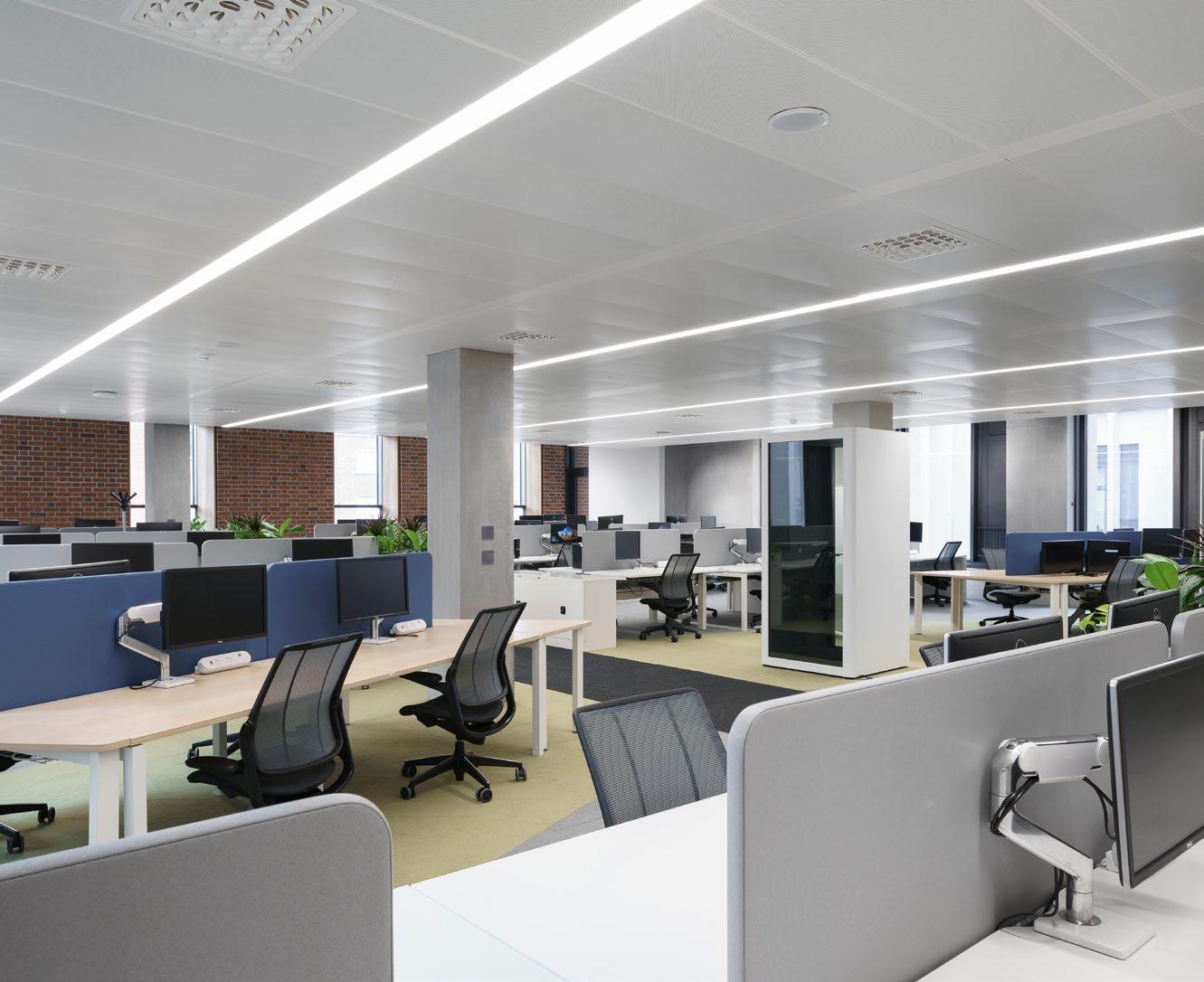
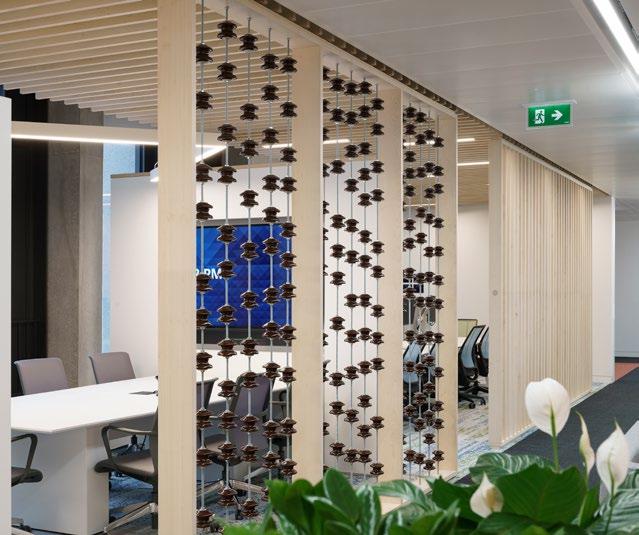
It is hoped that the insights produced by this building will inspire future offices to achieve a step change in energy performance and in particular, it is hoped that it will bring about an end to the age of the sealed, air conditioned office.
ARCHITECT’S STATEMENT: GRAFTON ARCHITECTS
In 2009 the ESB organised an international design competition to find an architectural team to design a world‐class office building. Grafton Architects & OMP Architects were successful in their entry to create a building that satisfied the needs of the ESB as well as the citizens of Dublin on this important and historic streetscape.
Located at the centre of the Dublin’s Georgian Mile and between the 18th century grandeur of Merrion and Fitzwilliam Squares, the challenge for Grafton Archi-
36 | passivehouseplus.ie | issue 44 ESB OFFICES CASE STUDY
tects was to find a way to create a modern office building that could comfortably sit amongst the restrained elegance of the sur rounding Georgian context.
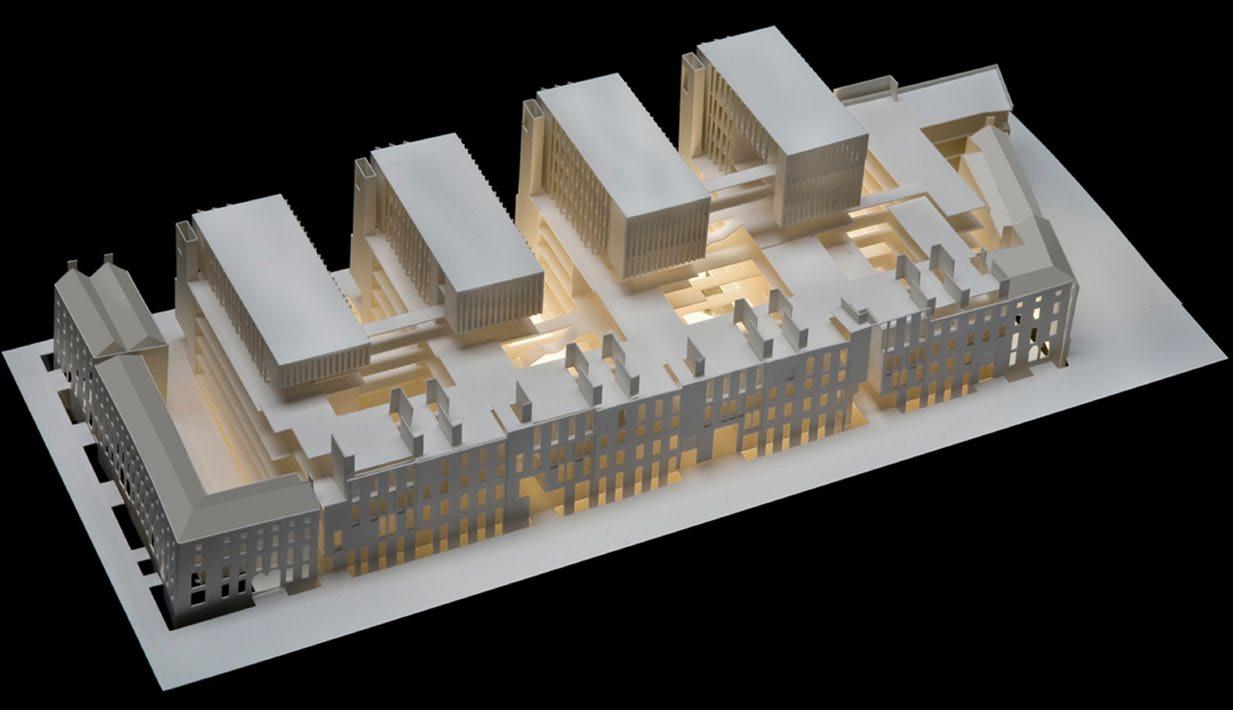
To begin this process, we set about analysing the built fabric of the Georgian streetscape including its rhythm of windows and doors, its hierarchy of floors, its gently stepping parapet lines, chimneys and threshold of railings bridge and basement, which bring light down to lower level. These elements form the essence of the Georgian streetscape, they represent the fundamental machinery of Georgian architecture. The proposal works within this vocabulary, this language of building, in a contemporary way, to make a building sensitive to its surroundings and representative of its own time.
The new building continues the Georgian streetscape and parapet height of a four‐storey brick wall to Fitzwilliam Street Lower. This edge is crafted with a load bearing, masonry brick wall that has been designed and detailed to harmonise with the existing load bearing brickwork of the street.
The façade to Fitzwilliam St is designed to feel familiar and new at the same time. It feels familiar because it relates to the gracious brick walls of the existing street, which is repetitive and cohesive, where each house is slightly different from the next. It feels new because it is similar but not the same, with new elements subtly introduced to accommodate new uses and new ways of building. The materials used have been carefully chosen to be both sympathetic (brick and Wicklow granite) as well as innovative (thermally broken stepped steel windows).
To James’s Street East, a strong and vibrant streetscape is proposed to provide order and clarity of form. Brick gables face James’s Street East and these blocks open and set back to create courtyards, connections, and sunken gardens spaces. These new forms release a lavish landscape proposal to the street and frame vistas through the scheme from the street.



The design is entwined with a sustainable agenda to deliver a healthy and energy ef-

ph+ | ESB offices case study | 37 CASE STUDY ESB OFFICES
The design and build process by its nature rarely prioritises environmental innovation.
Plans showing various floors on the building’s 4, 5, 6 and 7 storey sections including (top to bottom) the ground floor, third floor, fifth floor and roof top; and a massing model of the building
ficient design for its occupants, where a high-quality work environment is provided, delivering flexible and adaptable floor plates, naturally ventilated spaces within a building made with high quality robust materials and workmanship that knits into the city fabric and will stand the test of time
Fitzwilliam Street facade
The wall to Fitzwilliam Street is composed of two solid brick walls built in a composite manner. The outer wall is a self-supporting brick wall to the street while the inner wall is a loadbearing brick wall that supports the concrete superstructure. A thermally insulated cavity separates these two constructions. The brick used is a large (240 x 115 x 73 mm) custom made brick from Gillrath brickworks in Germany. This overall construction measures 800 mm in width and rises to approximately 21 metres from the lower lightwell. Both walls are built in Flemish bond with lime bedding and pointing. The use of load bearing masonry with lime bedding allows for a wall free from mastic filled movement joints. Although building joints are provided every 15 linear metres there are no joints required over the 21 m height of the wall.
The loadbearing structure of brick piers
stack from level to level, there are no concrete columns or steel frames embedded in the structure. The slab has exposed concrete coffers bearing onto the brick structure and varies in depth from 150 mm to 250 mm. All elements that require structural support, such as the staggered steel frame windows, granite surrounds, copings and gates are all fixed to the inner brickwork and are cantilevered over the external wall allowing for independent movement between the inner and outer parts of the wall. The windows are finished internally with a solid oak liner which splays to allow additional light from the west.
The windows to Fitzwilliam Street are a thermally broken steel window system. A ventilation flap is incorporated at the step in the window section. The window openings in the outer brick wall are lined with a feathered reveal of lime mortar. Masonry flat arches are used to form the window openings in the wall. Larger openings make use of precast concrete elements built into the wall as loadbearing lintols. Leinster granite is used extensively on the Fitzwilliam Street Façade, for the cills, steps, kerbs, parapets, railing base and colonnade linings. The street side wall of the lower lightwell is lined in glazed bricks to reflect daylight into the
lower ground level and courtyards.
Courtyard facades
The courtyard facades are constructed from Techrete precast concrete panels and canopies with a grit blast finish. The panels are composed of white cement concrete with a granite aggregate. There are two different types of grit blast finish, one rougher than the other. In terms of support, the panels at lower lev-els are stacked whereas on the upper floors they are corbelled off the concrete super-structure. The plan geometry of the panels varies depending on the orientation of the facade, with the south facing facades having deeper fins to assist with solar control. The openness of the panels varies from the roof to lower ground floor, with the solid to glass ratio reducing as the building descends, allowing for additional light penetration to the lower levels.
A high-performance aluminium window system is used throughout the nonFitzwilliam St facades. The system has a custom profile fin to the front and rear perimeters that act as closers to the cavity on both sides. Each 3 m bay is composed of a large fixed window, a solid side hung vent and an upper BMS actuated top hung vent.
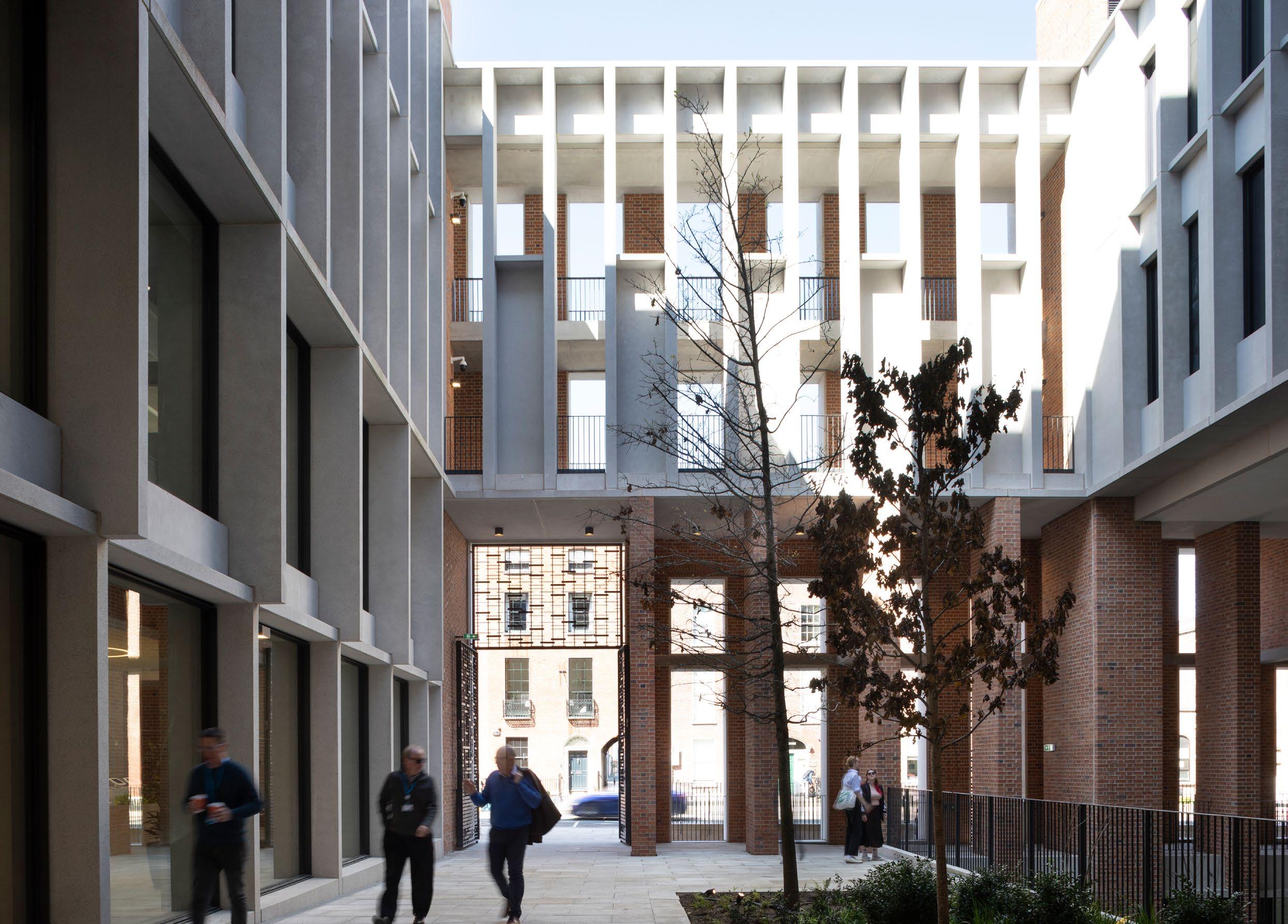
ESB OFFICES CASE STUDY
WANT TO KNOW MORE?
The digital version of this magazine includes access to exclusive galleries of architectural drawings.
The digital magazine is available to subscribers on passivehouseplus.ie & passivehouseplus.co.uk
SELECTED PROJECT DETAILS
Client: ESB - Electrical Supply
Board Ireland
Architects: Grafton Architects / O’Mahony Pike Architects
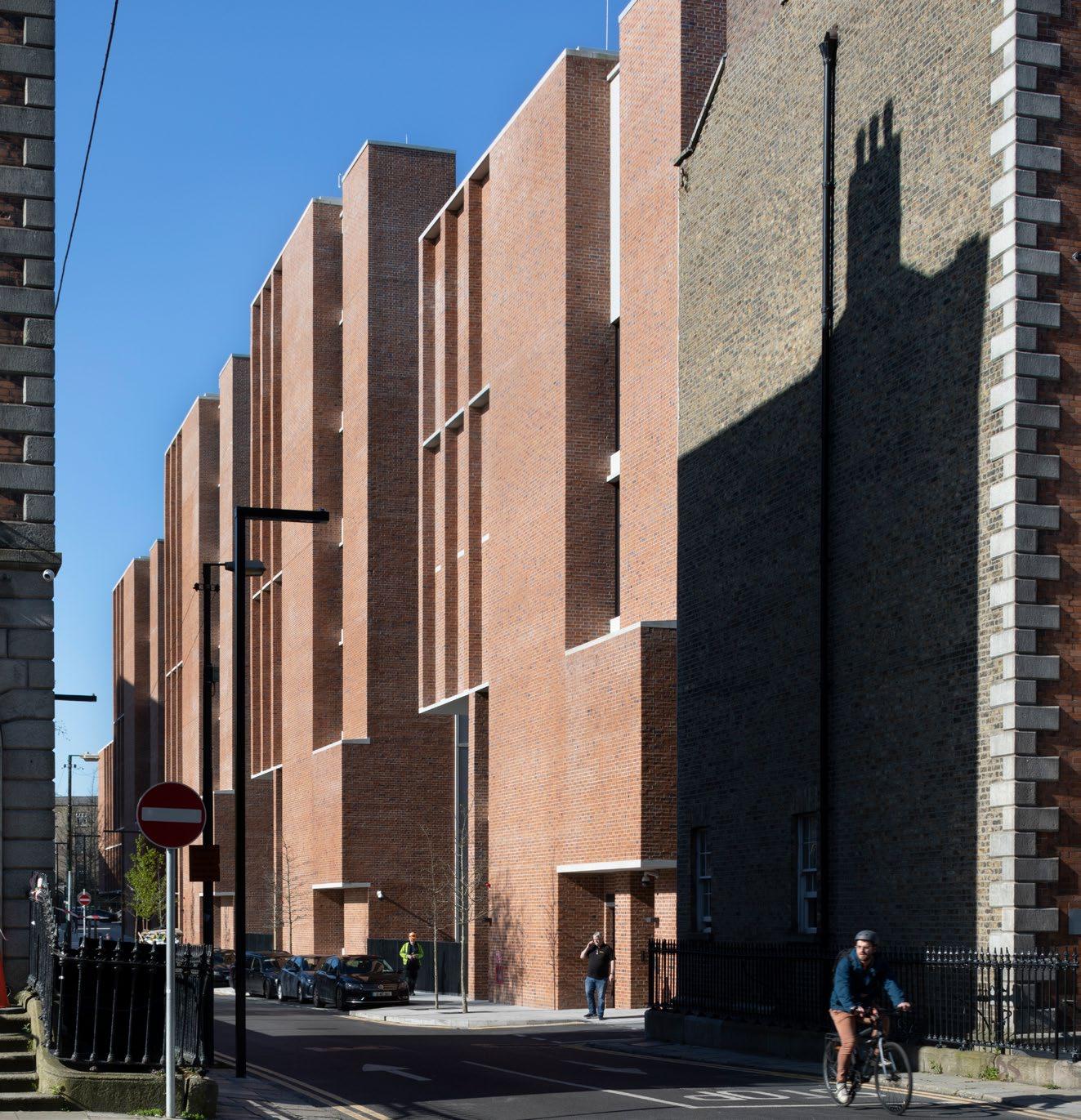
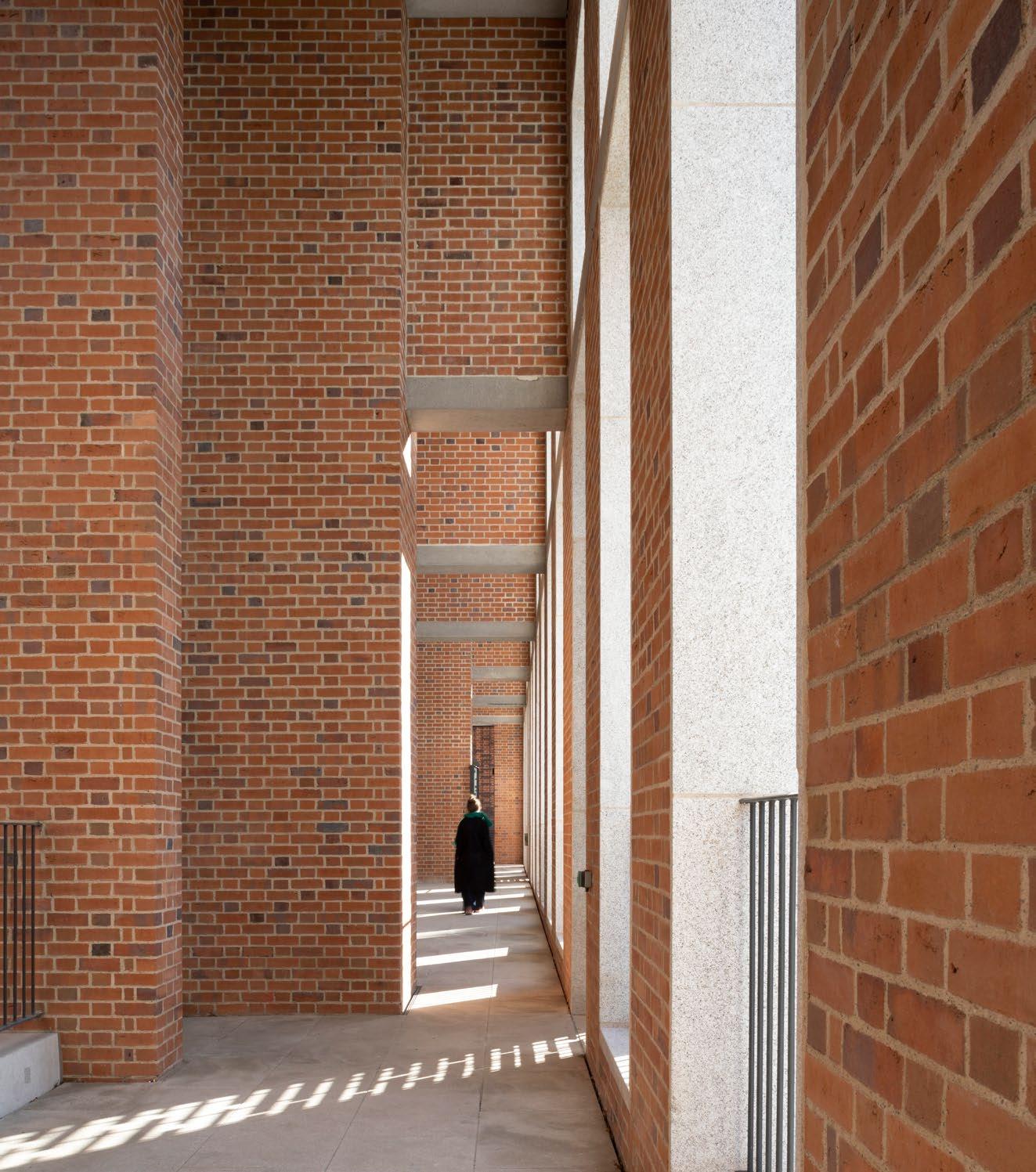
Sustainability consultants: BDP
Conservation architects: Shaffrey Associate Architects
Structural/civil engineers: O’Connor Sutton Cronin
Landscape architects: Bernard Seymour Landscape Architects
Mechanical/electrical consultants: BDP / Axiseng
Quantity surveyors: Linesight
Planning consultants: Tom Phillips & Associates
Fire consultants: MSA
Acoustic consultants: AWN Consulting Ltd
Façade consultants: Buro Happold
DAC consultants: Maurice Johnson & Partners
Project management: Lafferty
Health and safety: Arup
Ecology: Scott Cawley Ltd.
Main contractor: PJ Hegarty & Sons
Mechanical contractor: Leo Lynch
Electrical contractor: Designer Group
Airtightness testers: Building Envelope Technologies
Thermal bridging modelling: Passivate
BREEAM (D&B): Eslar
Precast subcontractor: Techrete IRL
Windows subcontractor: Gunn Lennon Fabrications
Brick supplier: Janinhoff Klinker
Manufaktur / Gillrath Ziegel & Klinkerwerk GmbH & Co. KG
Steel window fabricator/supplier: MHB / The KCC Group
Granite Supplier: RyanStone
Metalwork: OMC Technologies Ltd
Specialist pointing Contractor: Oldstone Conservation Ltd
Superstructure concrete frame: Admore Group
Landscaping subcontractor: Peter O’Brien & Sons Landscaping Ltd
Roof: Crown Roofing Limited / Bauder Flat Roofs
Automatic opening vents: Alucraft Ltd t/a William Cox
Tiles: Aston Crean Ireland
Fire doors and timber panels: Burke Joinery Limited
Partitions: Castle Group
Lifts: Kone (Ireland) Ltd
Precast Stairs: O’Reilly Concrete
Terrazzo: P J Ryan Terrazzo & Mosaic Spe
Screed: Floor Screed Ireland
Insulation: U-Value Insulation
Green roof: Crown Roofing Ltd
ph+ | ESB offices case study | 39 CASE STUDY ESB OFFICES
Build warmth with Grant
Our complete integrated heating packages provide everything needed to build a highly efficient, warm and comfortable home.
Tailored to suit the homeowners’requirements, each Grant heating package is correctly sized and specified, free of charge, to achieve compliance, maximise efficiencies and provide long-term savings.
Packages feature the Grant Aerona3 air to water, air source heat pump, Grant hot water cylinders, Grant Afinia aluminium radiators and the Grant Uflex underfloor heating system. Smart controls are also available.
Trust Grant on the journey to warmth and comfort by sending house plans to heatpump@grantengineering.ie

40 | passivehouseplus.ie | issue 44
Superstructure
The superstructure of the building - which was the overall winner and building category winner at the 2022 Irish Concrete Society Awards - is an exposed concrete frame with suspended flat slab floors. The use of GGBS was maximised in the project, with 70 per cent GGBS being used in the lower floors and 50 per cent GGBS in the upper floors. A series of concrete Vierendeel trusses allow for larger overhangs and clear spaces. The column structure charges orientation as the
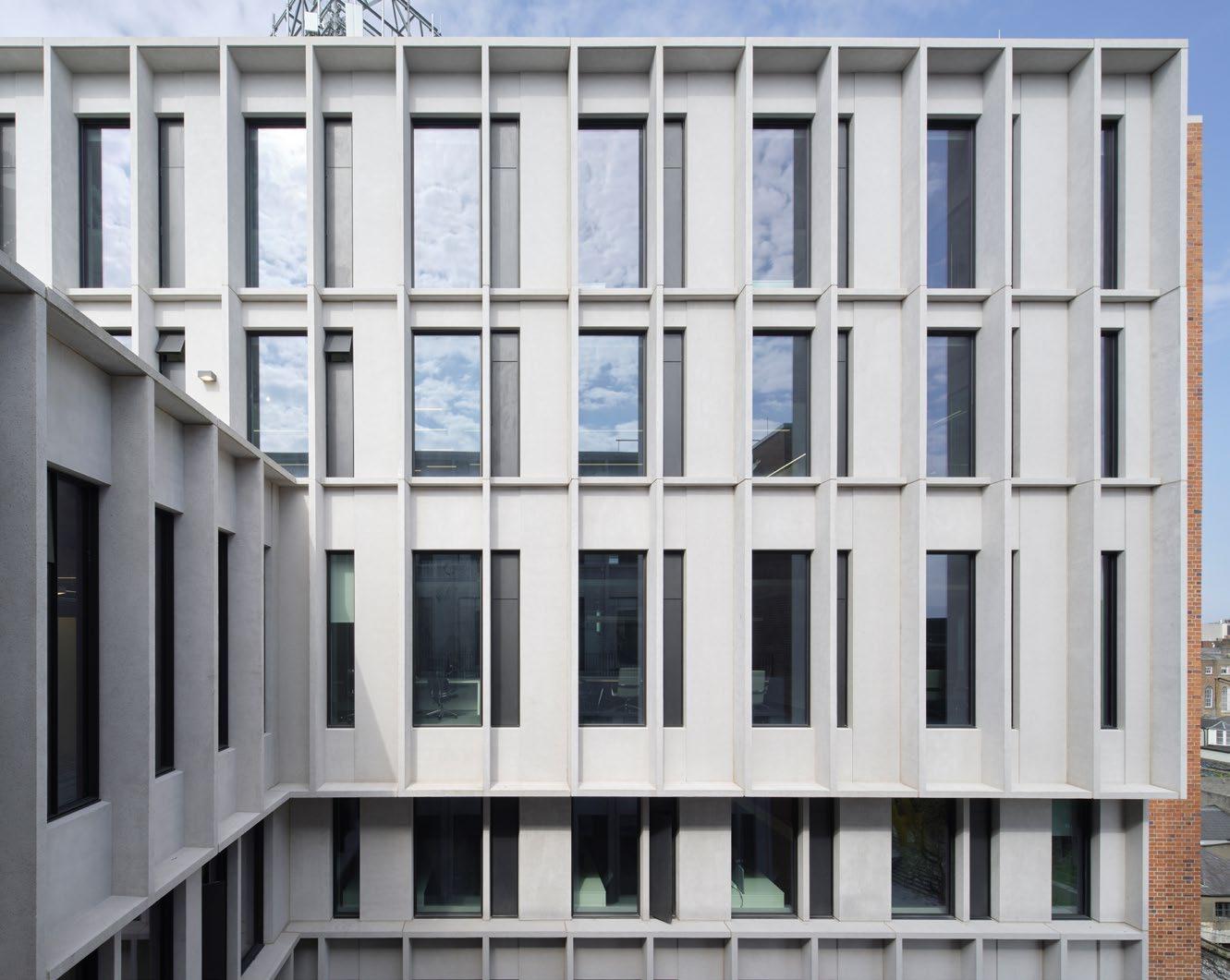
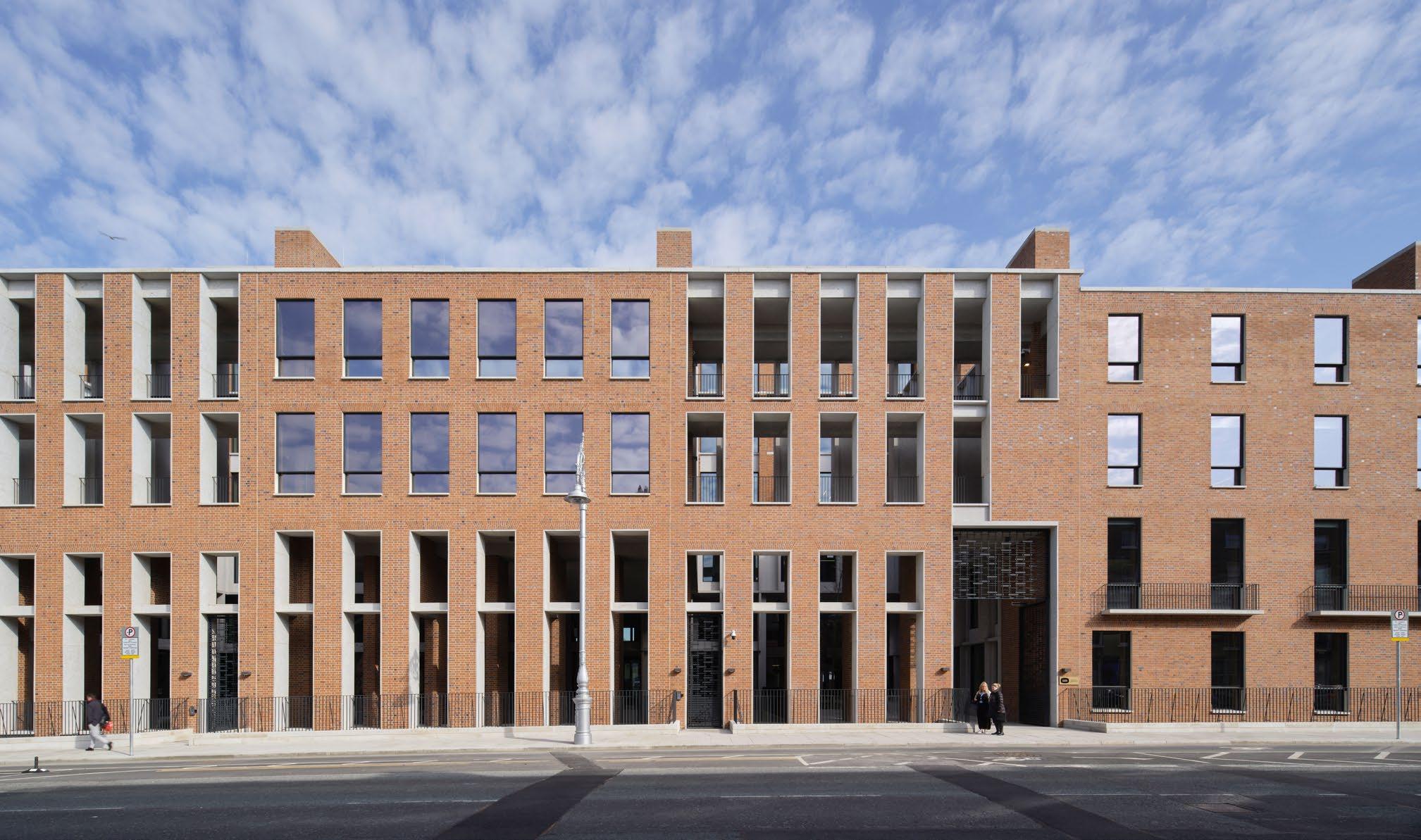
structure descends, allowing for the increase in window dimension and light to the lower levels. At level 04 structural transfer beams accommodate a change in block width at this point from an 18 metres floor depth to 15 metres above. Precast concrete soffits are cast as permanent formwork with cast in lighting and thermally isolated. Chilled slabs are incorporated into all roofs, these are inhabited with various soil depths and biodiverse roof finishes, bees, and solar panels.
SELECTED PROJECT DETAILS
Architects and quantity surveyors: Aecom
Sustainability and BREEAM

consultants: BDP
Mechanical/electrical and civil/ structural consultants: BDP
Audio visual: Hamilton Robson
Project management: Lafferty
Catering: QA design
Main contractor: Walls
Mechanical/electrical contractor: Jones Engineering Group
Air handling units: Systemair (ESB side) and Flakt Woods (Block A)
Air source heat pumps: Daikin (ESB side) and EICL (Block A)
Zero GWP transfer heat pump: Daikin
Phase change material: (Crystalair PCM)
Hot water heat pump (water-towater): Climaveneta via Flakt Woods
Grilles and diffusers: Entropic
Low energy kitchen canopies: Entropic (automatic cooking sensors and UV filtration to allow heat recovery)
Underfloor heating: FLV
Window actuators: Smoke Management Systems Ltd
6 port valves: Belemo Automation
Meeting room heat recovery unit: Flakt Woods
Fan coils (very low fan power units –also unusual as designed for single coils): Versatile.
ph+ | ESB offices case study | 41 CASE STUDY ESB OFFICES

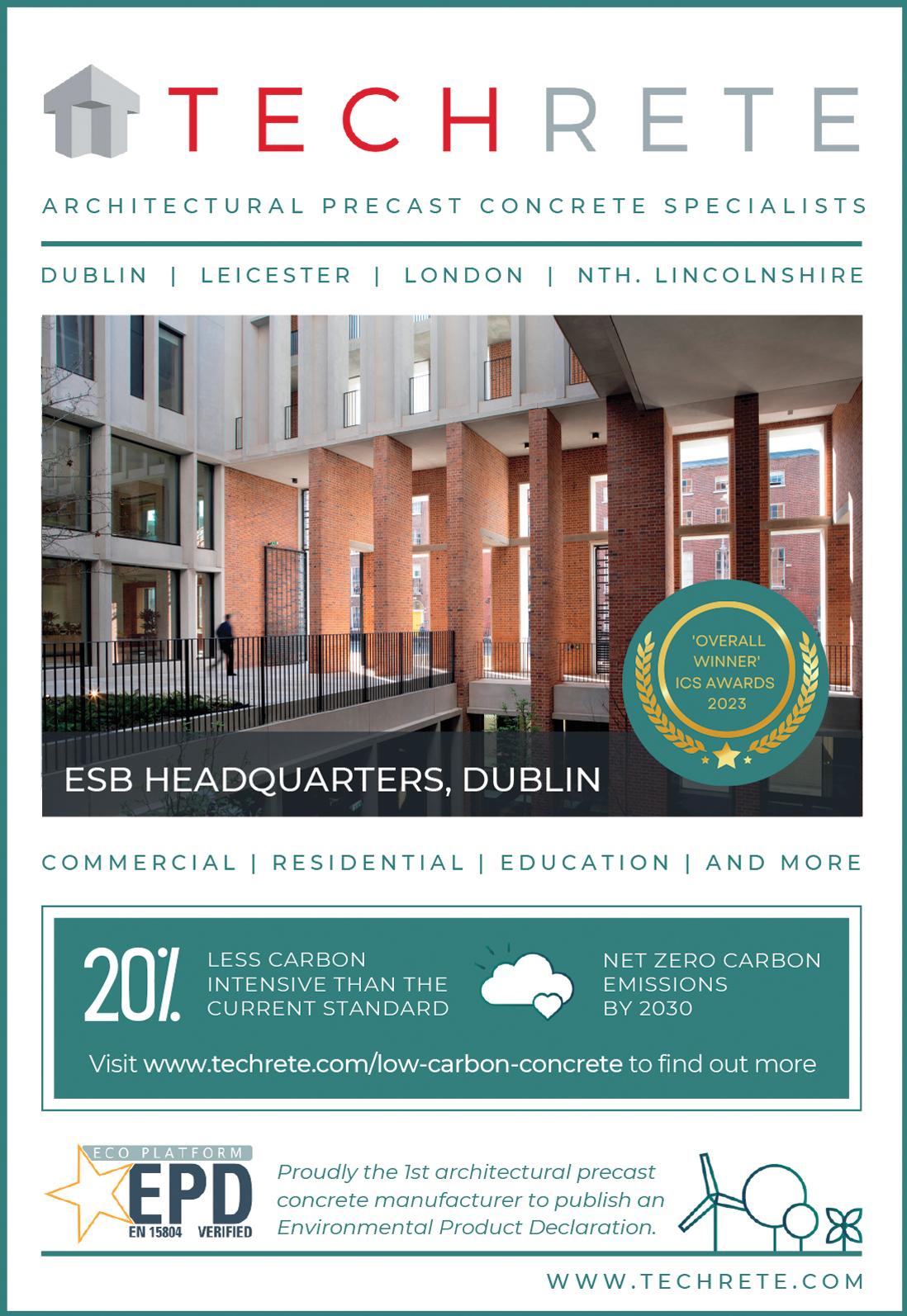

ESB OFFICES CASE STUDY
Building type: Large office block subdivided into two distinct offices, with a 22,343 m2 gross internal area block occupied by the ESB, and a 16,577 m2 commercial block.
Location: Fitzwilliam Street, Dublin
Completion date: February 2022
Budget: Approx. €150 m.
Environmental assessment method:
BREEAM Excellent
The LEED, WELL and DNGB methods were also used to inform the design. The building was used as a case study as part of an IGBC study of assessment methods.
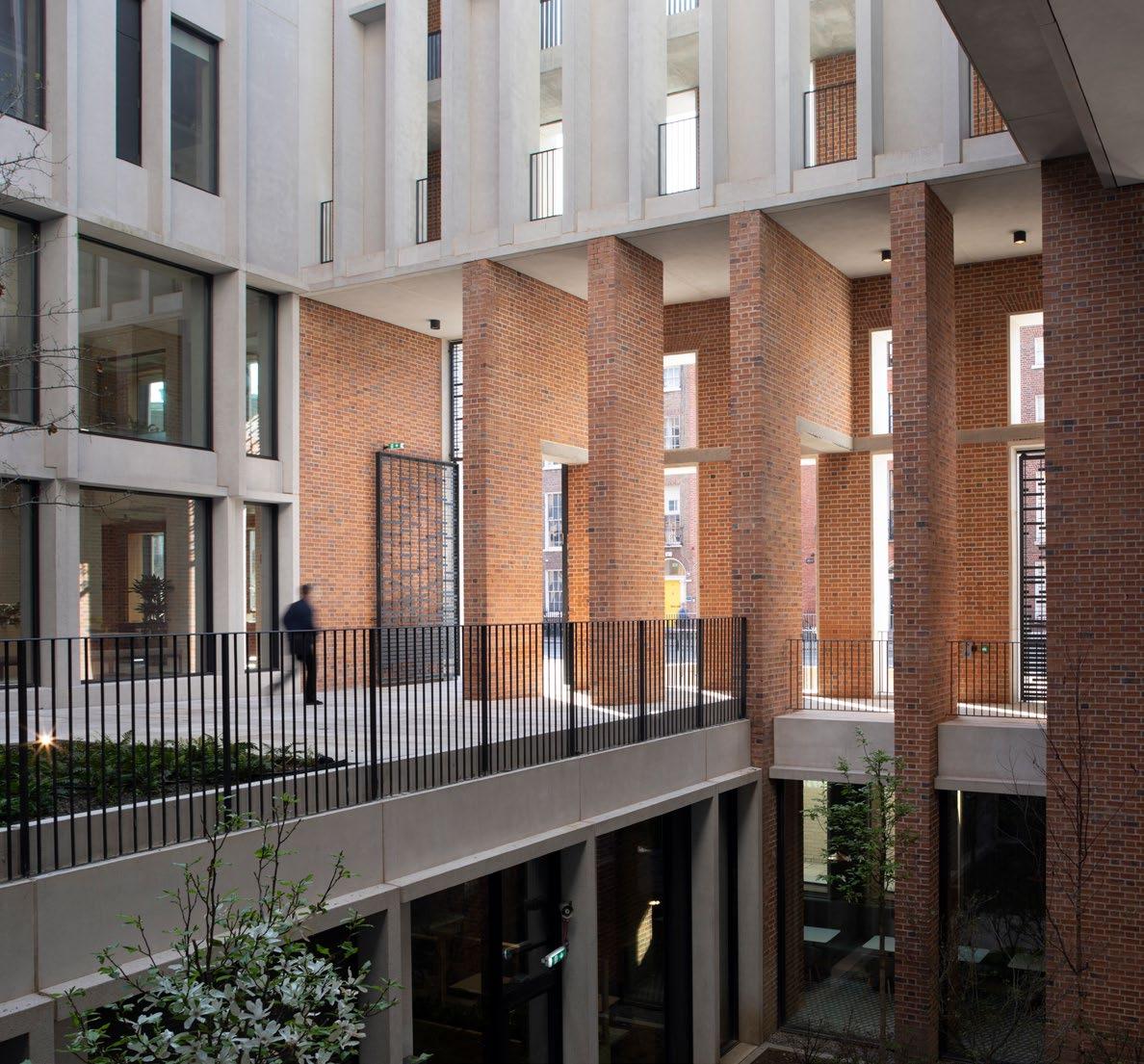
Space heating demand: 7.7 kWh/m2/yr by detailed dynamic thermal simulation. Initial monitoring results imply the figure is realistic. Note that the majority of this heat is provided by recovered heat.
Heat load: 15 W/m2 by detailed dynamic thermal simulation. Initial monitoring results imply the figure is realistic.
Primary energy demand: 67.7 kWh/m2/yr using SBEM.
150 kWh/m2/yr using dynamic simulations.
The building operates 24/7, 365 days per year, and contains some functions that are not directly related to the building so typical office benchmarks must be used with caution. It is too early for monitoring results to give an accurate indication of performance, but initial usage implies a value between the figures above. Overheating: 0 per cent overheating from dynamic simulations.
The building embraces adaptive comfort and internal temperature limits are a complex function of external temperature. The traditional overheating criteria do not apply and a new dynamic, adaptive response is used.
The building is capable of achieving a set internal temperature, but it is allowed to adapt dynamically in the interest of both reducing energy and improving comfort.
Number of occupants: The ESB building can support up to 1,650 staff but actual numbers will typically be lower.
Energy performance coefficient (EPC): 0.83
Carbon performance coefficient (CPC): 0.84
Note that SBEM is not capable of considering many of the energy saving techniques used so the results from SBEM have limited meaning. The above EPC and CPC figures are relative to the 2017 version of Part L where the building was only required to comply with the previous version due to the date at which planning was achieved. It was however important to exceed the requirement of future Building Regulations at the time of design.
BER: A3 67.7 kWh/m2/yr.
Measured energy consumption: The operating time has not been long enough to establish accurate energy usage metrics.
At this stage data is only available for five months. The data implies a usage of approximately 83 kWh/m2/yr.
Airtightness: 2.5 m3/m2/yr
Thermal bridging: Passivate were employed to calculate thermal bridging results for all key details.
Energy bills (measured or estimated): No bills available.
Ground floor: Piled foundation with a U-value of 0.15 W/m2K. As there is a basement car park the ridged insulation is applied to the underside of the soffit. The ground slab and foundations
contained 70 per cent GGBS.
Walls: A mix of walls is used from the solid brick historic façade to the precast concrete walls (with 50 per cent GGBS). The average wall U-value was in the order of 0.15 W/m2K
Roof: Concrete slab (50 per cent GGBS) with ridged insulation to 0.16 W/m2K
Windows: A mix of windows with an average U-value of 1.2 W/m2K. Consideration was given to the use of triple glazing and it was shown that using it would result in a net increase in energy usage both from an embodied energy and a cooling perspective. The heating energy requirement is close to zero with the current design and that heat comes almost entirely from recovered cooling so there is no heat to save.
Heating system: A complex system of heat pumps. A Turbocor transfer heat pump is used to transfer loads between cooling and heating sides and an air source heat pump us used for net loads. The transfer heat pump can also operate in ground source mode. Hot water is provided by a water-to-water heat pump that recovers heat from cooling loads.
Ventilation: Hybrid ventilation. The main units are provided by Systemair in Block B and Flakt in Block A. The units are set up in an innovative variable volume variable pressure mode. The heat recovery wheel is a total recovery wheel (it can recover moisture in winter).
Water: Low flow fittings throughout including showers with a flow of less than 8l/min.
Waterless urinals. Ground water and rainwater recovery.
Electricity: 30 kW PV system.
Green materials: 70 per cent GGBS in the foundations and 50 per cent in the structure. A full life cycle assessment was carried out on the fit out which would be one of the first office projects to use the method.
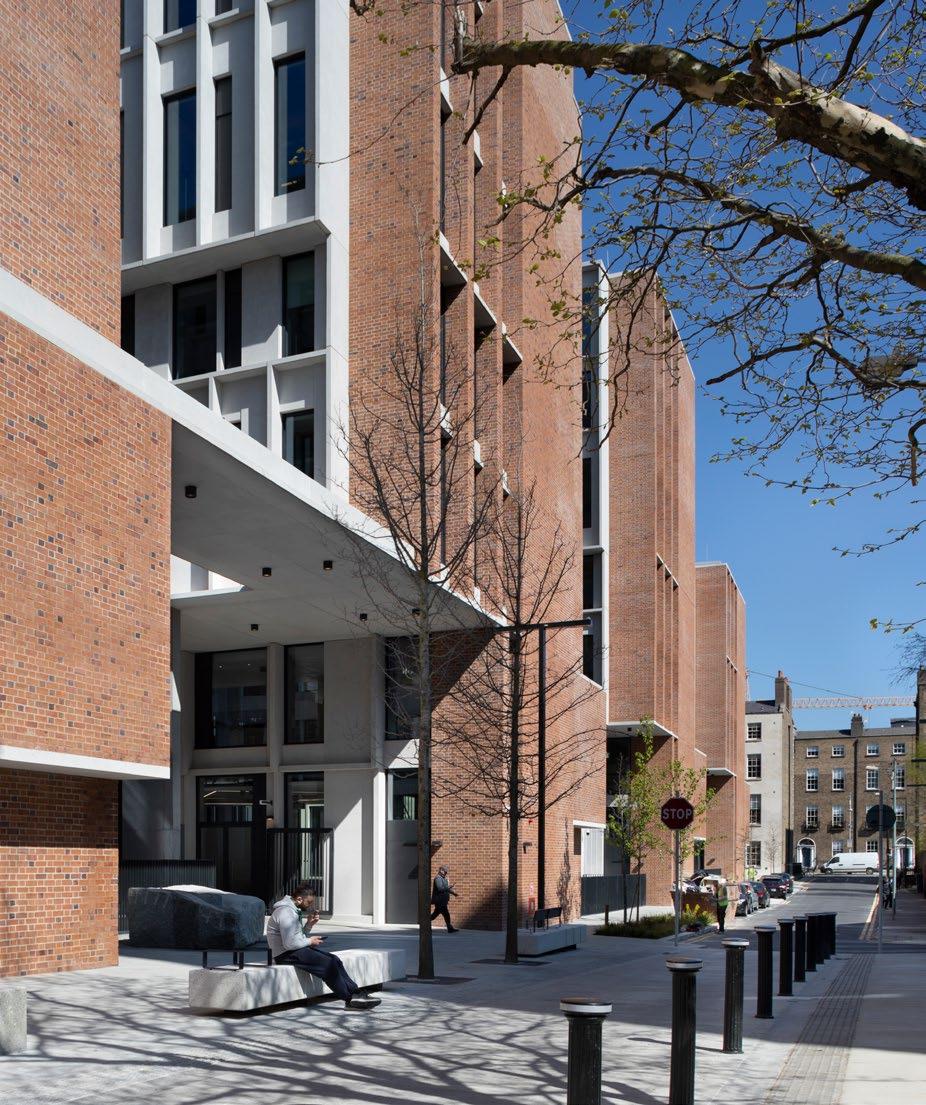
ph+ | ESB offices case study | 43 CASE STUDY ESB OFFICES
IN DETAIL
IN BRIEF
House type: 107 m2 bungalow
Method: Wood fibre insulated timber frame infrared heating

Location: Dumfries and Galloway
Standard: AECB CarbonLite Building Standard
Heating & hot water cost: £90/month*
* Estimated space heating and hot water cost, based on Ofgem’s energy price guarantee for October 2022.
See ‘In detail’ panel for more information.
£90 per month
VISIONARY VERNACULAR
PASSIVE-INSPIRED DUMFRIES HOME PUTS USERS FIRST
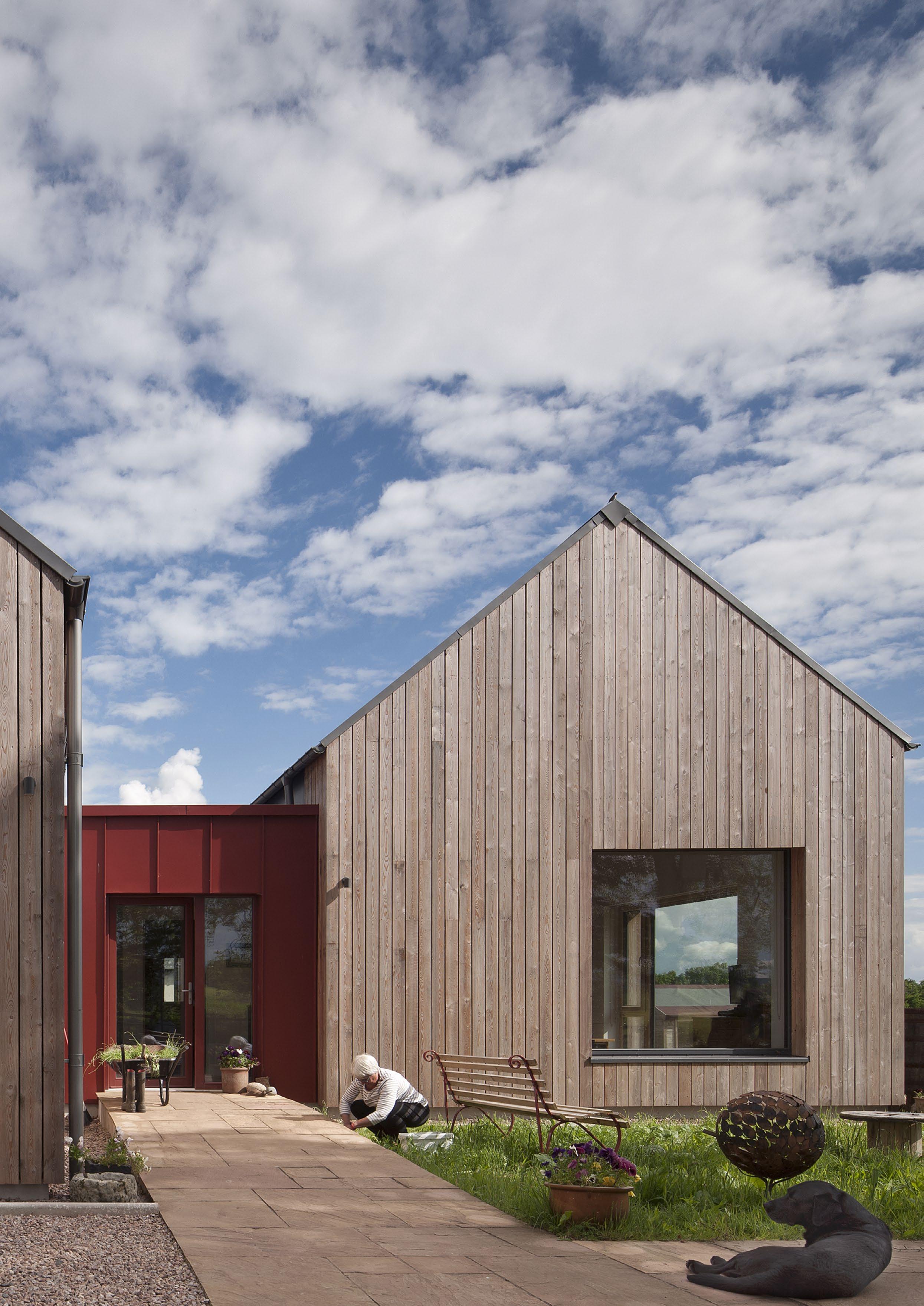
Can a low energy building be truly sustainable if it doesn’t fully consider its occupants needs? The latest offering from one of Scotland’s leading green designers uses passive house knowhow to signal the way to pragmatic, modest, occupant-centric architecture.
By John Cradden
45
It’s been shown clearly over the last few years that passive house design lends itself relatively easily to a variety of building forms thanks to the versatility of PHPP software.
But every so often, a combination of tight budgets and less than ideal form factors present a challenge that gives even those architects passionate about the standard a reason to rethink their approaches, without jettisoning the efficiency, sustainability, and attention to detail that fully certified passive houses demand.
Beechtrees, a lovely, modest larch-clad, zinc-roofed house in Scotland built by seasoned Dundee-based passive house designer Kirsty Maguire, is one such case.
It’s built to the AECB CarbonLite Building Standard, which is based on passive house and uses the same software (PHPP), but with less onerous targets for energy performance.
Located in a rural area in the middle of Dumfries and Galloway, a large region in the southwest corner of the country, it’s an unusual and innovative build that doesn’t try to ape a traditional farmhouse, but still strongly reflects the local vernacular of metal roofs and timber cladding of the neighbour-

ing farm buildings. The inspiration Kirsty Maguire took from around the site is infectious: the link building between the living and bedroom wings has the same colouring as “a beautifully weathered barn with a rust red roof,” and a similar nearby shed.
Built for two retirees, Tony Francis and Zoe Roberts, as their forever home, it’s also single-storey, meaning it will be easier for the couple to navigate in future years. That comes at an energy cost as it increases the building’s surface area to volume ratio or ‘form factor’. Future-proofing the house to allow for the occupants’ changing needs in this case means more walls, roof and ground floor per square metre, and therefore more surfaces through which heat is lost. The form factor is also not helped by the H-shaped floor plan, designed to give the couple two courtyards.
It’s designed essentially so that the external spaces are conceived as external rooms, as the clients spend a lot of time outdoors,” said Kirsty Maguire.
The courtyards each exploit the light at different times of day, a bit like a sundial. According to Maguire, the east courtyard, opening from the kitchen, is perfect for
sitting outside with a morning coffee. As the sun moves around, it hits the south side with the pond and vegetable garden, bathing the outdoor dining table in sunlight from late morning until evening. It has a generous living space with a cathedral ceiling in the main part of the building. The
46 | passivehouseplus.ie | issue 44
bedroom wing is similar but more private and set back, and there’s a welcoming entrance space linking the two.
What the whole space gains inside and outside as a result of this clever design is clearly worth the concession – if you can call it that – of building to the AECB CarbonLite Building Standard instead of passive house.

A quick look at the building fabric specs shows that Beechtrees has exactly what you’d expect to see in a passive house: the U-values for walls, roof, floor and windows, the thermal bridging and the airtightness, and the Zehnder heat recovery ventilation system. It also has infrared heating for the little warmth that’s required and an air source heat pump – using the ultra-low global warming potential (GWP) refrigerant R290 – for hot water.
Named after the mature deciduous trees from the site, Beechtrees is all about timber. As many trees were retained as much as possible, with the felled trees being turned into cills and shelving by a local craftsman. The building’s superstructure is timber frame, with Steico wood fibre insulation in walls and roof, and triple glazed timber windows. The project’s broader sustainability efforts extended into other materials too. Reclaimed materials are used as well, such as paviours, and the drystone dyke

was rebuilt by Tony using stone from site.
It’s reasonable to argue that if the budget was more flexible, a greater investment in wall insulation, for instance, could have brought the overall energy performance closer to the passive house standard, but other choices took priority, according to Maguire.
“That relationship to the [external] spaces on the site was really key to the layout of the building,” she said. “As a result, we’ve got these two wings and a link, which does make the form factor higher, and therefore there’s a point in time where you can keep putting more and more insulation in but there’s a balance [to be struck]. And that’s where we used PHPP – to start to identify where that balance is, and where you can still get good performance.”
The wall insulation in Beechtrees is far from skimpy, with 240 mm of Steico Flex wood fibre insulation fitted between the timber frame, with a further 100 mm of Steico Special Dry wood fibre boards wrapping the frame externally, delivering a U-value of 0.127. Nonetheless the design allows for more: an extra layer of insulation could be installed very easily by simply removing the timber cladding at some point later, giving this dwelling a highly satisfying degree of cheap and easy future-proofing.
Besides the lower energy targets, the key difference between the AECB and the pas-
sive house standard is around certification. In a nutshell, certification for a passive house can only be awarded by an independent certifier, while the AECB relies on self-certification by the designer or consultant.
According to the AECB website: “The AECB self-certification process is designed to make explicit the project’s claim to be a low energy design and to provide the consumer with a degree of protection under trading standards – without the AECB having to get involved in quality control
ph+ | beechtrees case study | 47 CASE STUDY BEECHTREES
WANT TO KNOW MORE? The digital version of this magazine includes access to exclusive galleries of architectural drawings. The digital magazine is available to subscribers on passivehouseplus.ie & passivehouseplus.co.uk
Tony and Zoe were adamant the house shouldn’t be too big for their needs or have any wasted space, and no clutter. “We have no space that’s underutilised, and no junk”.
and legal matters.
“This approach puts the responsibility for performance claims clearly with the person signing the certificate and a duty of care on the client to ensure that the consultant is competent and suitably insured.”
Kirsty Maguire herself is a big advocate
of passive house certification, and recently undertook passive house certifier training, becoming the only Scottish-based consultant to have this. Having designed several certified passive house projects over the last decade, Kirsty says with Beechtrees she made sure the quality assurance process was
the same, along with the details and the general approach to the project.

Which was surely music to the ears of Tony and Zoe, who were introduced to the passive house concept by their daughter, and were inspired enough to make enquiries that quickly led them to Maguire’s door and the start of an in-depth but by all accounts very amicable and free-flowing discussion about what they wanted. Their brief was for an environmentally sustainable and warm home that maximised the access to the outdoor space around the site so that they could enjoy the garden and walk their dogs and entertain family, and also recycle as many of its elements as possible.
“There were quite a lot of things we put on the brief,” says Zoe, “such as being able to have the doors open when we’re cooking, and positioning the house so we could make the most of the private bit of garden… we needed a mud room for the dogs – a place where three filthy Labradors can go and shake.”
They were also adamant that the house shouldn’t be too big for their needs or have any wasted space. “I think we were very keen to have no clutter. We were ruthless before we moved in about throwing things out that hadn’t been used. And thankfully we have no space that’s underutilised, but neither do we have any junk.”
Kirsty’s experience and a highly communicative approach to working with Zoe and Tony, allied with the enthusiasm and commitment of a local contractor undertaking one of his first passive house-in-
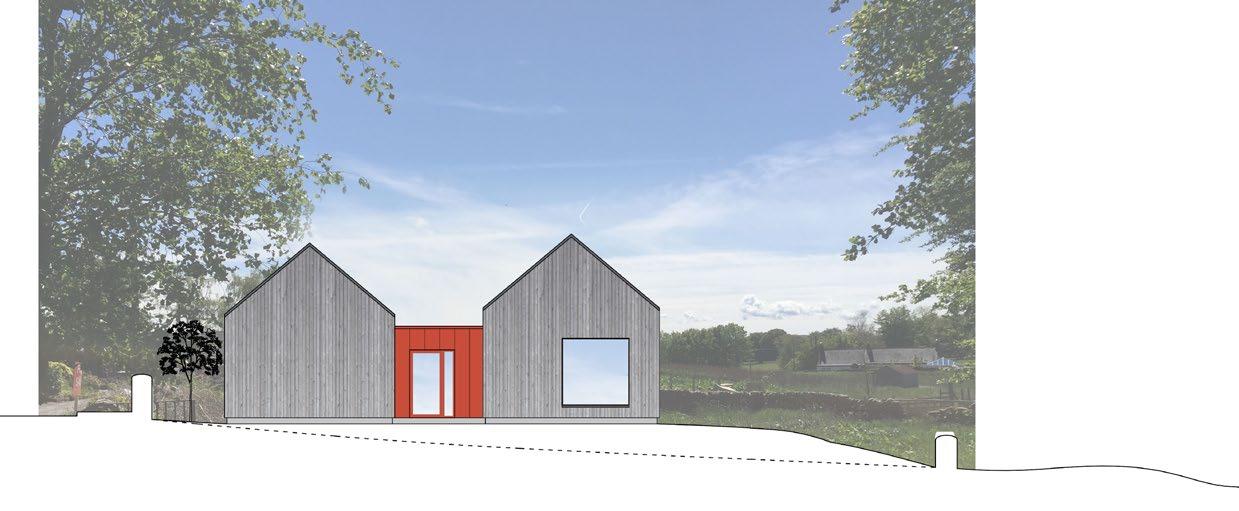
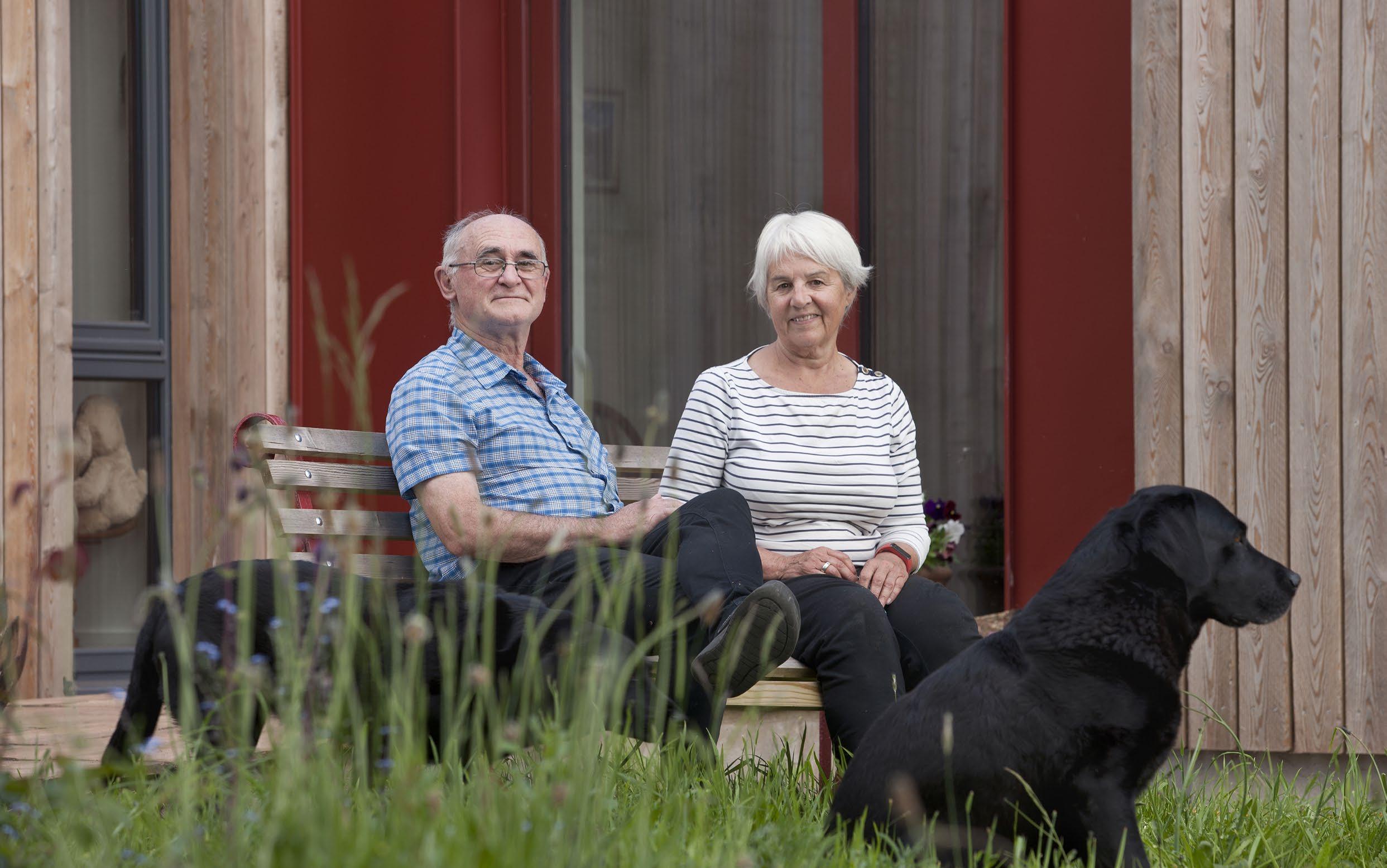
BEECHTREES CASE STUDY
North east elevation
North west elevation
formed projects, meant that Beechtrees succeeded – even exceeded – expectations in terms of meeting their quite specific demands.
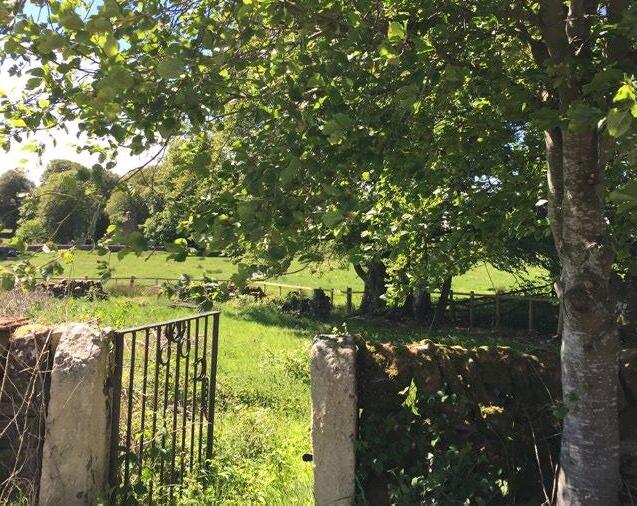
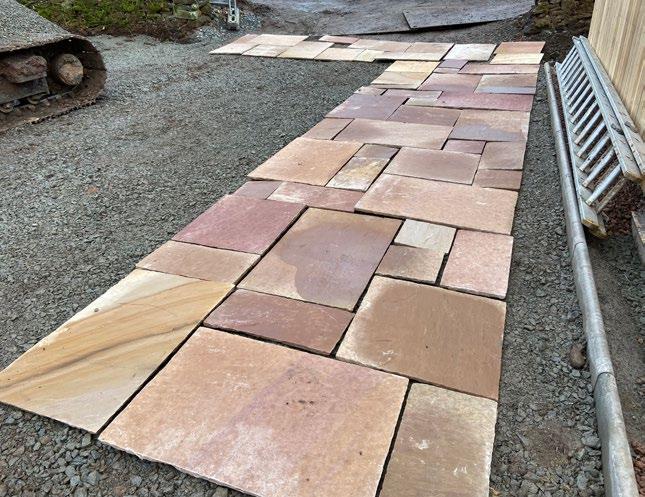
“Kirsty is so kind of efficient and pedantic, in the nicest possible way, about detail that she and her assistant really pushed us hard to make decisions before it even got out of the ground, such as things about light switches, outside lights, positioning of inside lights, colour of the kitchen, colour of the tiles,” said Zoe, who even admits to
getting a “wee bit stressy” about it as the process went on, “but oh my goodness, did we realise the value of that during the build”.
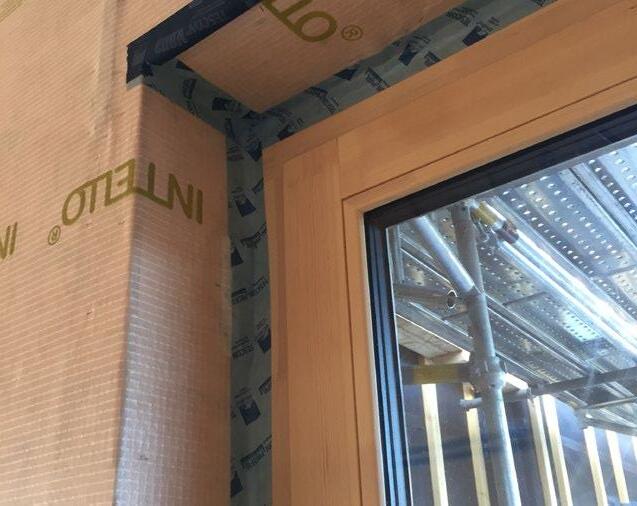
They’re also full of praise for Kirsty’s choice of contractor, David Broatch of Broatch Construction, a firm based just 20 miles away, even though he had limited previous experience of working on passive houses.
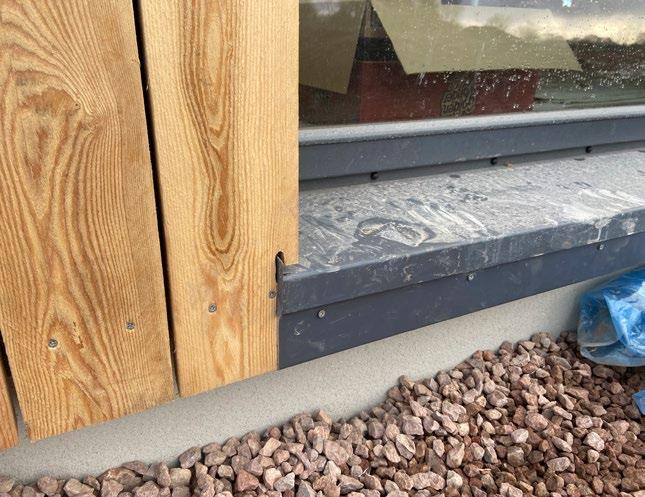
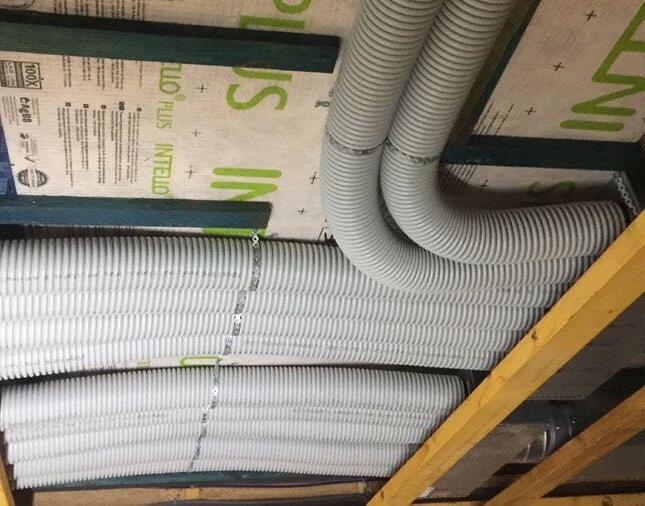
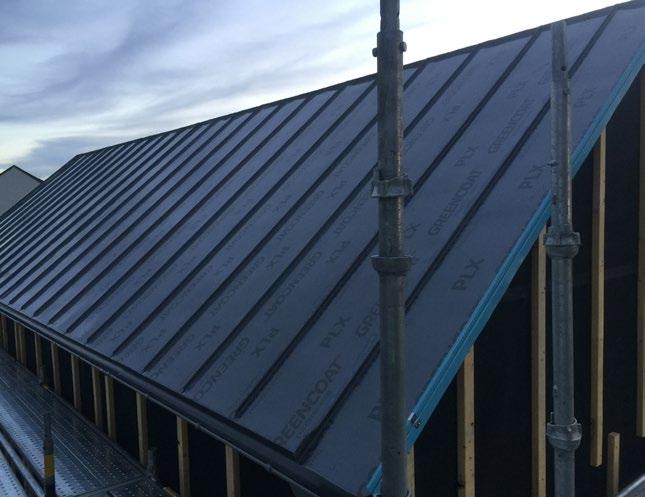

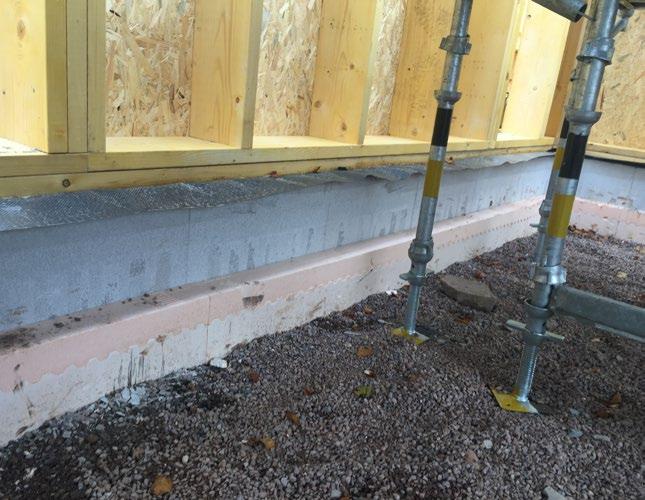
“They had never built a house like this before, and... Kirsty must have had some intuition about them,” said Tony, who was sceptical that they would take on the job with the limited budget they had, “but she was right. They really wanted to get it right. And they concentrated so hard on doing that.”
It was clearly a transformative experience for Broatch, because he has gone on to completely change his business focus as a result of this project, heading into passive house in a big way. The firm has recently completed building a home for the daughter of wellknown passive house architect Jonathan Hines, managing director of Architype, on the strength of Kirsty’s recommendation.
Adding to the highly positive build experience was the efficient sourcing of ma-
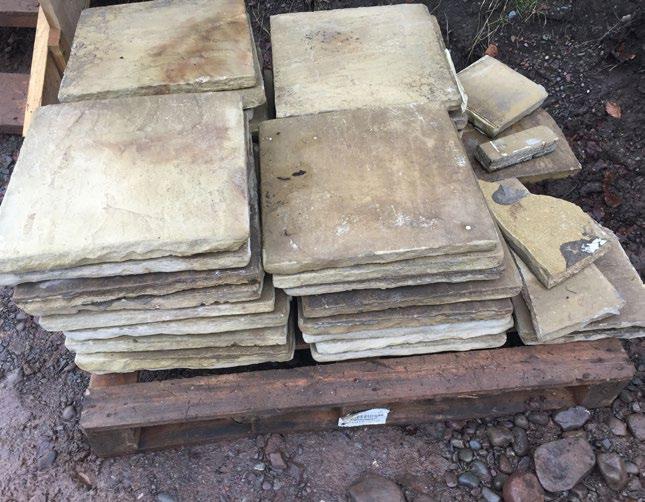
terials just before the chaos of the Covid pandemic, so that the only supply issue was bathroom tiles, which Tony and Zoe sourced elsewhere in order to keep to the schedule. Only the windows and doors were a little late, but this added just three weeks to the projected 16-week build time.
The choice of timber frame construction was a simple decision given timber frame’s dominant position north of the border, so expertise and skills were easy to find. “We’ve got obviously great joiners across everywhere who are familiar with it so it’s a sort of standard way of doing things up here for buildings at this scale.
Kirsty also describes Beechtrees as a bit
ph+ | beechtrees case study | 49 CASE STUDY BEECHTREES
2 1 8 3 7 9
1 The house is named after the mature deciduous trees from the site; 2 Isoquick insulated foundation system and timber frame; 3 400 mm Steico Flex wood fibre insulation in the bedroom wing; 4 airtightness taping at window; 5 heat recovery ventilation ducts in void inside airtight layer; 6 threshold detail; 7 & 8 salvaged tiles; 9 Greencoat PLX standing seam roofing system.
5 4 6
We needed a mud room for the dogs –a place where three filthy Labradors can go and shake.
Drone photography: Ali Yassine
hab

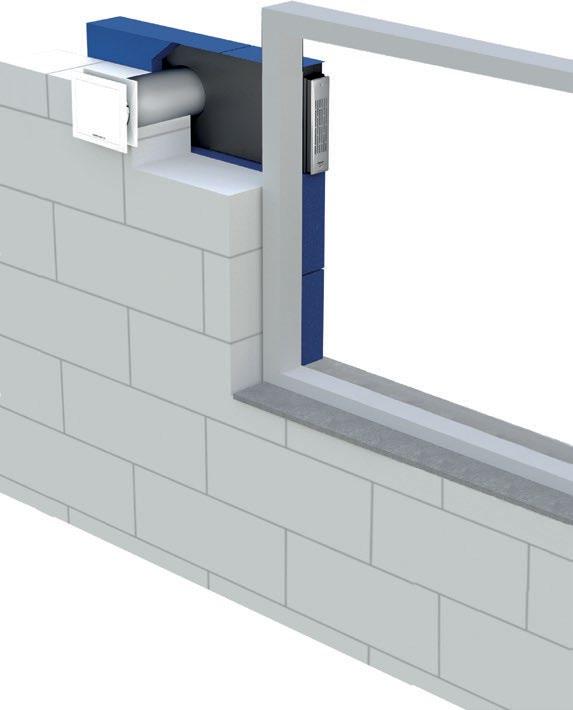
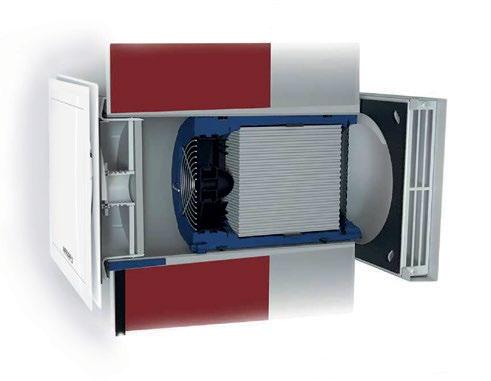
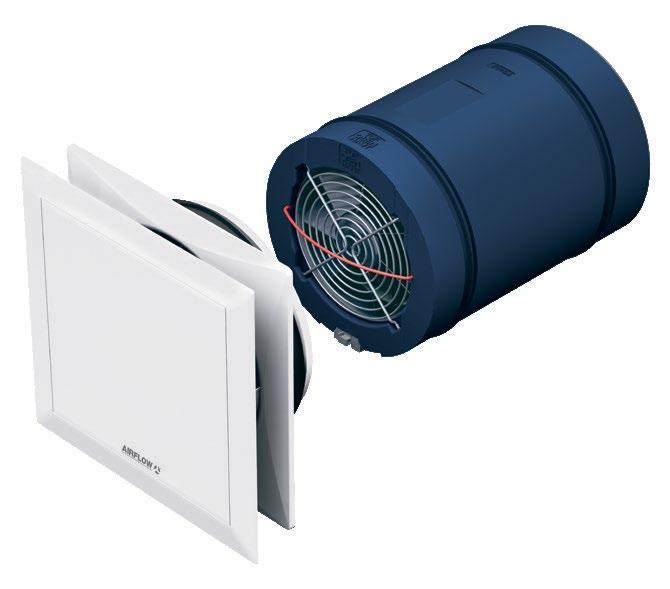

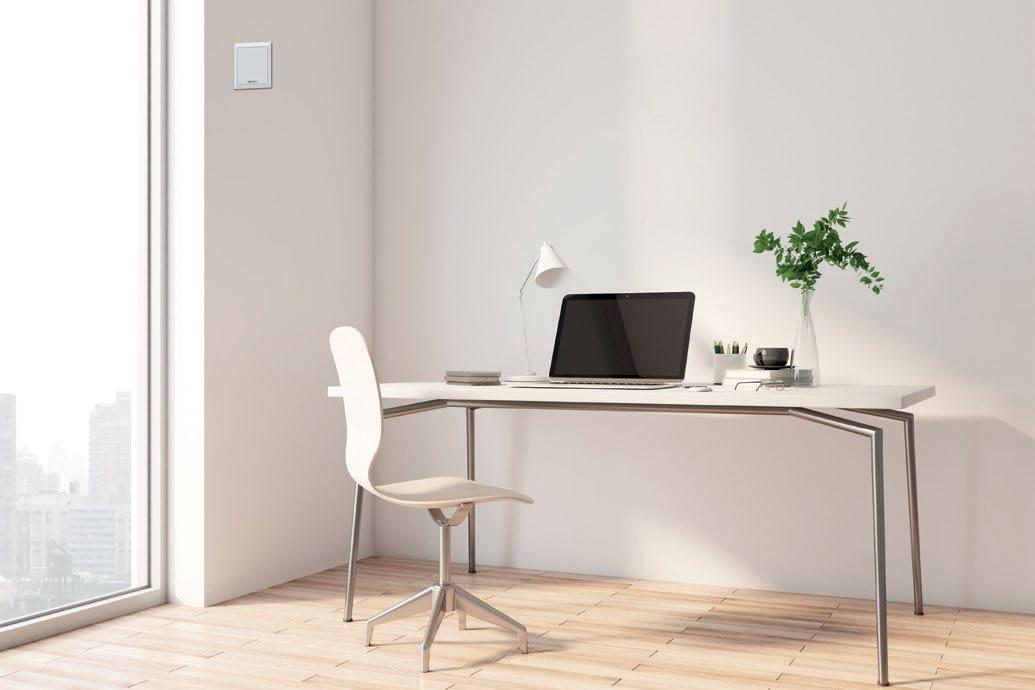




50 | passivehouseplus.ie | issue 44 BEECHTREES CASE STUDY
of a dream project. “We had great clients, really fantastic to work with, really good at making decisions, and great ideas. We also had really good colleagues in the design team so we could work together quickly in a straightforward way.
“And then working with the contractor was fantastic,” she added. “They would come to us with the potential of how to make things even better than we had so we can learn from them as well and keep that discussion flowing. The work that they did was in accordance with drawings and beautifully done, and it was on time, on budget during Covid. I’m not quite sure what more we could have asked for really.”
It’s rare that a client is less than delighted with any project worthy of being featured in this magazine, but Tony and Zoe exude
a particular pride in what their two-bed home represents in terms of its modesty, efficiency, sustainability and, above all, a dwelling that’s tailor-made for them right down to the last detail and with no attic or any kind of wasted space. And of course, a very comfortable home.
Having lived all their lives in old houses with nooks and crannies, big sandstone walls that Tony describes as “just big sponges full of water”, they now live in an “almost perfectly controlled environment”.
“We’ve got the air circulation system in the heat exchanger, which brings in fresh air, collects the warmth from the house and pumps out the stale air. We’ve got fresh air to breathe; even if we don’t open a single door or window, we’ve got lovely fresh air, of the right temperature.”
SELECTED PROJECT DETAILS
Client: Zoe Roberts and Tony Francis
Architect: Kirsty Maguire Architect Ltd
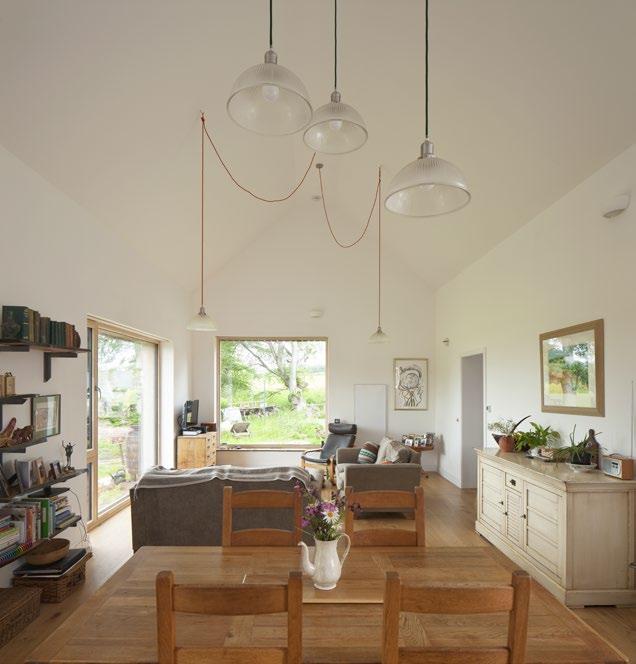
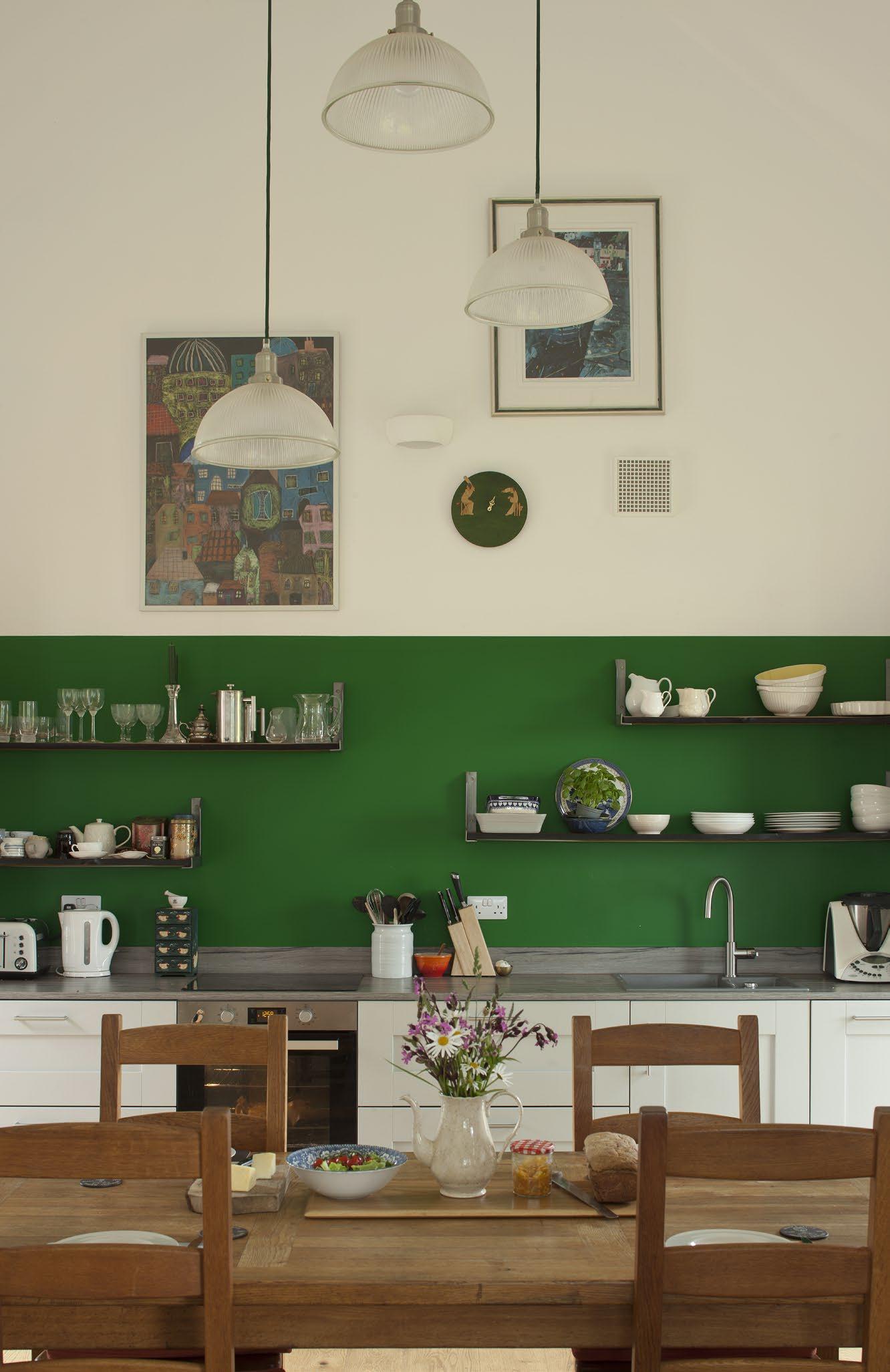
M&E engineer: Luths Services
Civil/structural engineer: Narro Associates
Energy consultant: Kirsty Maguire
Architect Ltd
Main contractor: Broatch Construction
Quantity surveyors: McGowan Miller
Construction Consultants
Mechanical contractor: Paul Heat Recovery Scotland
Airtightness tester/consultant: Thermal Image UK
Wood fibre insulation: Steico, via Ecomerchant
Insulated foundations: Isoquick
Airtightness products: Ecological Building Systems
Windows and doors: Green Building Store
Flooring: Howdens
Roofing: Greencoat PLX
Infrared panels: Trotec
Hot water heat pump: Vaillant
Mechanical ventilation: Paul Heat Recovery Scotland
Heating controls: Heatmiser
They’re particularly pleased with the work of a local furniture maker, Philip Wilson, who cut down the beech tree that obviously inspired the house’s nomenclature and then created beautifully rustic shelves and windowsills with the wood, all finished with a very distinctive blue resin. “It’s terribly, terribly original and just so beautiful to look at.”
Viewed purely from an energy performance perspective, Beechtrees could have pushed the envelope a little more with still more insulation or a more compact form. But energy performance and thermal comfort are not the only requirements to consider, and this thoughtful, skilfully designed house makes a strong case for allowing a little leeway, and is tailored to meet the needs of its owners throughout their later years.
ph+ | beechtrees case study | 51 CASE STUDY BEECHTREES
For 220417 - Firebird Aug Ads – Passive House AW.pdf 1 18/08/2022 12:20

Your


We guarantee a stress-free installation process, with a home heating consultation and backup service from qualified experts that you can trust.
Enviroair Air Source Heat Pump


• High performance levels and space saving.
• Economical and environmentally friendly.
• Ideal for newbuilds or home upgrades.
• Comfort all year round.
Enviroair Underfloor Heating
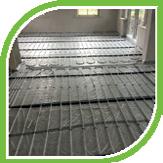
• 25% more efficient than traditional radiators.
• Ideal for well insulated, low energy homes.

• More space and design freedom.
• Safety and comfort.
Envirocyl Quick Plumb Unit

• For all your hot water requirements – ideal for multiple bathrooms.
• Cuts onsite installation time by around 70%, reducing the amount of disruption to the customer.
• Mains pressure hot water for fast filling baths and powerful showers.
Enviroair Ventilation

• Improves the indoor air quality.
• Can recover up to 90% of normal wasted heat.
• Reduces your heating costs.
• Eliminates mould, mildew, and combats condensation.
t:
52 | passivehouseplus.ie | issue 44 BEECHTREES CASE STUDY
New Build or Home Upgrade
For a free home heating consultation email your plans to sales@firebird.ie +353 (0)26 45253 | e: sales@firebird.ie | www.firebird.ie
consultancy Specialists in Passive House Airtightness Greenbuild Inch, Gorey, Co Wexford. t: 087 252 1032 e: contact@greenbuild.ie www.greenbuild.ie
testing &
Building type: Single-storey detached property.
TFA 107 m2
Site type & location: Site in a hamlet on the outskirts of Thornhill village, Dumfries and Galloway

Completion date: February 2021
Budget: £261,000
Number of occupants: 2 adults and 3 dogs
Energy performance standard: AECB
CarbonLite Building Standard
Space heating demand (PHPP): 32 kWh/m2/Yr
Heat load (PHPP): 17 W/m2/yr
Primary energy renewable (PHPP): 87 kWh/m2/yr
Heat loss form factor: 5.5
Overheating (PHPP): 2 per cent of year above 25 C
Energy performance certificate (EPC): B82
Airtightness: 0.42 ACH @50pa
Embodied carbon: Not calculated. Similar to Dundee passive house published in issue 38 of Passive House Plus, although without the PV array.
Energy costs: Total metered electricity usage in first year for all uses of 6,087 kWh. Assuming the current average electricity energy guarantee for Great Britain of 34p per kWh of electricity, with a daily standing charge of 46p, the total household energy bill for all uses would be £2,237/yr. As metered data wasn’t available on space heating, two options were available for deducing heating use: the PHPP-calculated space heating demand of 32 kWh/m2/yr multiplied by the building’s treated floor area, which would translate to 3,424 kWh/yr for space heating alone – a figure that is likely too high, given the measured whole building total of 6,087 also includes hot water, fans, lighting and all unregulated loads (i.e. plug loads). Therefore, Ofgem UK average electricity use for a two or three-person home of 2,900
kWh/yr (for homes with gas heating) was instead deducted from the measured total, leaving an estimated total for heating and hot water of 3,187 kWh. This comes to a total of £90 per month for space heating and hot water.
Thermal bridging: Not modelled due to costs, so punitively high values were used in modelling to be conservative. Key thermal bridging mitigation measures included an insulated slab with edge detailing, wood fibre insulation layer external to the timber framed walls and roof, windows overclad with insulation on the frame, and rainscreen cladding meaning no blockwork or ties. Thermal bridges through fabric were avoided through design.
Ground floor: 200 mm reinforced concrete slab; 250 mm Isoquick insulated foundation system; Visqueen CPT DPC (jointed to DPM and lapped up over sides of 2-layer 100 mm Isoquick insulation upstand at perimeter); 50 mm screed; Howden’s engineered oak flooring. U-value: 0.095
Walls: 12.5 mm plasterboard; 50 mm uninsulated service void; Pro Clima Intello Plus airtight membrane; 9 mm OSB racking board; 240 mm timber frame fully filled with Steico Flex wood fibre insulation (140 mm + 100 mm); 100 mm Steico Special Dry wood fibre board; 50 mm vented cavity; locally sourced larch timber cladding on battens and counter battens.
U-value: 0.127
Living wing roof: Pitched roof cathedral ceiling featuring 12.5 mm plasterboard; 50 mm uninsulated service void; Pro Clima Intello Plus airtight membrane; 9 mm OSB; 300 mm I-joist rafters fully filled with Steico Flex wood fibre insulation; 100 mm Steico Special Dry wood fibre board; 50 mm vented cavity; 23 mm softwood sarking board; Isomat Pro membrane; Greencoat PLX standing seam roofing system. U-value: 0.110
Bedroom wing: Trussed roof featuring 12.5 mm
plasterboard ceiling; 100 mm service void to allow for MVHR ductwork; Pro Clima Intello Plus airtight membrane; 9 mm OSB; 400 mm Steico Flex wood fibre insulation (4 x 100 mm batts, laid perpendicularly) between trusses; with ventilated cold roof above. Pro Clima Quatro membrane to lap between trusses and over 300 mm of Steico Special Dry wood fibre board where wall extends into roof space; 100 mm Steico Special Dry wood fibre board. Roof trusses on pitch; 23 mm softwood sarking board; Isomat Pro membrane; Greencoat PLX standing seam roofing system. U value: 0.097
Flat roof (above entrance hallway and utility): Warm roof featuring 12.5 mm plasterboard; 200 mm service void; Pro Clima Intello Plus airtight membrane; 9 mm OSB; 175 mm timber rafters; 18 mm plywood deck; Visqueen vapour barrier; 200 mm PIR insulation; 18 mm plywood deck; and Sika Trocal Type S membrane, with waterproofing lapping up to the wood fibre in the adjacent wing roof sections. U-value: 0.117
Windows & external doors: Green Building Store Performance range timber windows and doors with uninsulated frames. Class 4 airtightness ratings, and FSC certified pine. Uw-value: 0.85
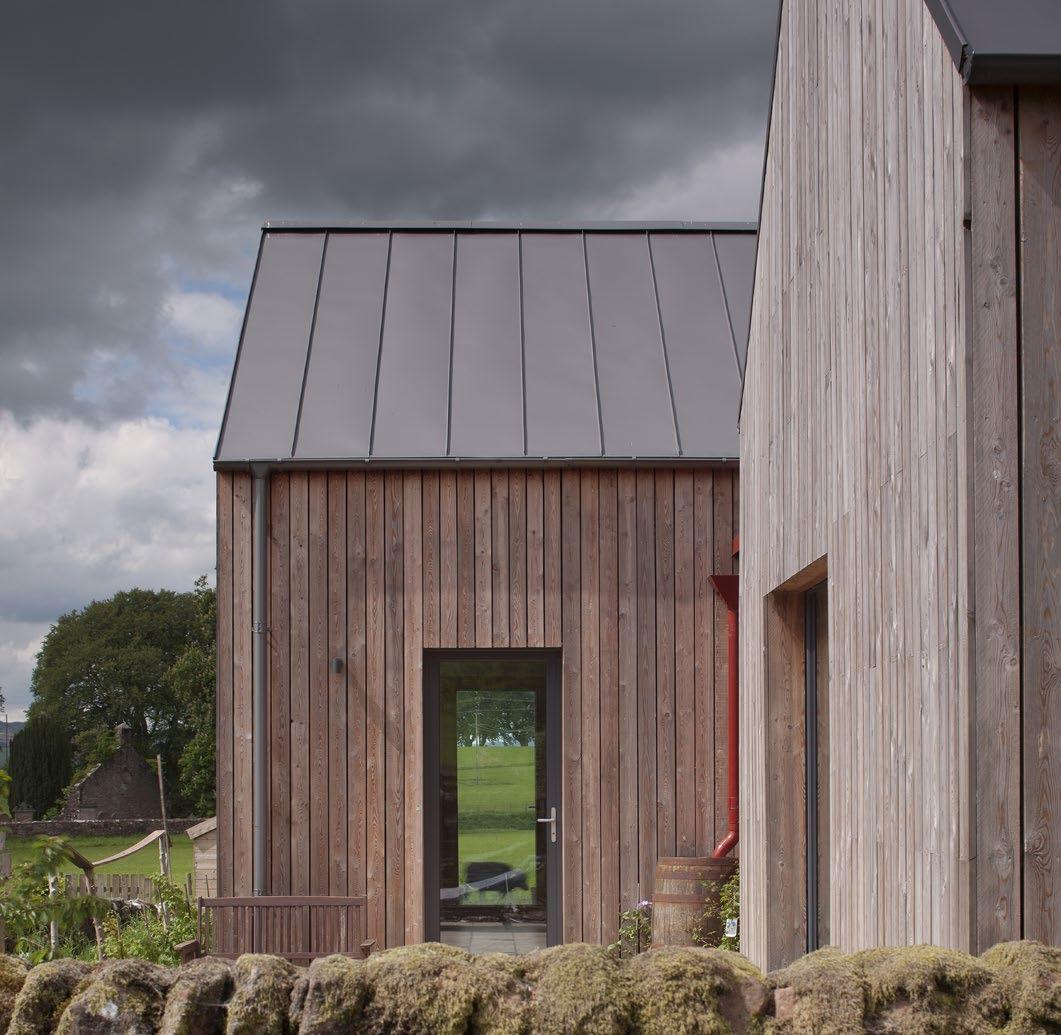
Heating system: Trotec infrared heating panels, with a Vaillant Arostor 200 domestic hot water heat pump for hot water only.
Ventilation: Zehnder ComfoAir 350 heat recovery ventilation system. Passive House Institute certified efficiency at 84 per cent.
Water conservation: Water butts for rainwater harvesting from roof for garden. Low flow rate taps, WC and showers.
Sustainable materials: Timber frame, wood fibre insulation, reused/recycled paving slabs, beech from tree on site used in joinery finishes from local craftsman, rebuilt drystone wall in the garden.
ph+ | beechtrees case study | 53 CASE STUDY BEECHTREES
IN DETAIL
IN BRIEF
House type: 262 m2 barn conversion
Method: Cellulose-insulated timber frame, heat pump
Location: Somerset
Standard: Certified passive house classic

Heating cost: £28/month*
* Estimated space heating demand, based on Ofgem’s energy price guarantee for October 2022. See ‘In detail’ panel for more information.
£28 per month
54 | passivehouseplus.ie | issue 44 SHU ARCHITECTS CASE STUDY
MILITARY PRECISION
WEST COUNTRY BARN CONVERSION BRINGS LOW CARBON COMFORT FOR ARMY FAMILY

Designing a building to the passive house standard for the first time is one thing. But trying to do so when the client is a soldier, the design must accommodate the frame of a barn, and you’re straining to get it built precisely on schedule, during a pandemic, is quite another.
By David W Smith
ph+ | shu architects case study | 55 CASE STUDY SHU ARCHITECTS
The trickiest challenge was building a roof inside an existing building. “We were worried about having enough space for the drills, but the builders said: ‘that’s fine. We can crawl into the gaps.’”
With a husband in the army, for years Amelia Taylor lived a peripatetic life, often housed in cramped, draughty military accommodation that could be a dispiriting experience. During this time, she and husband Mike dreamed of owning their own spacious, comfortable home. Now, living in her “slice of paradise,” in the couple’s certified passive house barn conversion on the family farm in Somerset, Amelia reflects on the contrast
with army digs.
“We moved around a lot in the army and, although we had one or two nice places, a lot were dreadful. We had pink carpets and terracotta tiles, and banging pipes. At times it was cold and draughty,” she says. “What I dreamed of was living in a house with lovely clean spaces. After sleeping in army digs, I wanted an en suite bedroom that looked like it was in a hotel, and we needed space for our two daughters, now nine and eleven, as the family grew.”
One of Amelia’s main stipulations for the 262 m2 house was constant warmth, and in that regard, the house delivers in spades. “It’s the dream,” she says. “You get out of bed, you don’t have cold feet. There’s no cold spots. You don’t have to worry about layering up. I always wanted a house you could pad around in and feel warm without putting your shoes on. When I go into someone’s house and it’s cold it’s my worst nightmare.”
Living up to its passive house classic certification, the home hasn’t required heating even on the coldest days in the West Country. “It’s incredible. Even when the temperature fell to -3 C around Christmas, we didn’t even use the heat pump as it was still 19 C in the house, not much cooler than the usual 21 C,” she says. “We’d planned to install underfloor heating, but the architect talked us out of it as it would have been far too hot.”
In summer, when the temperature rose to record highs, Mike was too hot at night. But the couple found that opening two windows, at either side of the house, solved the issue. There is also the option during the day to open sliding doors on both sides of the open-plan living area, and the architect specified a Zehnder heat recovery ventilation system, on the basis that a cooling module can be added at a later date if necessary.
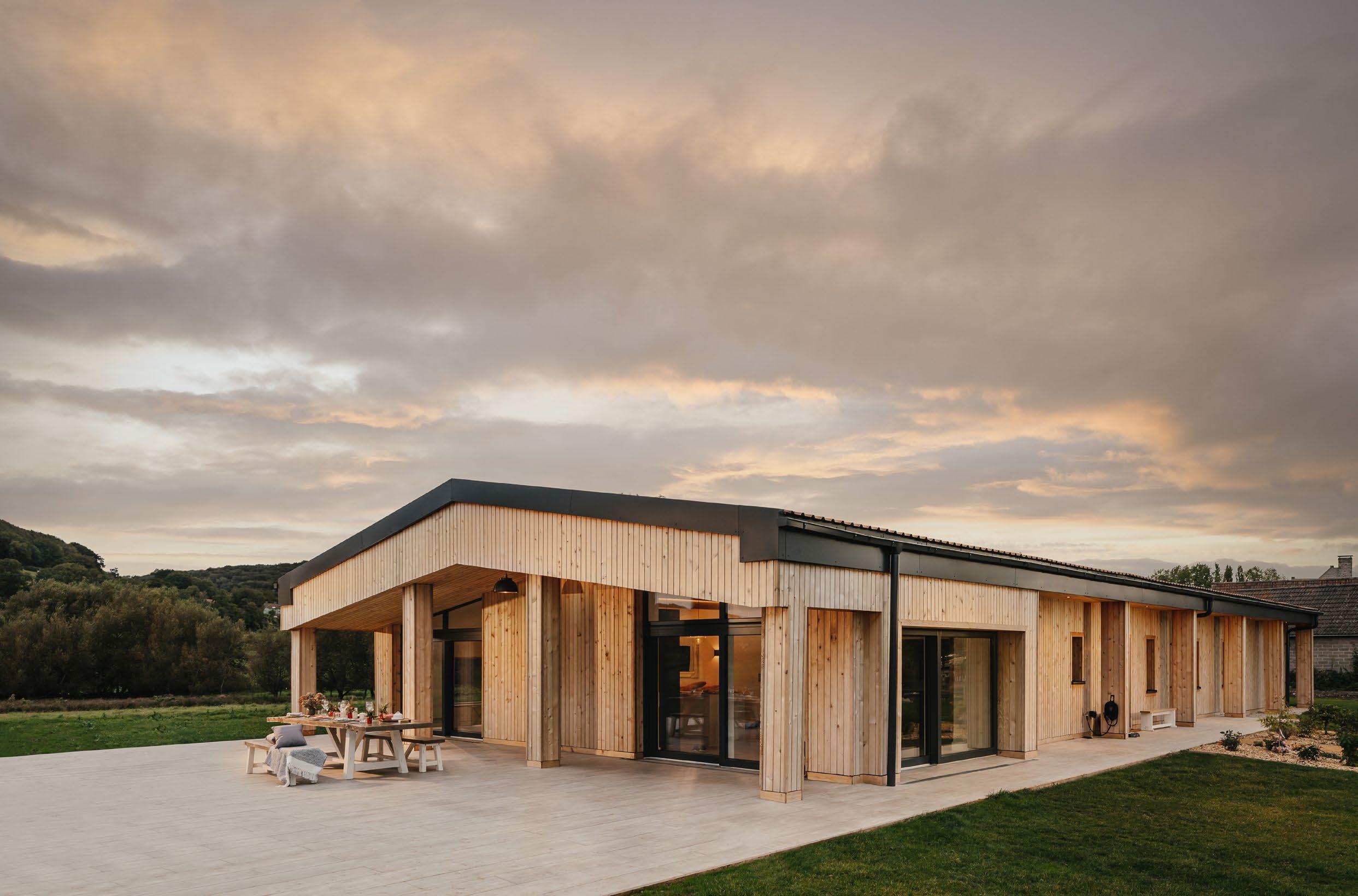
The idea of converting the large cattle barn came from Amelia’s father six years ago. While walking around the farm with his daughter, he pointed at the barn and asked her if she felt it would make a lovely house. Amelia had grown up on the farm and had a sentimental attachment to it. The couple, who were in army headquarters 20 minutes’ drive away in Bristol, began to envisage it emptied of agricultural equipment and remade into a beautiful home.
Project finance was secured via Ecology Building Society, whose C-Change mortgage offered the couple a 1.5 per cent discount on the lender’s standard variable rate for building to the passive house standard. “Ecology were brilliant,” says Amelia. “The passive house discount made all the difference when we compared to all the other lenders who didn’t seem to give two hoots about passive house.”
Sadly, during the construction of their
56 | passivehouseplus.ie | issue 44
house, Amelia’s father was diagnosed with Alzheimer’s and she says it is a “godsend” to be able to live on the site. She cooks him three meals a day and can check up on him regularly. The farm business, meanwhile, has been diversified and the family no longer takes care of animals. Amelia manages the rental of residential properties, as well as land to other farmers to graze sheep and cattle.
Planning refusal
But in 2018, when the couple’s application for a Class Q Permitted Development was refused by North Somerset Council, their settled home life seemed a distant dream. It took a two-year battle with several twists and turns and three applications, to win planning permission, which came, finally, in February 2020. “The main issue was it was a working farm and they had worries about health and safety. They also had problems with the impact of the noise and smells from the animals and the noise of the machinery. We had to have a noise survey done and then enclose the area with a wall. Some of it I found a bit ridiculous,” she says.
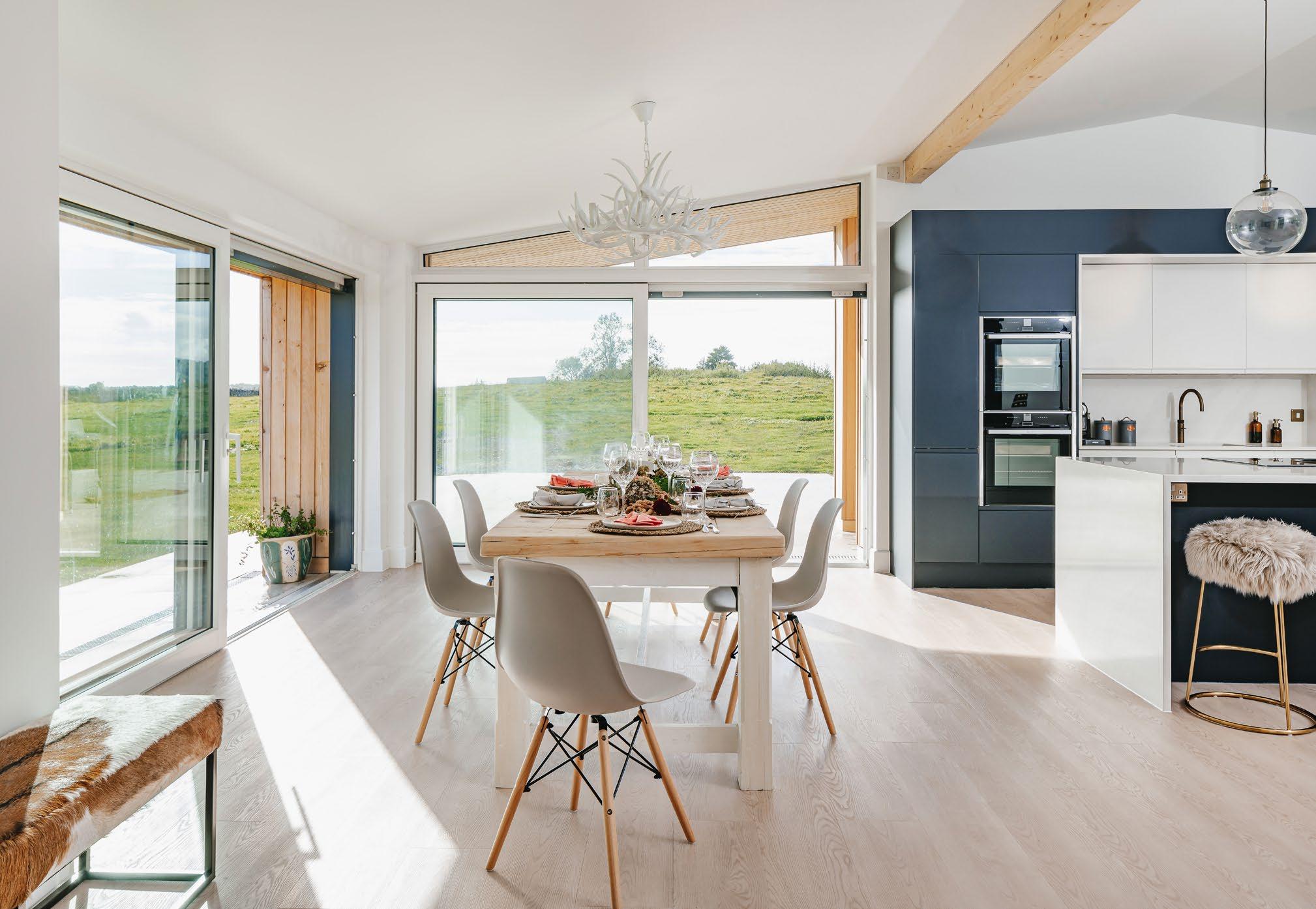
“Other objections were around an archaic document that said the barns could never be converted into residential properties. We had a brilliant planning consultant who fought every point methodically and we got there in the end. We earned planning a week before my 40th birthday and had a fantastic meeting on site on my birthday, when we
were introduced to Claire Humphreys and Geoff Smith, from the newly created Bristol company Shu Architects, who designed it for us.”
Mike, who was passionate about keeping bills down and future-proofing, wanted to build a passive house from the start and the couple visited the National Self Build and Renovation Centre, in Swindon, to find out more. The planning consultant introduced them to Shu Architects which had recently been founded, offering passive house design among its architectural services – Shu co-owner Geoff Smith had just completed his certified passive house designer course in London. As it was his first passive house, he waived the fee for the passive house elements and used the project as a proving ground.
“I was fortunate on my first one to have friendly and pragmatic clients. Mike was clear from the start that, even when we were having a value engineering exercise, nothing could affect the passive house element,” Geoff said. “Amelia was on site every day, but she didn’t suggest any crazy design changes, which happens with a lot of clients.”
As Shu Architects hadn’t worked on a passive house project before – let alone a passive house barn conversion – Geoff sought specialist assistance, tapping into two formidable experts: Beth Williams from sustainable structural engineers Build Collective to assist with passive house design, with Greengauge providing building
services design and building physics support. “As it was my first one I wanted that support as a lot of the numbers are highly complex,” he said.
Part of the deal for planning permission was to demolish the most rickety of the farm’s three barns, as well as move another barn opposite to the family house and put a new roof on it. Elements of the demolished barn, such as the cladding and wall panels, were recycled and used again in the new barn.
The couple had clear ideas about what they wanted. Mike insisted on a large gym, which Geoff says is “as well-equipped as a professional one”. Both required home studies. Mike is still in the army, but Amelia uses
ph+ | shu architects case study | 57 CASE STUDY SHU ARCHITECTS
WANT TO KNOW MORE? The digital version of this magazine includes access to exclusive galleries of architectural drawings. The digital magazine is available to subscribers on passivehouseplus.ie & passivehouseplus.co.uk
It’s incredible. Even when the temperature fell to -3 C around Christmas, we didn’t use the heat pump as it was still 19 C in the house.
Photos: Brett Charles Photography | Construction photos: Shu Architects/Make
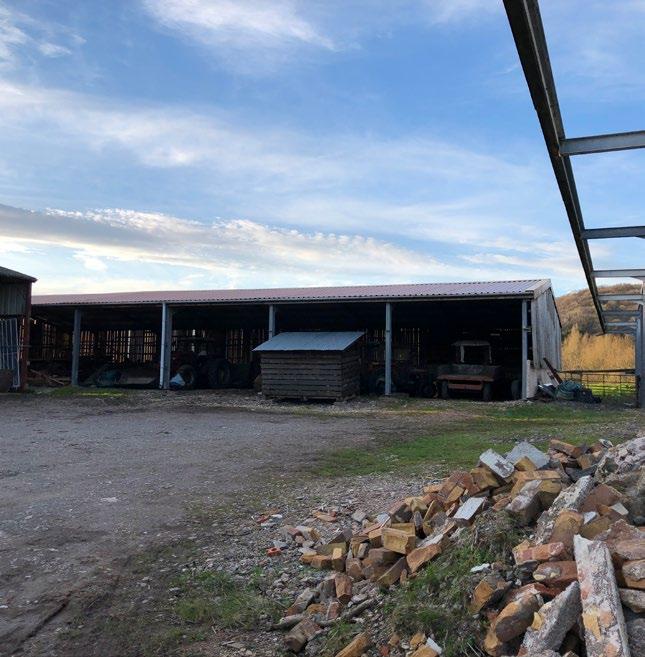


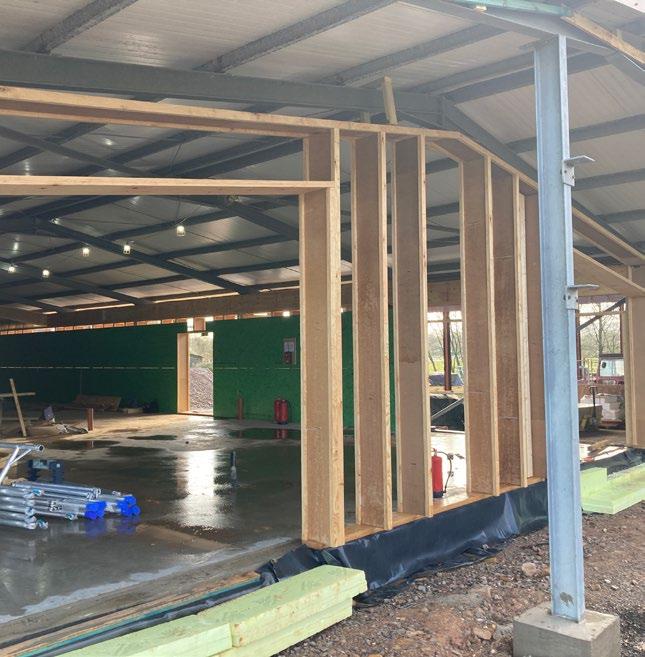

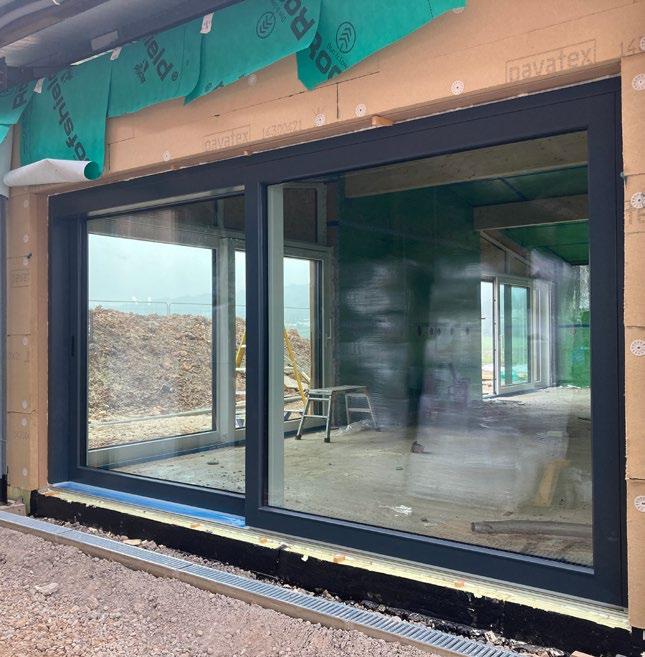

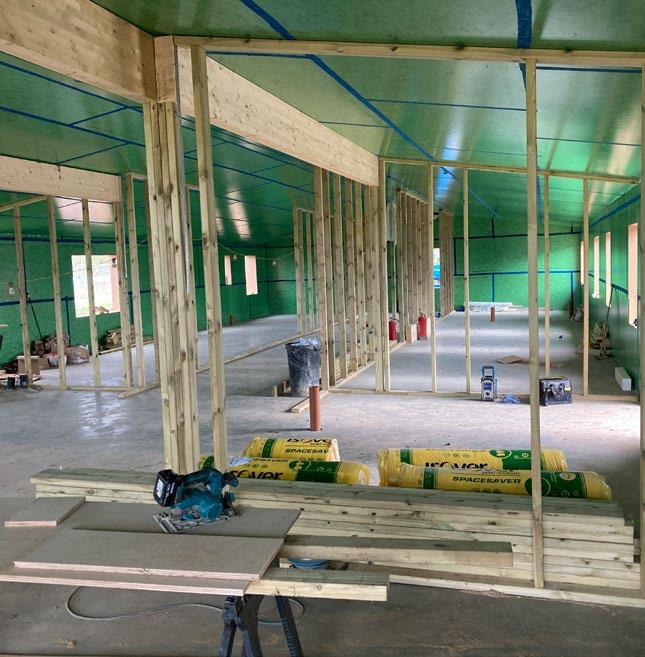
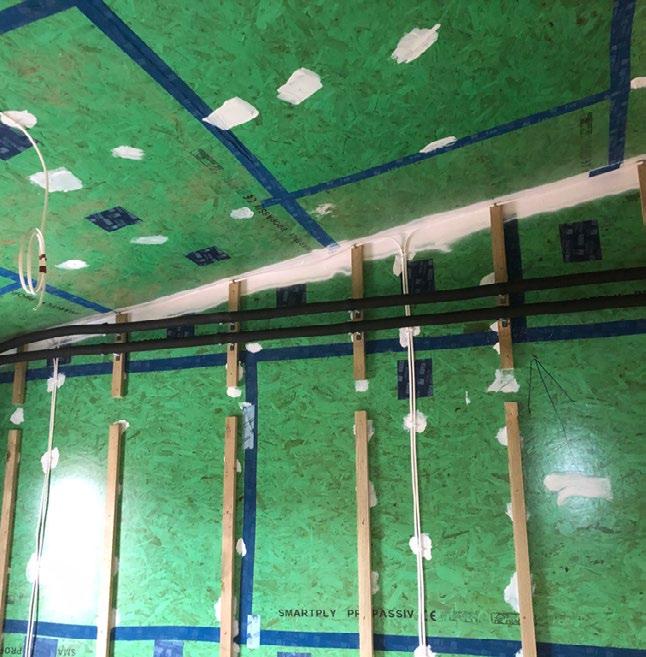
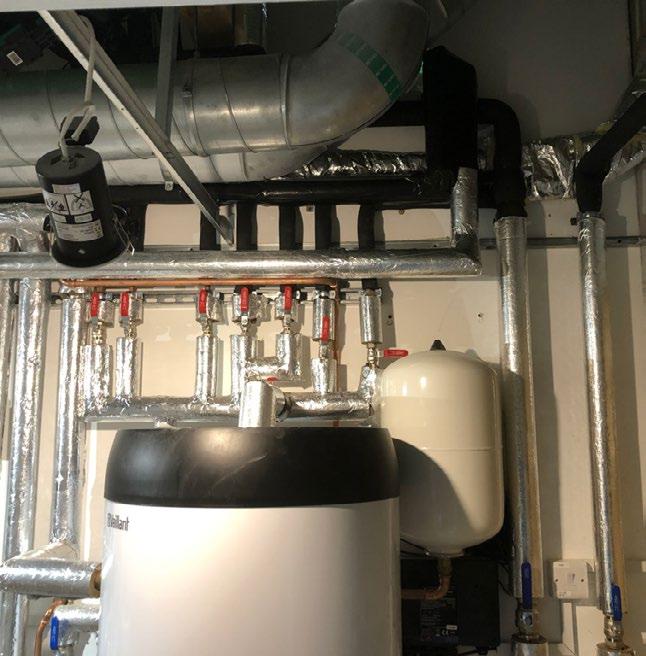

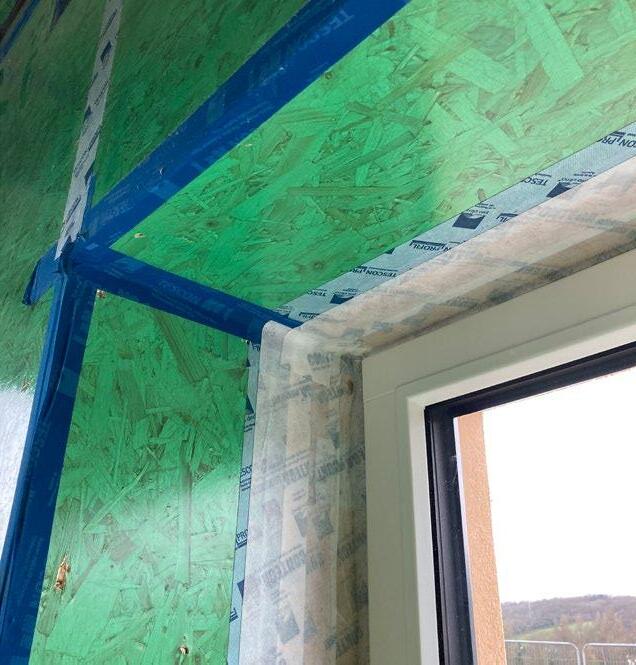
58 | passivehouseplus.ie | issue 44 SHU ARCHITECTS CASE STUDY 7 8 9 10 11 12 1 3 2 4 5 6
1 The original barn exterior; 2 and the original interior; 3 east elevation upstand; 4 west elevation; 5 south elevation; 6 triple glazed sliding door from Green Building Store; 7 wall battens and Pavatherm insulation; 8 Medite Propassiv OSB panels and taped interior; 9 liquid membrane was used for creating airtightness seals; 10 pipe insulation; 11 attenuator for noise reduction through the ductwork; 12 airtightness taping at window.
her office for a fashion business. The couple also wanted the three family bedrooms (there are five bedrooms in total) to have en suite bathrooms and there was to be a large open-plan living space. Meanwhile, a snug was designed for the girls as part of an “inflation plan” as they got older and more independent.
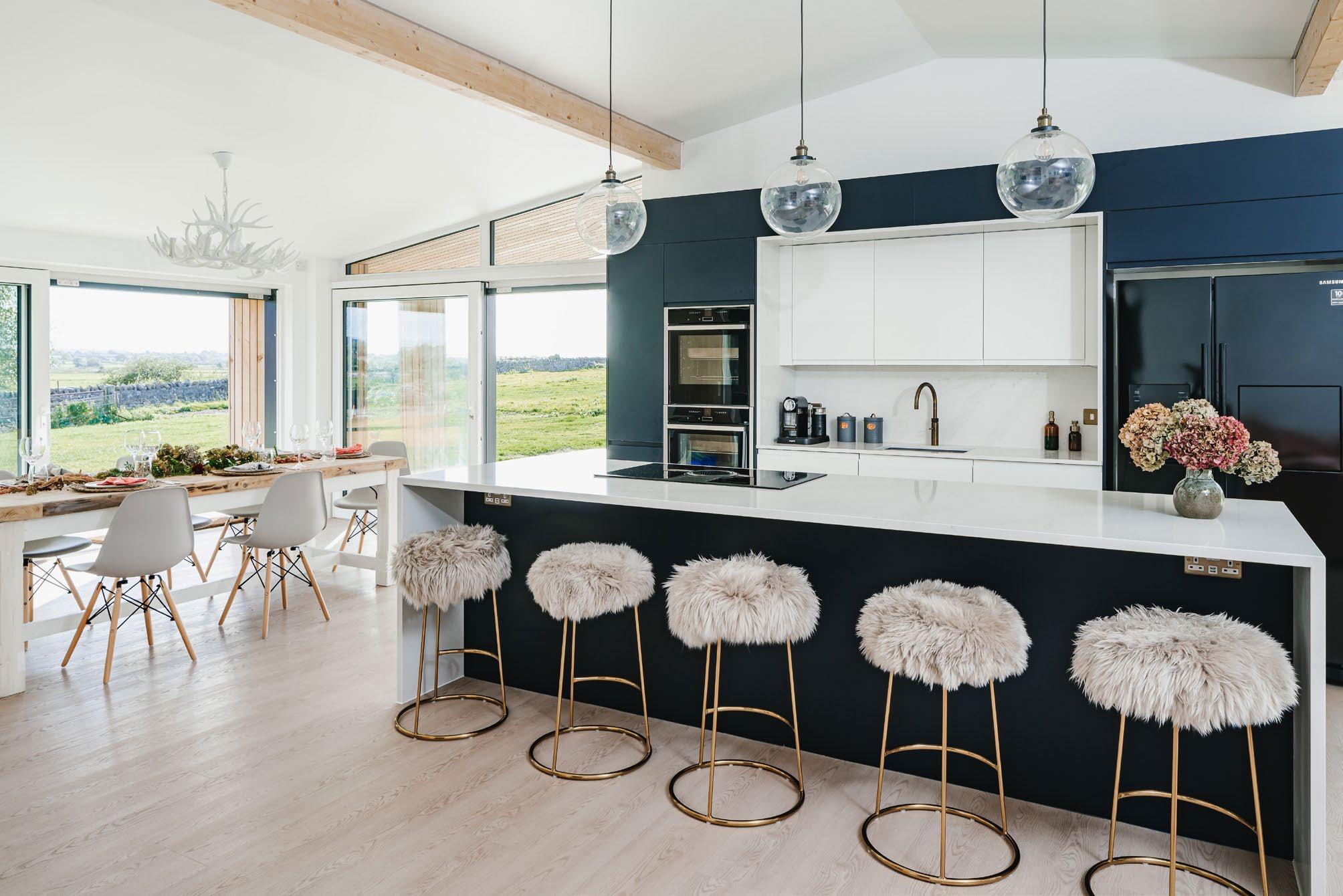

The sheer length of the 27.7 m long building made it hard to get enough light into the corridor. But Geoff “borrowed” some light by placing glazed panels above the doors of Mike’s study and the snug. The living spaces were all open to the ceilings and there were windows providing views to the west for the living spaces and to the north for the principal bedrooms. The length of the building also necessitated installing two water cylinders to avoid waiting times for a hot shower. Greengauge used the AECB’s Water Standard to calculate the hot water lag times for all the pipework.
The trickiest challenge was building a roof inside an existing building, although it turned out to be more straightforward than Geoff initially feared. “It was pretty funny as we modified the designs to allow the builders to access the rafters more easily. We were worried about having enough space for the drills, and so on. But the guys who were building it ended up saying ‘that’s fine. We can crawl into the gaps’. So, that was the difference between an architect’s perspective and a contractor’s!”
There were a few jitters at the outset after the first Covid-19 pan-
ph+ | shu architects case study | 59 CASE STUDY SHU ARCHITECTS
Section view showing the box within a box approach used to create a thermal envelope
Mechanical Ventilation with Heat Recovery Systems
SAP Appendix Q listed, PHI certified & available in a range of capacities from 75-600m3/h
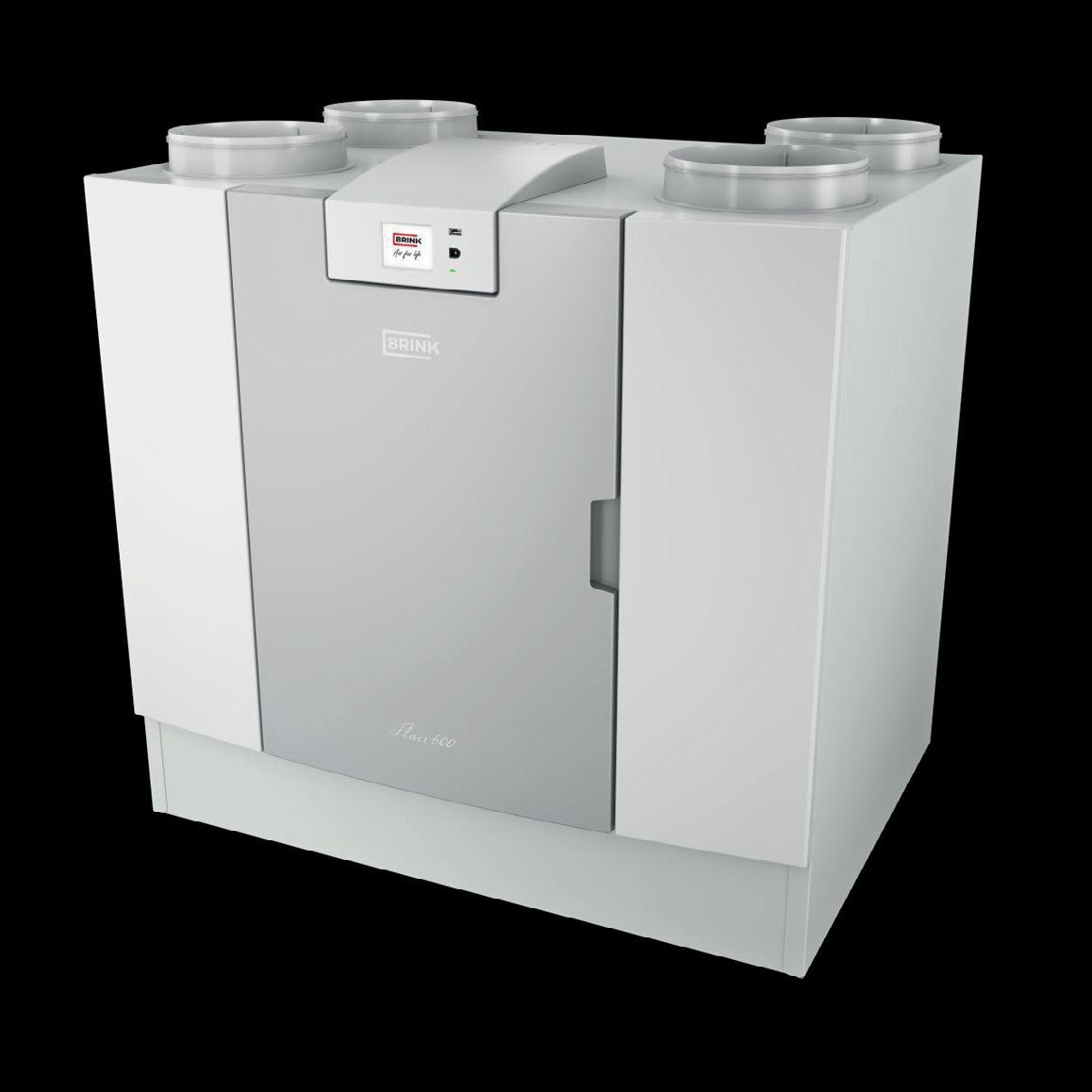
Introducing the FLAIR 600
•Passive House certi ed component
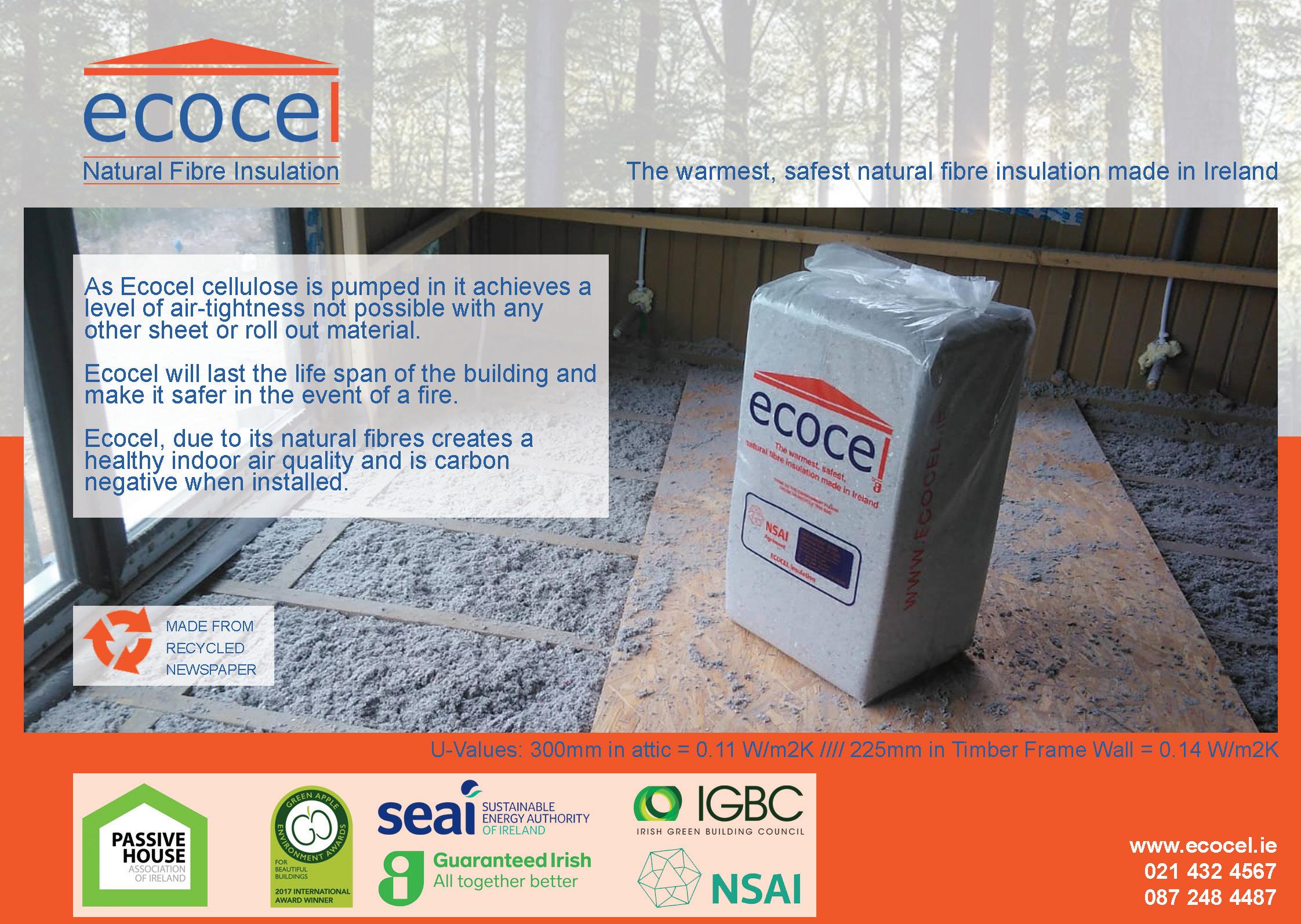
•Highest energy e cency in size class 90%* / 600m3/h
•Suitable for homes up to 360m2
•Bene t from in-built sound dampeners
•Wide range of lter choices
Brink systems are also fully compatible with Ubbink’s Air Excellent air distribution systems. Air Excellent’s clever, push-together connection system combines unsurpassed ease of installation, with incredible levels of airtightness.
*Certified Passive House Components Certificate as of 01/02/2023
Learn more at www.BrinkHRV.com
Brink and Ubbink are distributed throughout Ireland by Kernohan Distribution:
Fir Trees, Greenway Industrial Estate, Conlig, Co. Down, Northern Ireland, BT23 7SU Crank House, Banagher, Co. Offaly, Ireland, R42 DE61 E: info@iakonline.com | W: www.iakonline.com or www.brinkhrv.com
SHU ARCHITECTS CASE STUDY
C M Y CM MY CY CMY K BrinkAdvertPassiveMagFeb23.pdf 1 31/01/2023 12:31 WS23_17-WS-Heat-Pump-135x93mm-Passive-House-070223.indd 1 07/02/2023 5:53 p.m.
demic lockdown was announced in March 2020, just a couple of weeks after Geoff was introduced to the couple. But the build went ahead with pre-design meetings reverting to Zoom. The contractor, MAKE, started work on the house in November 2020 and completed the build on 5 September, 2021, the precise day they had predicted. “It was in my diary and I told friends I couldn’t do anything that weekend. They laughed and said ‘these things always run over. You’ll never be moving in on that day’. But they did it!” said Amelia.
Geoff says the contractors were meticulous in everything they did. “The pressure is always on them to achieve airtightness and they absolutely did the best they could. They ended up buying pots of Passive Purple and, when they weren’t busy with other things, applied a liquid membrane to every nail hole on the boards going into I-Joists, in addition to all the taping done on the board. “They also painted the junction where the board comes down onto the slab, and they put a flexible silicone sealant underneath the battens when they pushed them on, and they also painted them,” he said.
The careful workmanship brought the desired outcomes. A first airtightness test produced a reading of 0.2. A second one came out with 0.3, but only because a sliding door broke just minutes before the test and had to be taped up. Finally, the third test was 0.135. “Once you’ve done the training and worked on a passive house design, and you go back and look at building regulations, you wonder how you ever worked differently before,” said Geoff.
SELECTED PROJECT DETAILS
Architect/passive house design: Shu Architects
M&E engineer/energy consultant/ building physics support: Greengauge
Civil/structural engineer: Build Collective
Project management/quantity
surveyor: Ross Management Services
Main contractor: MAKE
Cellulose insulation: PYC
Wood fibre insulation: Soprema
Airtightness products: Ecological Building Systems
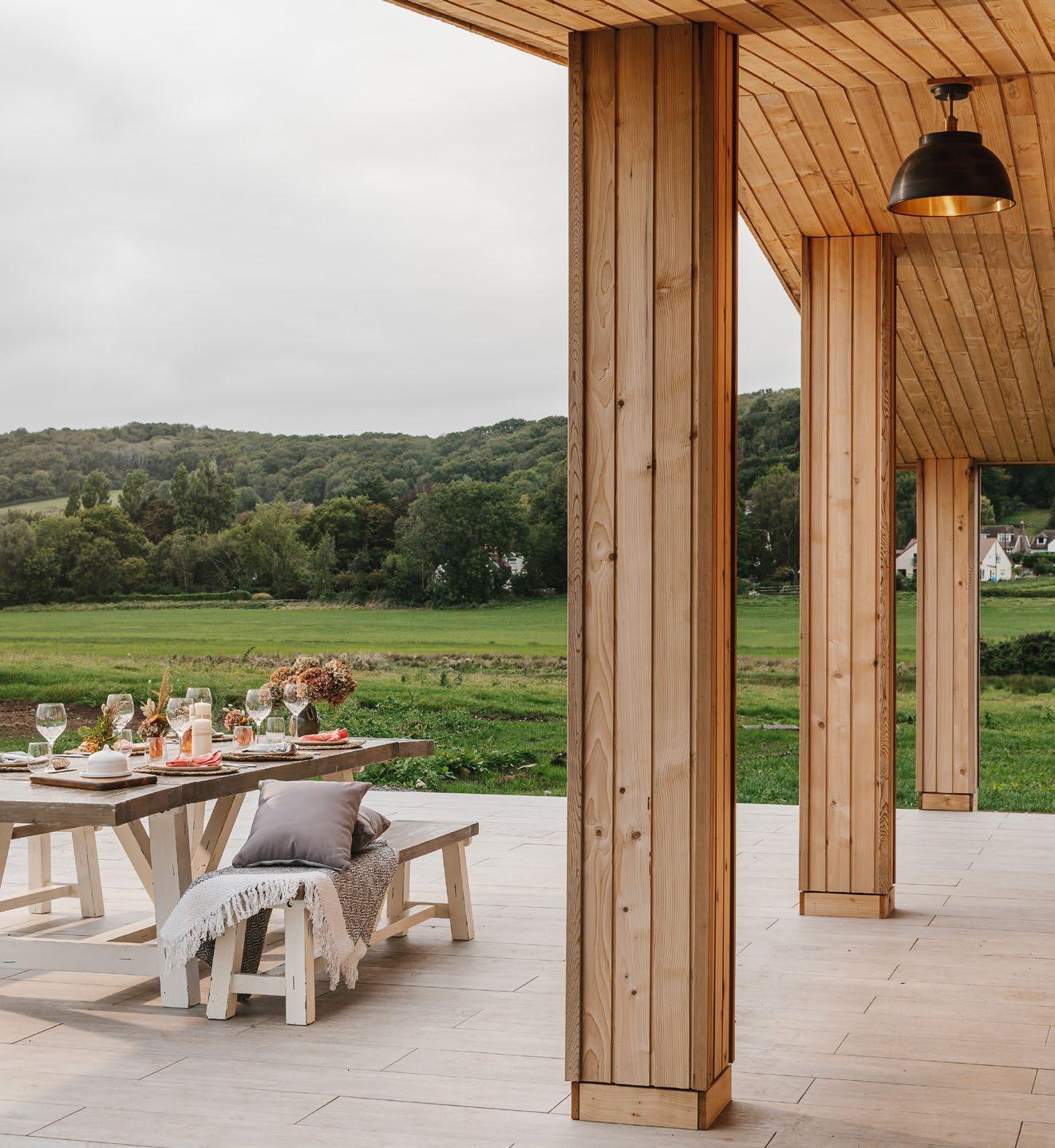
Airtight OSB: Medite Smartply
Windows and doors: Green Building Store
Heat pump: Vaillant
Radiators: Henrad
Mechanical ventilation supplier: Zehnder
Mortgage: Ecology Building Society
ph+ | shu architects case study | 61 CASE STUDY SHU ARCHITECTS
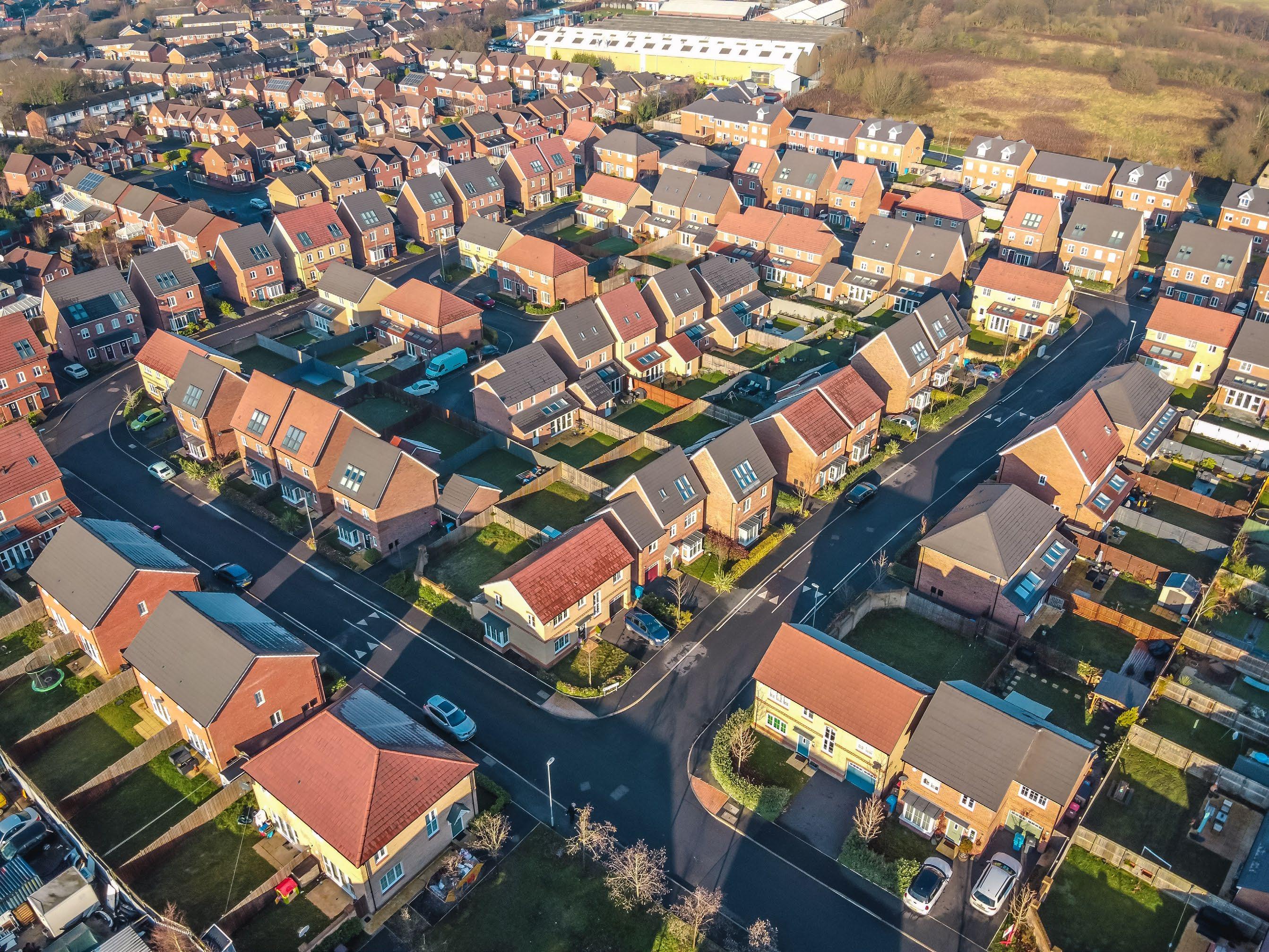



62 | passivehouseplus.ie | issue 44 www.igbc.ie Follow us: Already an IGBC member? You can now opt in to become a member of Construct Innovate for FREE. Join IGBC now to access complimentary membership of the new National Research Centre for Construction Technology and Innovation, Construct Innovate. IGBC is the industry partner in the Construct Innovate Technology Centre BECOME A MEMBER TODAY www.igbc.ie/membership Do something constructive… Join the Irish Green Building Council and accelerate your journey towards a sustainable built environment. Learn Discover our wide-range of online CPDs, Webinars and inhouse training. Lead Contribute to the development of new tools, processes and policy. Innovate Drive, develop and deploy innovation in construction.
IN DETAIL
Building type: 262 m2 (TFA) detached timber frame passive house within an existing steel framed agricultural barn.
Location: Tickenham, North Somerset
Budget: Confidential
Completion date: September 2021
Space heating demand (PHPP): 13 kWh/m2/yr
Heat load (PHPP): 7 W/m2
Heat loss form factor (PHPP): 3.44
Overheating (PHPP): 1 per cent of year above 25 C
Number of occupants: 4
Primary energy demand (PHPP): 29 kWh/m2/yr
Energy standard: Certified passive house classic
Energy performance certificate (EPC): B 88
Measured energy consumption: Unavailable
Heating costs: Calculated space heating cost of £27.97/month. This is based on the building’s calculated space heating demand of 13 kWh/ m2/yr, 262 m2 treated floor area, and the UK
average electricity price based on the Energy Price Guarantee from 1 October 2022 of 34p per kWh, with an assumed Seasonal Coefficient of Performance (SCOP) of 3.45 –the worst available result at the time of writing for this model of heat pump – taken from heatpumpmonitor.org.
Airtightness (at 50 Pascals): 0.1 air changes per hour
Ground floor: 200 mm reinforced concrete slab on 250 mm Kingspan GG300 XPS insulation.
U-value: 0.139 W/m2K
Walls: British Cedar cladding, counter battens and battens, 60 mm Pavatherm insulation, 360 mm timber I-joists with blown Warmcel insulation between, 12 mm Medite Propassiv OSB, 25 mm battened service void and 12.5 mm skimmed plasterboard. U-value: 0.091 W/m2K

Roof: Existing 100 mm insulated steel roof, ventilated void, breather membrane, 12 mm Panelvent racking board, 400 mm I-joists with blown Warmcel insulation between 12 mm
Medite Propassiv OSB, 25 mm battened service void and 12.5 mm skimmed plasterboard.
U-value: 0.092 W/m2K
Windows & doors: New triple glazed windows, entrance door and sliding doors. Green Building Store Ultra GBS98 timber inward opening windows, Argon-filled. Overall U-value of 0.71 W/m2K
Heating system: Vaillant AroTherm 12 kW split air source heat pump – with low global warming potential (GWP) R290 refrigerant – with Henrad low temperature radiators throughout.
Ventilation: Zehnder ComfoAir Q600 heat recovery ventilation system — Passive House Institute certified to have a heat recovery rate of 87 per cent.
Water: We assessed the dead leg volumes and times against the AECB Water Standard. This was reflected in the decision to use two HW cylinders (in the plant room and adjacent to the guest bedrooms), as the house is single-storey, and it is very long in plan.
ph+ | shu architects case study | 63 CASE STUDY SHU ARCHITECTS
IN BRIEF
House type: Deep retrofit to 211 m2 1960s detached house

Method: External insulation, air source heat pump, PV array
Location: London
Standard: Enerphit certified
Heating cost: £43 / month*
* Estimated space heating cost – ignoring contribution from PV array – based on Ofgem’s energy price guarantee for October 2022. See In detail panel for more information.
£43 per month
MODERN LOVE
1960S MODERNIST GEM GETS ENERPHIT TREATMENT
Where does the balance lie between conservation of buildings, energy and nature? One deep retrofit to a London modernist house may point the way ahead, bringing light, form and avant garde energy performance to old ideas about contemporary living.

 By Jason Walsh
By Jason Walsh
ph+ | RDA enerfit case study | 65 CASE STUDY RDA ENERFIT Section A-A 1. Living room 2. Ensuite 3. Stairs 4. Bed 3 5. Bed 1 6. Storage 7. Utility
No-one could ever accuse modernist architects of lacking vision. Indeed, from Le Corbusier to Oscar Niemeyer, to Erno Goldfinger, the more typical complaint is of a surplus of vision. Nevertheless, despite modernism’s controversial place in the history of our built heritage due to mass housing schemes loved and loathed in equal measure, there is a certain something about one-off modernist houses. While we may not really want to live in a machine, the form-follows-function idea (or pretence of it, at any rate) left us with houses that are not only striking but made interesting use of light and space.
What the architects of the post-war reconstruction did lack, however, was an understanding of how energy use would become paramount in housing design.
One recent refurbishment project in southwest London, however, has seized the opportunity to marry the modern with the contemporary, creating a certified Enerphit home fit for how we live today.

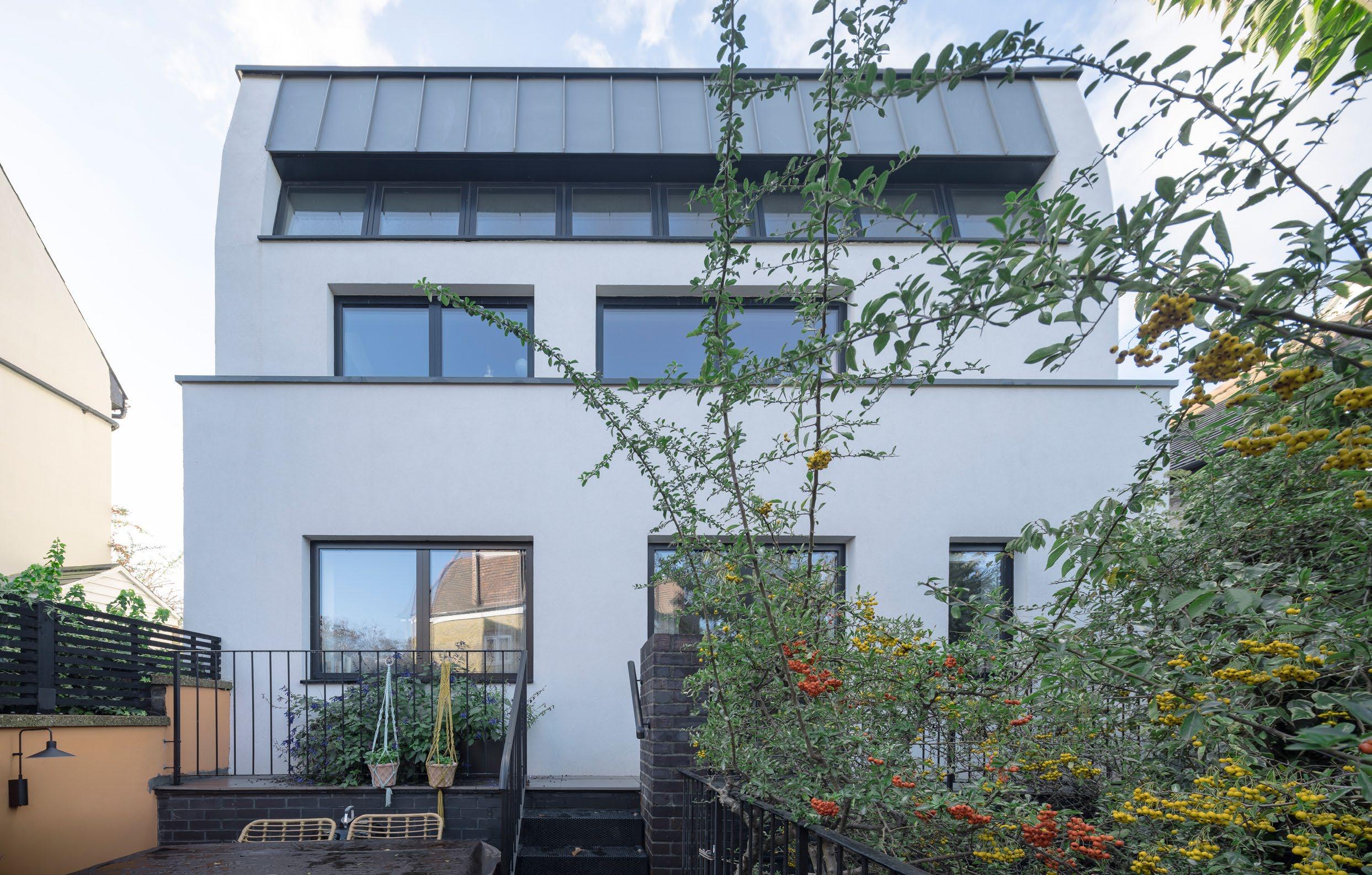
Designed by Michael Blackstock in the 1960s and left untouched for at least 40 years, the three-storey, three-bedroom house was not unknown, having received notices in the press when it was last on the market in 2015. What it also was not, however, was a good performer in terms of energy.
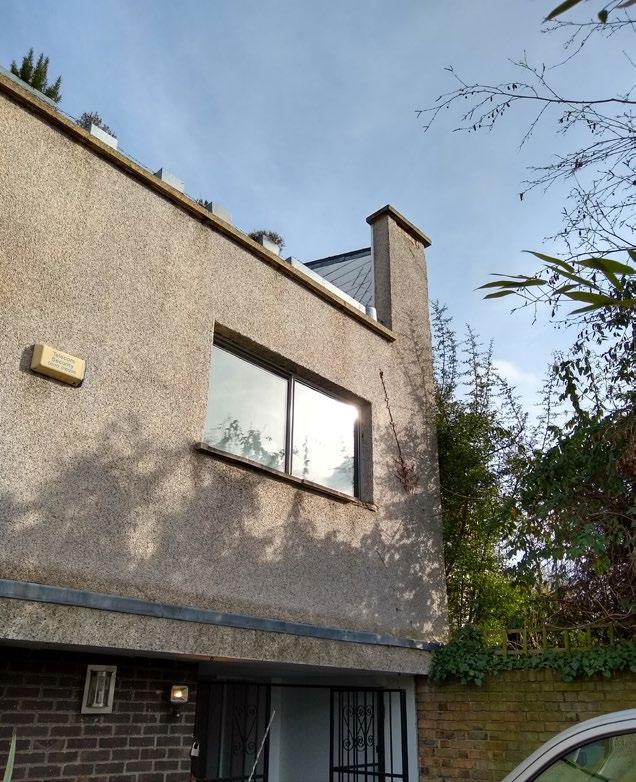
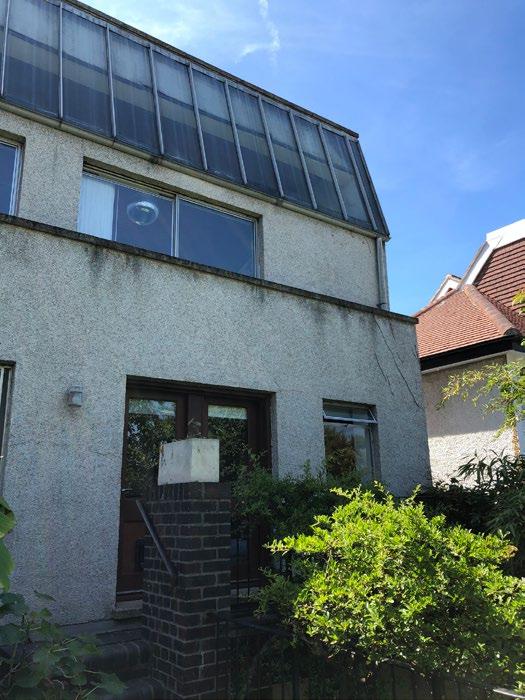
Owner Aline Knowles, herself an architect by training, approached Richard Dudzicki, founder of RDA architecture, to transform the house from a damp, leaky and dated
time capsule into the light-filled, calm retreat it had always promised to be. Central to the plan was bringing it up to passive house standard.
Crucially, exterior insulation was fitted, glazing replaced, and an integrated solar roof added. In addition, rainwater harvesting was added and the interior was completely refurbished, not only to improve the aesthetics but also to allow for the installation of mechanical heat recovery ventilation.
It soon transpired that the house was in need of extensive repair, including to the building fabric, which suffered from air leakage and dampness. Dudzicki said that one difficulty on starting the work was the fact it is a reinforced concrete building, so until the build work was underway it was not possible to know where the pre-stressed areas would be and where to create or leave existing openings. There would be other surprises, though.
“We soon discovered it was a mixture of block and beam, reinforced concrete, and all sorts. It was almost as if they started as one thing and then ran out of money and had to finish it a different way,” he said.
Phenolic insulation was used externally and lime render was used to ensure the walls were breathable, but one party wall was fitted with a different insulation panel due to a lack of space.
“There is a lot of thermal mass in that building, lots of concrete, so it lent itself to external insulation,” he said.
66 | passivehouseplus.ie | issue 44
Before Before After
An existing drive-through garage was added to the building envelope and repurposed into an art studio and main entrance lobby, making the house more usable without interfering with its 1960s aesthetic. That same 1960s aesthetic, however, provided plenty of other challenges.
“We gutted the entire inside. It was an upside-down living house, and all the bedrooms had these strange cubby holes and cupboards. It didn’t fit how the client

wanted to live and work in the house,” Dudzicki said. A treacherous spiral staircase was also replaced.
In-situ underfloor heating was kept, but the heating system was changed to an air source heat pump – Dudzicki specified a Mitsubishi Ecodan Ultraquiet to reduce noise – and the new building services required significant work.
“We installed an air source heat pump and mechanical heat recovery ventilation, which was quite hard. We really had to work out the route early on with the structure engineers but, in the end, we found areas where we could drop the ceiling without affecting the room and that gave us the space to get the ducting in,” he said. But a couple of aspects of the original house design lent themselves to retrofit: the original house featured air-based heating and existing copper underfloor heating pipes. Existing voids designed for the air heating were used to run ductwork, and the copper underfloor heating pipes were chemically cleaned by a professional and reused.
Photovoltaic panels were added, alongside high-performance Tesla batteries for storage. Dudzicki said the batteries are much hyped, and they do work, but are not really the miracle some reports suggest: “Would I put one in [my own home]? Maybe. They’re OK. They integrate really well with Tesla cars, I’m sure,” he said.
The PV panels were another story altogether, and Dudzicki is very happy with them. Rather than being attached to the roof, the panels actually form the roof itself.
“The solar panels are the roof, there are no tiles underneath it. That was quite novel. The hidden gutter around the side is where the water runs off,” he said. This water is then harvested and used to fill a pond and water the garden.
Passive solar issues were also considered, with solar shading added to windows as well as room for blinds: “We also used planting on the balcony as a solar screen,” he said.

Roof lights on the top floor ceiling, one of the building’s most striking original features, also posed a challenge, as well as demon-
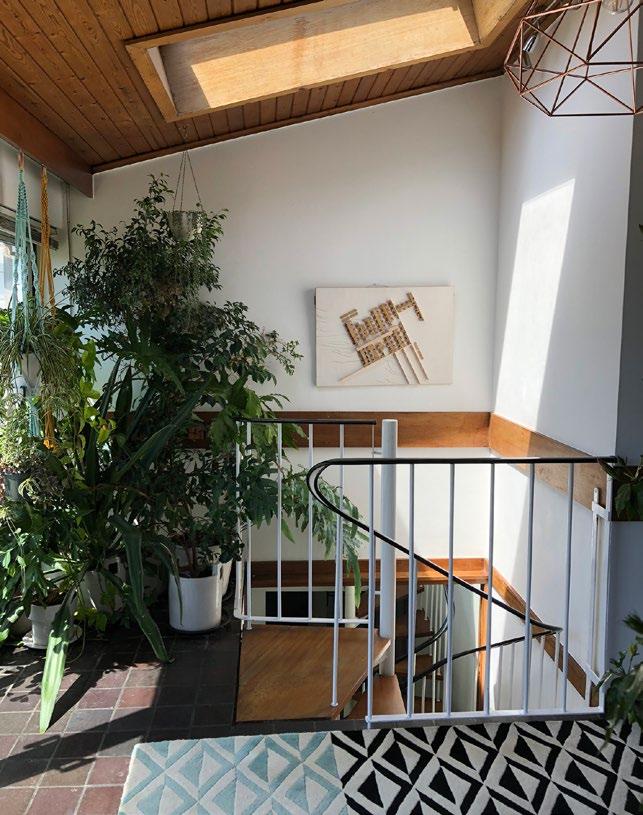
ph+ | RDA enerfit case study | 67 CASE STUDY RDA ENERFIT
Photos: Timothy Soar
If the architect in 1966 had understood energy the way we do today I am sure he’d have done very similar things.
Before After
external insulation.
strating the limits of the modernist imagination in the 1960s.
“The roof is mono-pitched with southerly, south easterly sky lights and they were single glazed, which gave a real issue with heat loss. It was freezing,” he said.
Removing them would have taken away a crucial aspect of the building, however, so Dudzicki’s answer was to make them slightly smaller and triple glaze them. Similarly, the wood ceiling was replaced with one that matches the original vision for the house, as were the architraves, doors and kitchen, all faithful to the original design.
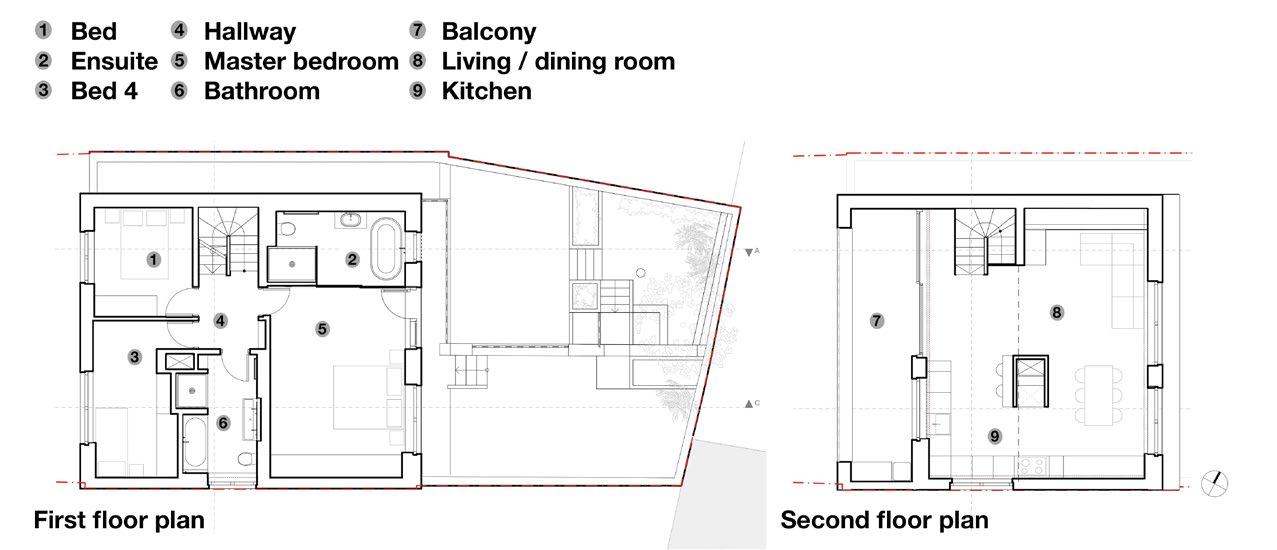
For Dudzicki, the house is a kind of vindication: it proved that modern houses, through extensive retrofitting, can be made to meet the needs of twenty-first century living.
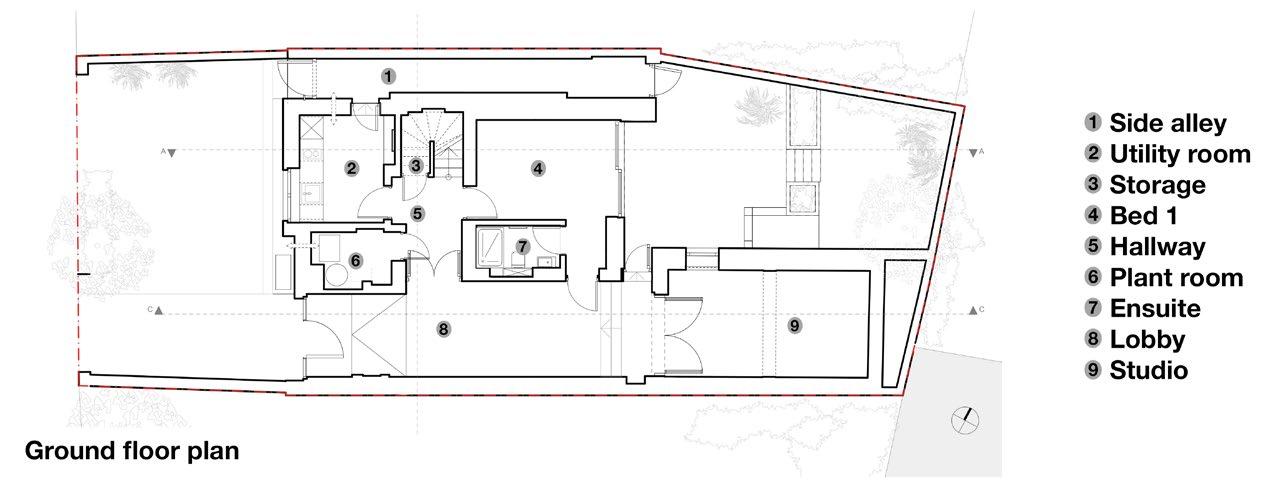
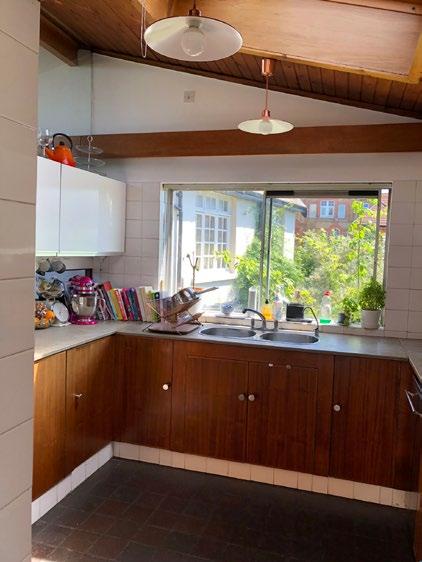

“We tried to keep the modern feel. If the architect in 1966 had understood energy the way we do today I am sure he’d have done very similar things,” he said. Indeed, Dudzicki comes from a family of architects, with his father working on similar housing after the Second World War.
“What we tried to do was really look at the design and try to make it function from a contemporary point of view. What I wanted to do was not have a hippy-trippy thing. Sustainability had always been seen a bit like that, so I wanted to prove that it could be done differently,” he said.
With climate now firmly on the political agenda, not to mention a housing shortage, Dudzicki, who himself lives in an Enerphit house, says that, given the right care and attention, projects like the Blackstock house could be scaled up to confront these two issues.
“You do need a good six month period at the start with a retrofit and that’s very difficult in the current market, and with the housing stock in London there are so many conservation areas [but] most of the brutalist, modernist buildings which people don’t want to conserve could be retrofitted. The fact is, they tend to lend themselves to things like external insulation,” he said.
68 | passivehouseplus.ie | issue 44 RDA ENERFIT CASE STUDY
Before
Most of the brutalist, modernist buildings which people don’t want to conserve could be retrofitted. They lend themselves to
Ground Floor Plan
1. Side alley
2. Utility room
3. Storage
4. Bed 1
5. Hallway 6. Plant room
7. Ensuite 8. Lobby 9. Studio
First Floor Plan
Second Floor Plan
1. Bed
2. Ensuite
3. Bed 4
4. Hallway
5. Master bedroom 6. Bathroom
7. Balcony 8. Living / dining room 9. Kitchen
SELECTED PROJECT DETAILS
Client: Aline Knowles
Architect, project management, landscape design: RDA Architects

Civil / structural engineer: Michael Baigent Orla Kelly Ltd
Energy consultant: Ecospheric
Main contractor: PJS Building & Maintenance Ltd
Quantity surveyors: Saville Brown
Airtightness tester/consultant: Air Testing Ltd
Lime render and cladding: Mike Wye & Associates Ltd
Thermal breaks: Farrat
Airtightness products: Siga
Windows, doors and rooflights: SNT
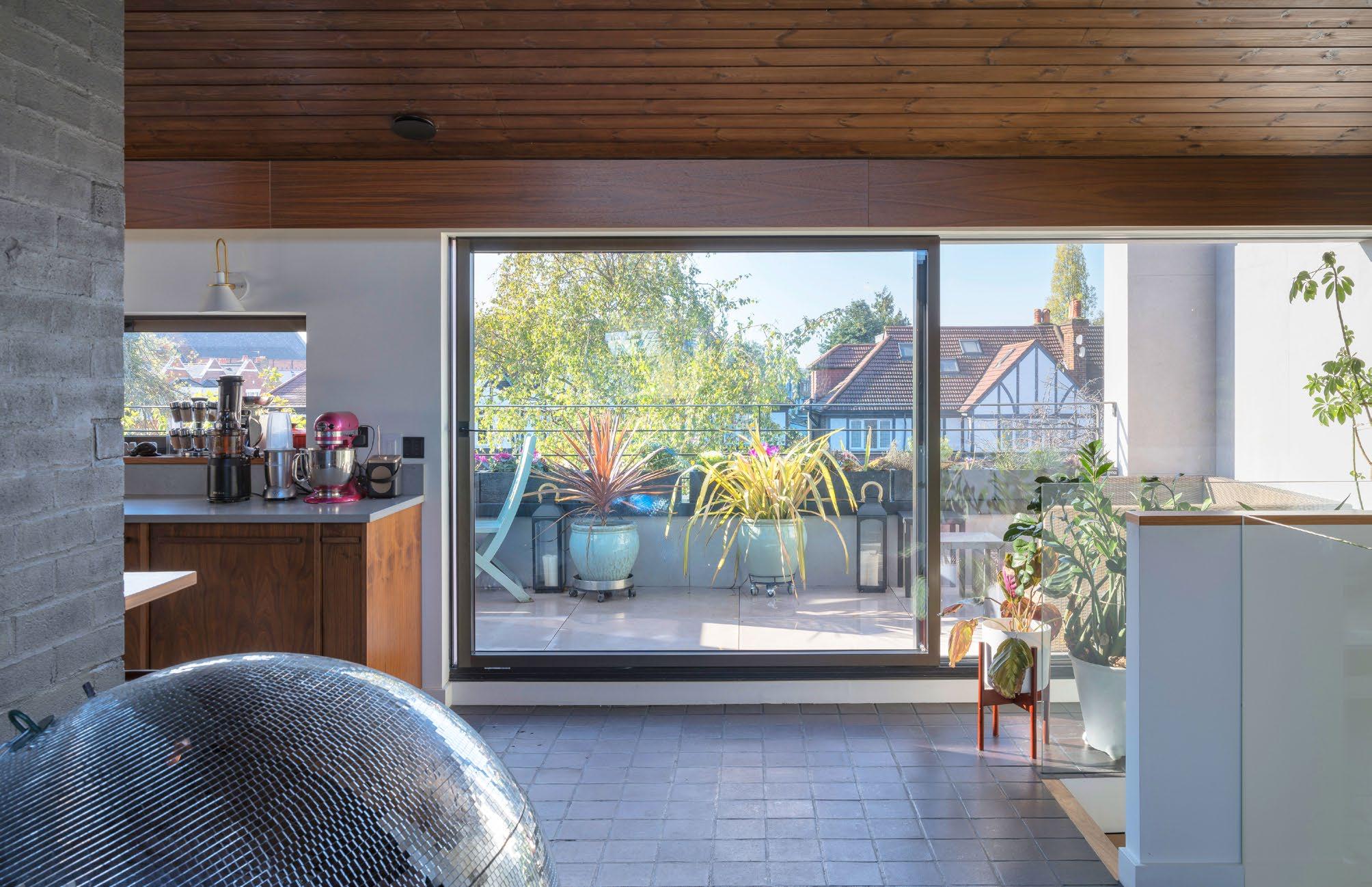
Screeds: Ecomerchant
Fit out and furniture:
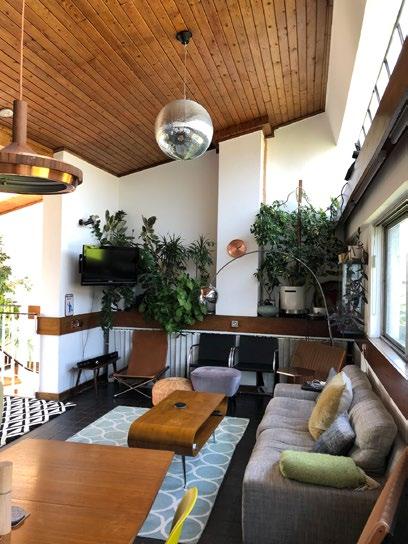
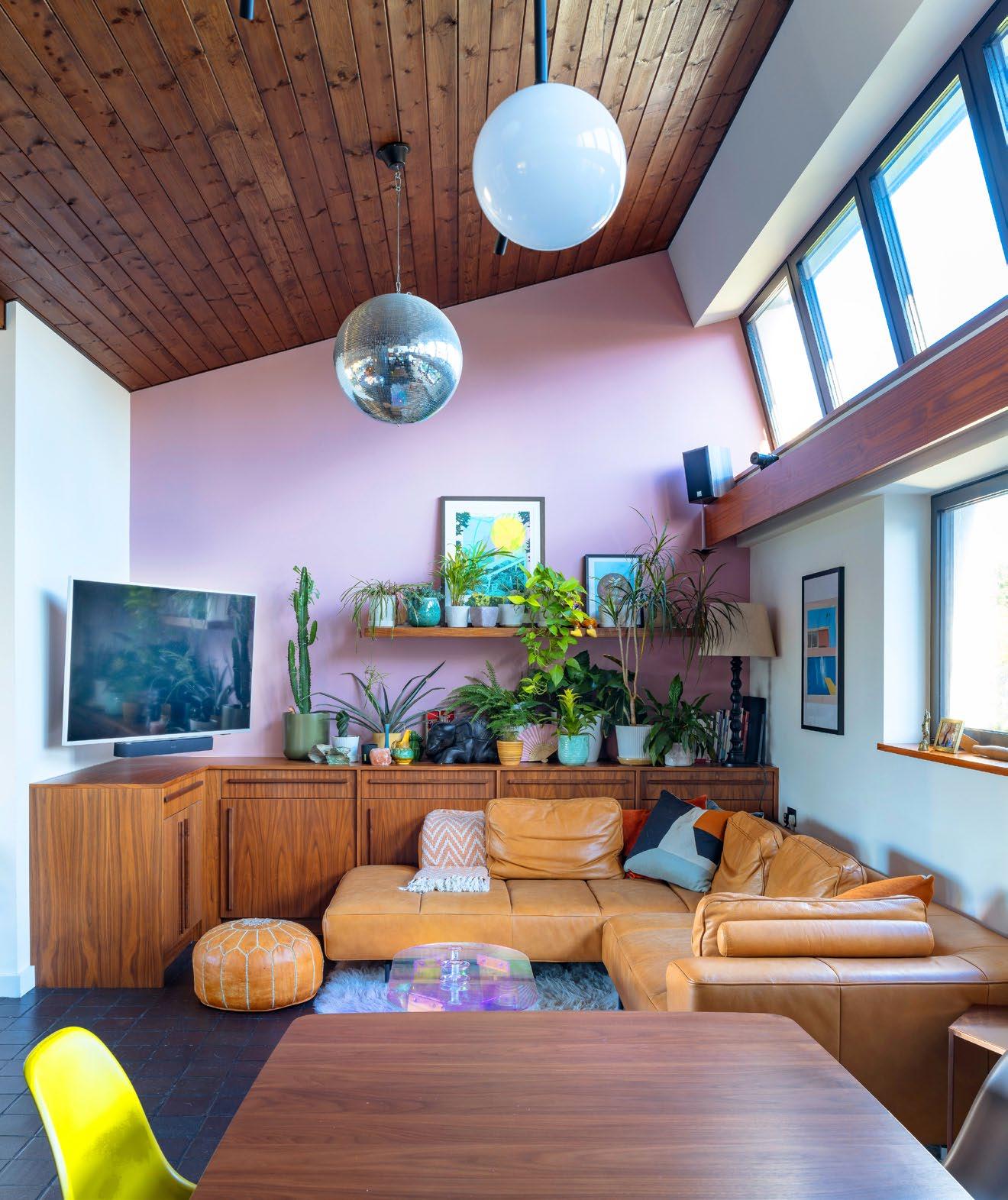
Scandinavian Trade Ltd
Flooring: Senso
Rainwater harvesting/drainage/paving: Rain Water Harvesting Ltd
Insurance: Self Build Zone
Heat pump: Mitsubishi
Hot water tank: Mixergy
Mechanical ventilation: Zehnder
Photovoltaic roof: GB Solar
Lighting: MSLD Lighting Design
Lighting controls: Corston
Water conserving fittings: Crosswater
Sanitaryware: Kaldewei
ph+ | RDA enerfit case study | 69 CASE STUDY RDA ENERFIT
Before Before
Architect’s statement
Our client Aline (an architect by training but now a DJ) wanted this 1960s modernist house designed by Michael Blackstock to be restored, combining the original design aesthetic with a contemporary approach. The three-storey property was designed in the ‘upside-down’ style common in the 1960s, with an open plan living space and terrace sitting above cramped bedrooms and bathrooms on the first floor, and a ground floor parking and utility area.
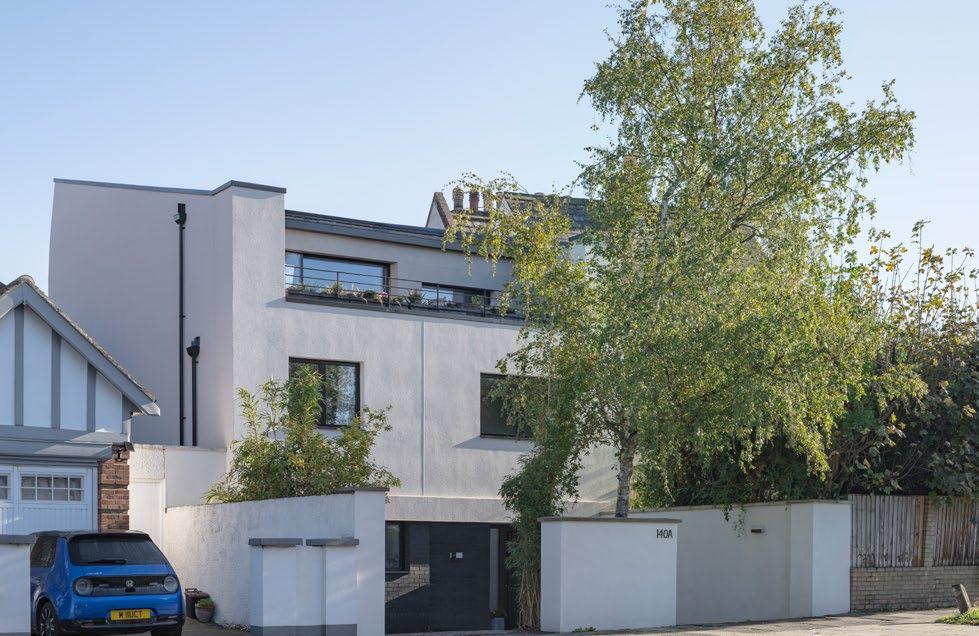
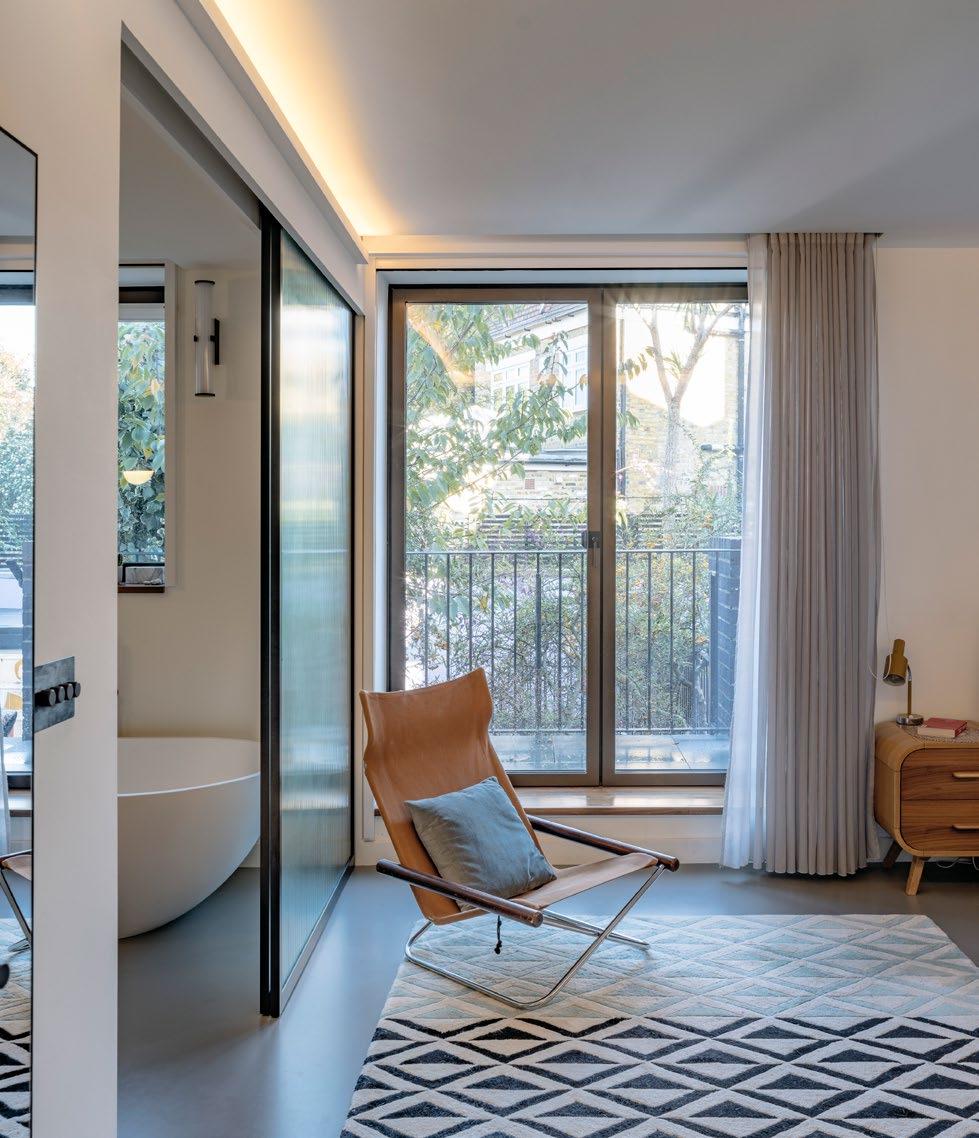
This is not a straightforward house or design. The house was in need of extensive repair works (including building fabric itself, addressing air leakages and dampness), Instead of demolishing a historic award-winning project, we breathed new life into the building using modern technology to extend its lifespan by another 100 years.
The layout was addressed to take into consideration a more modern way of living, simplifying the live-work aesthetic that was


needed. RDA focused on improving the circulation by separating private and public spaces, and connecting these spaces with the garden. Attention was given to recreating bespoke fittings to mimic the pre-existing wooden joinery.
The passive house standard requires highly efficient insulation, and new windows and doors have also been fitted to improve airtightness, reducing heat loss, providing a high level of comfort throughout the house. This is a pioneering retrofit approach, while aligning with the RIBA 2030 Climate challenge, being a precedence to bringing the housing sector towards zero carbon emissions by 2050.
This project with its Enerphit value, corresponds to UN Sustainable development goals number 7 (Affordable and Clean energy),11 (Sustainable Cities and Communities) and 13 (Climate Action). Within this framework, it is an encouraging example
WANT TO KNOW MORE?
The digital version of this magazine includes access to exclusive galleries of architectural drawings.
The digital magazine is available to subscribers on passivehouseplus.ie & passivehouseplus.co.uk
to its neighbourhood and within the larger context of the UK, for more sustainable and energy efficient buildings. In addition, it is almost like a living lab as it is being monitored constantly to be adjusted to the best performance it can achieve. Similarly, the data gathered during its monitoring process, can actually provide insight for the broader design community, excelling the design decisions towards more sustainable features.
This house consumes 88 per cent less energy than an average UK home. The total PV panel system size is 7.8 kW, corresponding to 77 per cent of all the energy needed.
According to British Gas data, while the average energy bill of a typical UK house costs £2,500, the energy bill for this house is expected to be as low as £177 annually thanks to its design.
This house provides a very important example of implementing successful energy management.
70 | passivehouseplus.ie | issue 44 RDA ENERFIT CASE STUDY
IN DETAIL
Building type: Deep retrofit and renovation to 211 m2 modernist house designed by Michael Blackstock in 1960
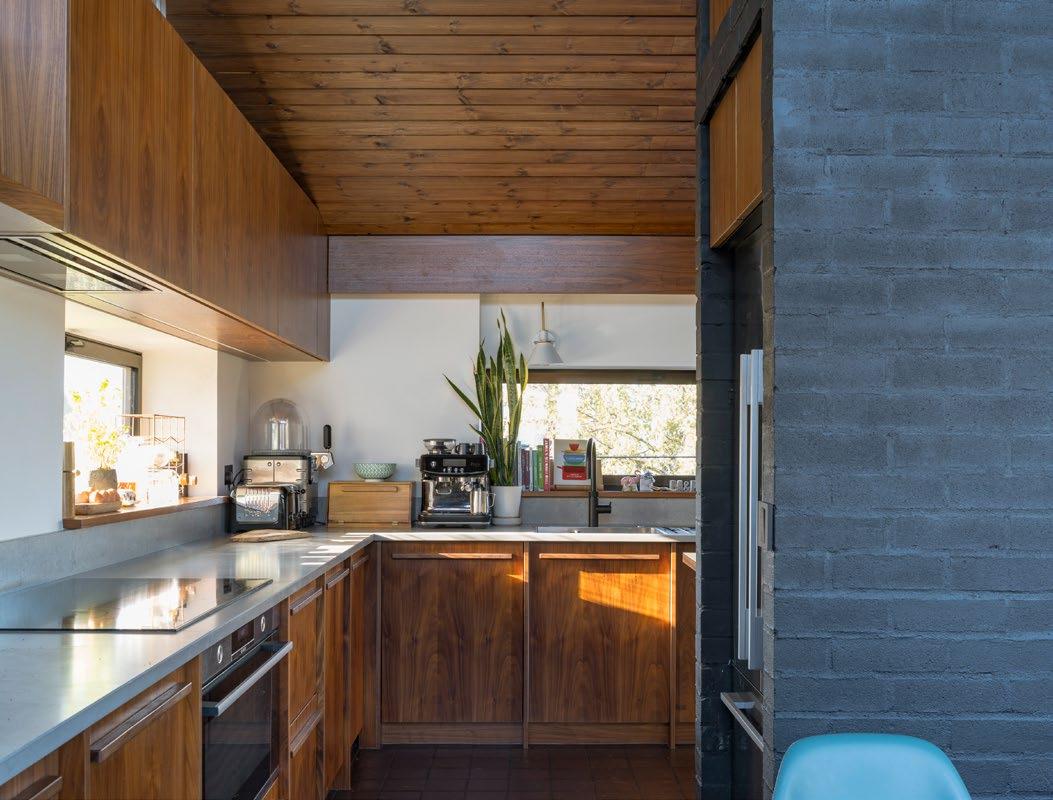
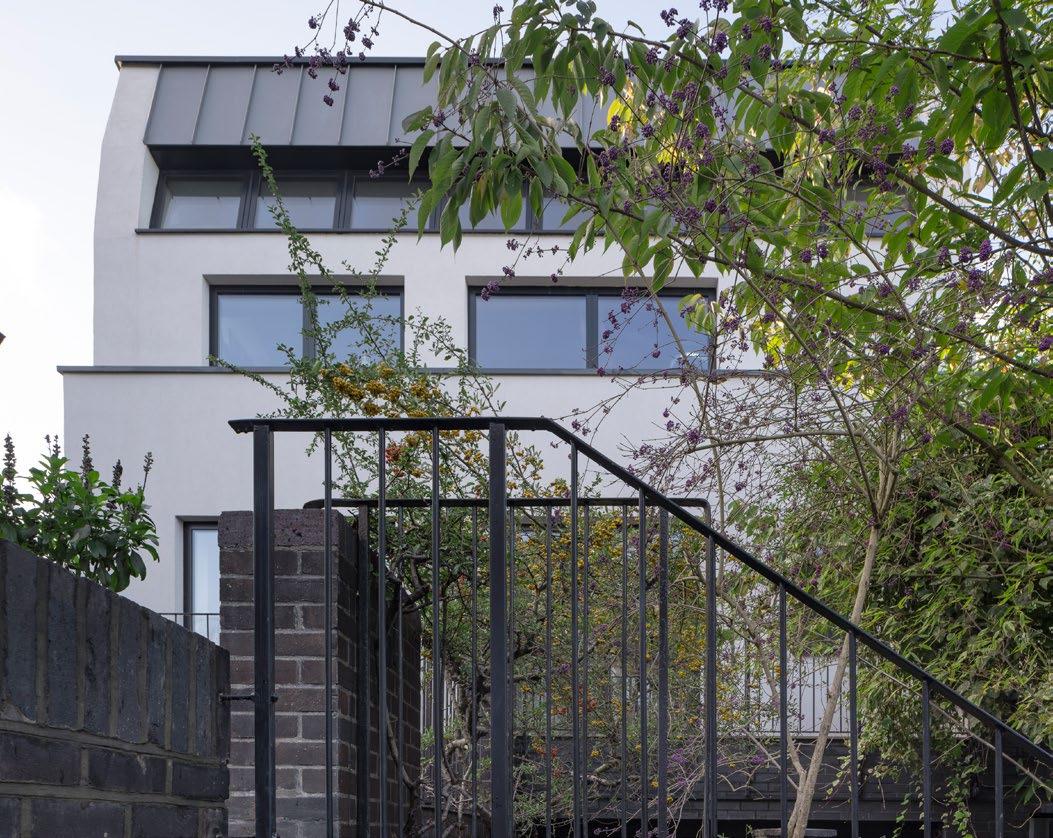
Site type & location: Urban site, New Park Rd, Lambeth, London
Budget: £498,000 complete construction cost, including contractor overheads and profits and any contractor-team design fees, excluding VAT, site purchase and design team fees.
Completion date: May 2022
Passive house certification: Enerphit Plus certification
Space heating demand (PHPP)
Before: Approx 168 kWh/m2/yr
After: 26 kWh/m2/yr
Heat load (PHPP)
Before: Not available
After: 14 W/m2
Primary energy non-renewable (PHPP)
Before: Not available
After: 120 kWh/m2/yr
Primary energy renewable (PHPP)
Before: Not available
After: 74 kWh/m2/yr
Form factor (PHPP): 3.06
Overheating (PHPP): 6 per cent of year
above 25 C
Number of occupants: Two adults and a dog
Embodied carbon:
Maintained the already existing concrete substructure and superstructure, with natural materials used where possible. The roof was redesigned to have PV solar panels replacing tiles, excess energy generated is stored in a Tesla power wall. Finally, rainwater is collected by the roof and stored in underground tanks for external use.
PHribbon whole life carbon methodology was used. Both upfront carbon RICS modules A1-A3 and RICS whole life carbon modules A1-A5, B1-B5, C1-C4 including sequestration are calculated and visualised in graphics. In order to compare against RIBA 2030 embodied carbon level, the latter is taken into account. Cradle-to-grave assessment boundary is applied. Building life is assumed as 60 years.
Whole building embodied carbon score of 562
KgCO₂eq/m² using PHribbon.
Measured energy consumption
Before: 214 kWh/m2/yr
After: 25 kWh/m2/yr
Energy bills
Before: Not useful to compare, given that pre retrofit energy use was pre energy crisis.
After: Calculated at £43 per month on space heating. This is based on the building’s calculated space heating demand of 26 kWh/m2/yr, 211 m2 treated floor area and the UK average electricity price based on the Energy Price Guarantee from 1 October 2022 of 34p per kWh, and the measured mean seasonal COP result of 3.6 for this model of heat pump taken from Heatpumpmonitor.org
Thermal bridging
Therm calculations for key junctions – including the southeast side wall where thinner external insulation was required due to the proximity of a neighbouring property, meaning a greater thickness of internal insulation was required. Farrat plates used at steel penetrations. Windows and doors bracketed into external insulation layer.
Airtightness
Before: N/A
After: 0.82 air changes per hour (m³/hr m² at 50pa)
Ground floor
Before: Uninsulated concrete floor. U-value: 1.6 W/m²K
After: (top to bottom) Sesno resin, Fermacell board airtight layer, phenolic insulation, rubber crumb mat, DPM, reinforced concrete. U-value: 0.13 W/m²K
Walls
Before: Approx 215 mm double layered brick wall. U-value: 0.7 W/m²K
After: (inside to out) Regency lime plaster airtight layer, eco cork lime plaster, phenolic insulation, brick slips to match existing. U-value: 0.2 W/m²K
First floor Walls
After: (inside to out) Plaster skim, phenolic insulation, lime plaster, double layered brick wall, Thermaline render. U-value: 0.139 W/m²K
Roof
Before: Leaking asphalt roof with 100 mm of Rockwool insulation in between joists.
After: Solar roof acting as rainscreen; phenolic insulation, Siga Majrex membrane; phenolic insulated plasterboard; pine cladding. U-value: 0.088 W/m2K
Windows & doors:
Before: Single glazed, timber windows and doors.
New triple glazed windows: Passive house standard requires highly efficient insulation; new windows and doors have also been fitted to improve airtightness – reducing heat loss, providing a high level of comfort throughout the house. Overall U-value: 0.84 W/m2K
In order to achieve high performance, airtightness sealing and tapes are used across all interior envelope and junctions, and as required by Enerphit principles.
Heating system:
Before: 50-year-old oil boiler & radiators throughout entire building with some underfloor heating that was not working.
After: Mitsubishi Ecodan Ultraquiet air source heat pump
Ventilation:
Before: No ventilation system. Reliant on infiltration, opening of windows for air changes. The living room on the top floor was prone to overheating.
After: A Zehnder MVHR system is used to ensure fresh air quality together with Passive House Institute certified heat recovery efficiency of 88 per cent.
Water: Mixergy water tank technology directly connected to PV system. There is a rainwater harvesting system which collects water from the roof. The water is used for the hot tub and external use.
Electricity: PV Panels of 7.8 kW capacity are used for energy generation, Tesla battery storage is added to system to store the energy, prioritised for domestic hot water heating via immersion and electric car charging, excess electricity exported. Sustainable materials: Pine cladding and plywood from FSC sources, eco cork lime render. Restoration and reuse of old underfloor heating system.
ph+ | RDA enerfit case study | 71 CASE STUDY RDA ENERFIT
COLD COMFORT
ARE IRELAND AND THE UK’S ENERGY RATINGS PREDICATED ON COLD HOMES?
Passive houses aside, attempts at low energy building have a long and inglorious history of using more energy than predicted, with a key reason being “comfort-taking”, where occupants take back the benefit of energy efficiency by cranking up the thermostat. But is it rather that energy ratings are assuming miserly heating use –and temperatures that fail to meet the requirements of a new EN comfort standard?
By Lenny Antonelli & Jeff Colley
The national dwelling energy calculation tools for Ireland and the UK may assess buildings in a way that assumes occupant discomfort, and that creates a ‘performance gap’ between a home’s designed energy performance and its real-world energy use.
The Dwelling Energy Assessment Procedure (DEAP), in Ireland, and the Standard Assessment Procedure (SAP), in the UK, both assume indoor temperatures which appear to be far lower than those recommended in a recent European standard for indoor environmental quality and occupant comfort.
For DEAP, this was pointed out to Passive House Plus by architect John Morehead. Having designed a detached dwelling in the passive house software, PHPP, Morehead then entered the building’s specification into DEAP.
At the suggestion of Passive House Plus, Morehead reduced the specification of all building fabric elements to the backstop levels in Part L of Ireland’s building regulations (also known as the nearly zero energy building, or NZEB, standard). Morehead specified the worst permitted U-values for the walls, roof, floor, windows and doors, as well as the worst allowable values for airtightness and thermal bridging. He also dramatically increased the size of the building’s notional solar PV array, to see if it would still comply with Irish regulations.
Despite the poorer performance of the building fabric, and the oversized PV array, the building still complied with the NZEB standard. Morehead then noticed that two figures in the ‘ht use’ tab of DEAP indicated that outside of heating hours, indoor temperatures would be uncomfortably low.
The mean internal temperature for unheated periods was given as 15.57 C, while the mean internal temperature for the whole heating season was just 16.5 C. DEAP assumes that, during heating hours, living areas (defined as the living room plus any adjacent spaces in open plan dwellings) are heated to 21 C, while bedrooms are heated to 18 C.
However, DEAP heating hours are only assumed to be eight hours per day from 1 October to 31 May. No heating is assumed at other times.
EN 16798 comfort standard
These temperatures fall below the thresholds for indoor environmental quality set in a recent European standard, EN 16798. The standard includes a table with four categories of indoor environmental quality for buildings: high, medium, moderate, and low (see table 1). The appendix to part two of EN 16798 then gives recommended indoor operative temperatures to correspond with these categories (see table 2).
The standard suggests that, even for the worst indoor environmental category for living spaces, bedrooms and kitchens, temperatures should not fall below 17 C. The standard says that this category is only intended for spaces that are “used for a short time of year” or spaces “with very short time of occupancy”.
Category two is suggested as the “normal level used for design and operation” of buildings, and this recommends a minimum indoor winter temperature of 20 C. However, John Morehead’s example shows that it may be possible to design NZEB dwellings that fall well outside this comfort recommendation. It should be noted that EN 16798 is a voluntary standard and is not yet referred to in any official Irish legislation or technical guidance.
SAP assumes low temperatures
SAP, the UK’s dwelling energy assessment software, appears to make similar assumptions as DEAP. Leading consultancy Elmhurst Energy examined the temperature profiles of new dwellings in England for Passive House Plus.
“The result of all of this is after looking through a number of Part L 2013 compliant buildings typically the mean internal temperature across the whole building ranges from around 17-18 C in the winter months to 20-21 C in the summer months,” the com-
pany’s new-build dwellings manager, Jason Hewins, said. This would put these buildings in the bottom two comfort categories, categories three and four, for dwellings.
In Ireland, the theoretical dwelling modelled by John Morehead does not appear to be an exception. Indeed, the DEAP files for example dwellings provided by the Department of Housing to show different ways of complying with Part L typically show mean internal temperatures for unheated periods, and for the whole heating season, (including periods when the heating system is switched off) of 17 or 18 C.
However, these sample dwellings have high ‘living area fractions’ of 25 or 50 per cent, indicating the proportion of the dwelling heated to 21 C during heating hours. Analysis of recently built dwellings in SEAI’s national BER database indicates that the mean living area fraction for detached houses built to the NZEB standard to date is 18.2 per cent, which would reduce the mean internal temperature of these dwellings even further. This indicates that a substantial proportion of newly built dwellings in Ireland may be assumed to be running at mean indoor temperatures that do not, or just barely, meet the lowest categories of indoor temperature recommended by EN 16798 .In response to a question from Passive House Plus about whether EN 16798 might be incorporated into DEAP, the Sustainable Energy Authority of Ireland (SEAI) told Passive House Plus that the EU’s Energy Performance of Buildings Directive is currently being revised, and that this may have an impact on BER calculation methods. “SEAI plans to commence this year a review to consider future changes to the methodologies. This would include consideration for EN 16798 and related calculation standards,” wrote SEAI programme manager Antonella Uras.
Operative vs dry bulb temperatures
SEAI had previously told Passive House Plus that because the EN standard gives “operative temperatures” (i.e., the temperature
72 | passivehouseplus.ie | issue 44 COLD COMFORT INSIGHT
The deep retrofit to College View in Wexford saw substantially higher heat energy use than predicted, likely due to the elderly occupants desire for consistent heat and high comfort levels

experienced by a person in the room) while DEAP uses “dry bulb temperatures (i.e., air temperatures), these figures could not be directly compared. Operative temperatures are a combination of the dry bulb temperature and the radiant temperature.
However, having consulted various experts on the topic, Passive House Plus understands that in well insulated buildings, unless there is a large area of glazing and thus high solar radiation, the difference between the operative and air temperature is very small.
There is concern about the extent to which building assessment tools such as DEAP and SAP may struggle to capture the actual temperatures to which dwellings are heated, potentially leading to a performance gap where buildings consume more energy for space heating than is initially projected. In reality, building occupants are likely to maintain indoor temperatures at a higher level than the 15-18 C assumed by DEAP during unheated hours, and thus energy consumption could turn out to be higher than predicted.
Issue 37 of Passive House Plus featured a case study of College View, a social housing retrofit scheme in Wexford, in which energy consumption was significantly higher for most dwellings than that projected by DEAP, in some cases between 25 and 50 per cent more. A post occupancy evaluation study carried out by the NZEB101 project subsequently found that many occupants were heating the dwellings to temperatures significantly higher than assumed by DEAP. For all but two of the dwellings, living room temperatures were above 20 C for 75 per cent of the time, and the warmest dwelling had median temperatures of between 23.4 C and 25.2 C across the four seasons.
This is a complex and technical subject and Passive House Plus welcomes any input from readers at jeff@passivehouseplus.ie •
Category Level of expectation
IEQI High
IEQII Medium
IEQIII Moderate
IEQIV Low
Explanation
Should be selected for occupants with special needs (children, elderly, persons with disabilities).
The normal level used for design and operation.
Will still provide an acceptable environment. Some risk of reduced performance of the occupants.
Should only be used for a short time of the year or in spaces with very short time of occupancy.
Table 1: Categories of indoor environmental quality.
Residential buildings, living spaces (bed room’s, kitchens, living rooms, etc.)
Sedentary activity ~1,2 met
Residential buildings, other spaces (utility rooms, storages, etc.)
Standing-walking activity ~1,5 met
Offices and spaces with similar activity (single offices, open plan offices, conference rooms, auditoria, cafeteria, restaurants, class rooms)
Sedentary activity ~1,2 met
I 21,0 - 23,0
II 20,0 - 24,0
- 25,5
- 26,0
III 19,0 - 25,0 22,0 - 27,0
IV 17,0 - 25,0 21,0 - 28,0
During the between heating and cooling seasons (with Өrm between 10 and 15°C) temperature limits that lie in between the winter and summer values may be used. Air velocity is assumed < 0,1 m/s and RH ~40% for heating season and 60 % for cooling season
Table 2: The mean design operatice temperature can vary from the values shown to take account of e.g., local custom or a desire for energy saving so long as the within-day variation from the design temperature is within the given range, and the occupants are given time and opportunity to adapt to the modified design temperature.
During between heating and cooling seasons (with Өrm between 10 and 15°C), adjusted upper and lower temperature limits may be used that lie in between the winter and summer values mentioned.
ph+ | cold comfort insight | 73 INSIGHT COLD COMFORT
Type of building or space Category Temperatue range for heating seasons, °C Clothing approximately 1,0 clo Temperatue range for cooling seasons, °C Clothing approximately 0,5 clo
I 21,0 - 25,0 23,5 - 25,5 II 20,0 - 25,0 23,0 - 26,0 III 18,0 - 25,0 22,0 - 27,0 IV 17,0 - 25,0 21,0 - 28,0
I I18,0 - 25,0 II 16,0 - 25,0 III 14,0 - 25,0
23,5
23,0
Marketplace News
Partel develops two new fire-rated breather membranes
Partel, a leading manufacturer of airtight and windtight membranes, has developed two new fire-rated breather membranes that exceed current fire safety regulation levels for high-rise and high-risk buildings: Exoperm Duro A1 and Exoperm Mono Duro A2.

The high-performance membranes are designed to achieve the highest levels of fire performance while also protecting the building structure by allowing vapour to diffuse from within the assembly towards the exterior, keeping the internal components of the wall dry, preventing ‘thermal bypass’ of external air through the insulation, and performing the secondary task of weather protection.
Suited to offsite and onsite construction, and commercial or residential projects, both solutions are fully independently certified and tested in accordance with EN13501-1. The membranes are compliant with Document B Fire Safety and are suitable for use in a range of external wall types, especially in high-rise buildings or those that pose a greater risk of fire safety.
Regulations state that membranes used as
Medite
Smartply
part of an external wall construction above ground level must achieve a minimum of Class B-s3, d0 – a result well below the A2 or A1 levels.
“At Partel, we are proud to introduce our additional fire-rated breather membranes, Exoperm Duro A1 and Exoperm Mono Duro A2, which go beyond current fire safety regulations and complement our limited combustible vapour control layer Izoperm Plus A2,” said Partel director Hugh Whiriskey. “We are committed to developing advanced membranes that will help to facilitate offsite manufacturers, contractors, and architects create façades that are fully non-combustible, and sustainable.”
The newly engineered breather membranes incorporate advanced technology with an integrated glass fibre fabric to deliver the highest fire performance levels and protection. Exoperm Duro A1 is non-combustible and suitable for use on closed joint façades. Alongside fire performance, Exoperm Duro A1’s technical attributes ensure long-term protection of the assembly, with a highly vapour open
Sd value of 0.03 m, along with resistance to water penetration and dimensional stability.
Exoperm Mono Duro A2 is an innovative airtight yet vapour permeable façade membrane, based on monolithic technology. This is Class A2-s1,d0, guaranteeing limited-combustibility, absent or very limited smoke emissions, and no burning droplets. It is suitable for use on open or closed joint façades and balances airtightness, moisture management and secondary weather protection with fire performance. For more information visit partel.ie or partel.co.uk •
makes TU Dublin green building donation
Medite Smartply has announced a donation of €250,000 to Technological University (TU) Dublin, to support the development of Design + Construct, a centre for collaborative, multidisciplinary education that will drive performance in the architecture, engineering and construction (AEC) sector through talent and technology.
As a responsible manufacturer of innovative wood-based panels, Medite Smartply is committed to manufacturing products that contribute to healthier, environmentally conscious buildings. Their ethos marries well with the Design + Construct facility, which will provide a collaborative, multidisciplinary learning resource for students across all levels and disciplines, from apprenticeship to doctoral research.
As part of the Design + Construct facility, the Smartply Hub will promote sustainable design and production processes and provide opportunities for innovation through applied and project-based learn-
ing. The facility will also offer research facilities critical to the next generation of AEC graduates in technologies such as offsite and modular construction, near zero energy building, and robotic construction.
Holly Waters-Marsh, Medite Smartply’s head of marketing said: “We are delighted to support Design + Construct, TU Dublin’s Centre of Excellence for AEC education and research, in their superb new location in Broombridge. As a company, we’re dedicated to bringing innovative products and solutions that contribute to a healthier environment and help combat the climate crisis. The aim of our involvement with TU Dublin is to align to support the challenges from reducing embodied carbon within the built environment, the new homes proposed under the National Development Plan and retrofitting the existing housing stock - all dimensions which touch our business. The off-site sector is key for us as we recognise that increasing the number of timber frame constructions
and the use of engineered wood will play an important role in this.”
According to Orna Hanly, head of the Design + Construct project, the centre is a new way of teaching for the AEC sector, requiring a new type of space. “With the support of our partners such as Medite Smartply, TU Dublin will deliver a flexible, adaptable facility that can be changed and altered to meet the educational and research needs of our students,” said Hanly. “The building will be a ‘living’ AEC laboratory, an exemplar for the sector encompassing best practices in sustainable design and construction.”
Higher education minister Simon Harris recently gave the go-ahead to proceed to the next phase of the project proposal development, which envisages the refurbishment of a building in TU Dublin’s satellite facility in Broombridge for core academic space to address capacity. •
74 | passivehouseplus.ie | issue 44 MARKETPLACE PASSIVE HOUSE+
Offaly new build installs Grant integrated heating package
Leading heating technology manufacturer Grant has sparked the interest of many self-builders throughout Ireland, with its integrated heating packages for new builds, due to the high efficiencies and substantial long-term financial and carbon savings the packages can deliver for the homeowner.
In recent months, the Gath family’s new build home in the village of Clareen, at the foot of the Slieve Bloom Mountains in Co Offaly, has welcomed the addition of a Grant integrated heating package.

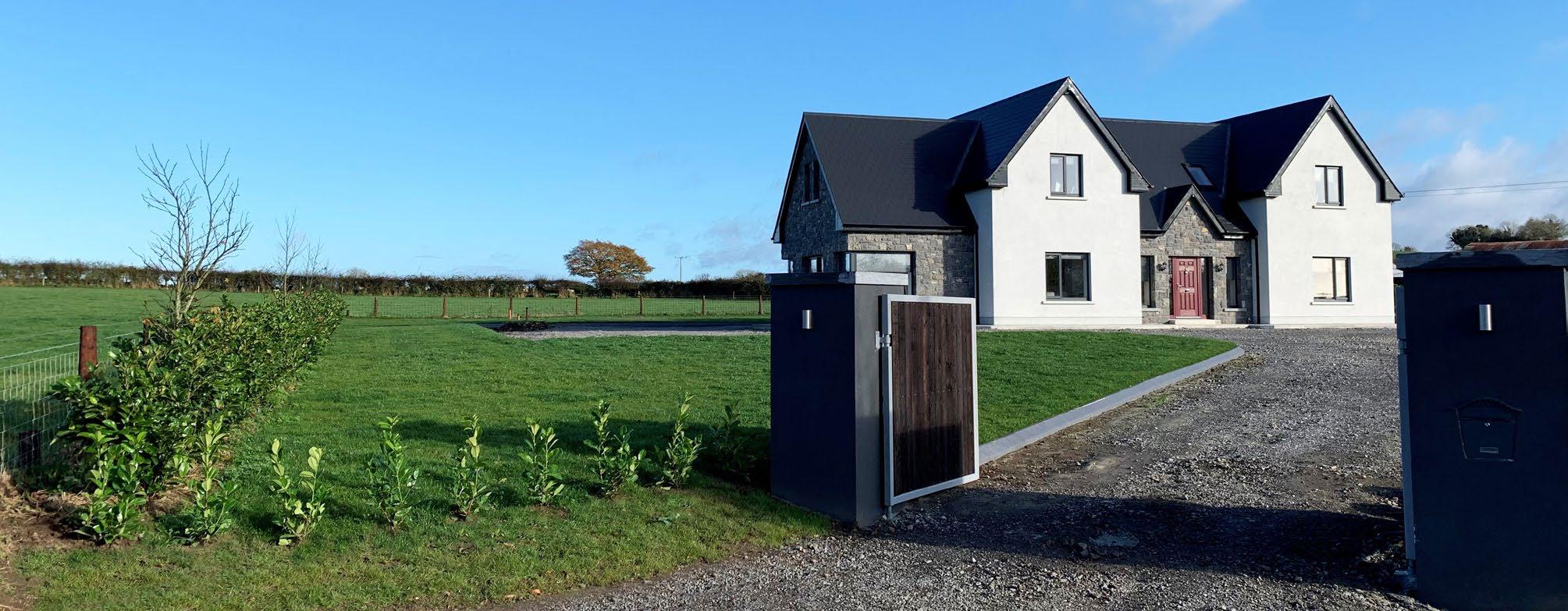
The package installed in this project features sustainable heating technologies, including a main heat source, hot water storage, heat emitters, and smart heating controls. All technologies have been carefully combined to maximise efficiencies for the 2,735 sq ft family home – and sized and specified to suit both the home and the homeowner’s preferences and heating needs.
The main heat source of choice for the home was the A+++ rated Grant Aerona³ R32 10 kW air-to-water heat pump. The Grant Aerona range offers a cleaner, more environmentally friendly performance and is available in outputs of 6, 10, 13 and 17 kW. Units within the range also boast superior seasonal coefficient of performance (SCOP) even at colder temperatures, and can lower a property’s overall carbon footprint, whilst helping to achieve required building standards.
The project was the first to install the new Grant Integrated Unit, a space-saving, sleek and stylish innovation installed for domestic hot water needs. The unit has been developed to work seamlessly with the Grant Aerona³, ensuring the Gath
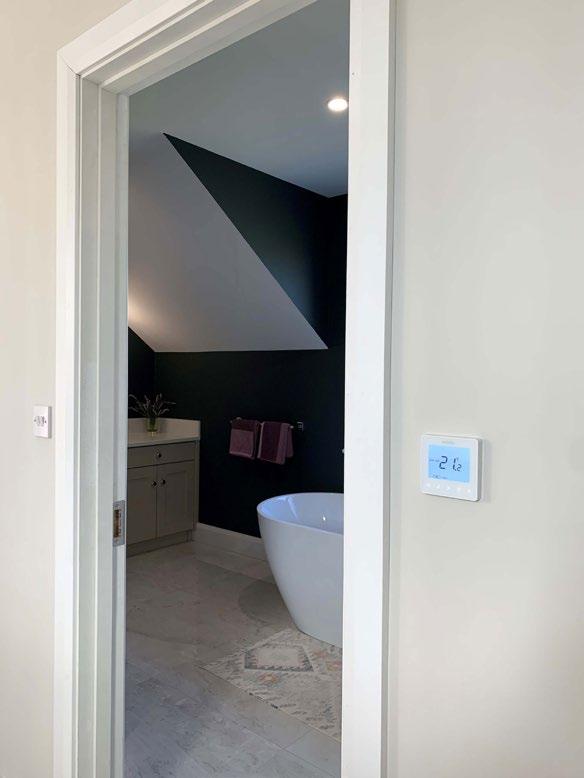
family can avail of an optimum efficiency, complete heating solution that can be relied on for many years to come.
For heat emitters, the Grant Uflex underfloor heating system has been fitted throughout the property. The system offers an efficient heating solution as it works effectively with high and low temperature heating and is perfect for those who prefer a modern and minimalistic home decor look.
Speaking about the project, homeowner Dermot Gath said, “Since installing the Grant Aerona³ R32 heat pump we have found the heating system to be very cost-effective. As a family we knew that we wanted to build a home that was heated using renewable heating technologies to ensure that it was environmentally friendly. We knew we could trust Grant to deliver what we envisaged to heat our home and so far, we are very impressed with the cost savings we are making on our heating bills and the comfort we are experiencing from our heating system.”
To complete the project, the Gath family opted for Grant smart heating controls, which can be set to provide different room temperatures and different time intervals on individual heating zones, at the click of a button.
Grant works with both self-builders and those working on larger scale new build projects. To have your bespoke integrated heating package designed and specified free of charge by Grant, send your house plans to heatpump@grantengineering.ie
All Grant products are available from plumbing and heating merchants throughout Ireland. For further information visit www.grant.eu •
ph+ | marketplace | 75 PASSIVE HOUSE+ MARKETPLACE
(above) Grant’s new integrated heating package was installed at the Gath family’s new home in Co Offaly. The heating package combines a heat source (in this case a Grant Aerona³ air-to-water heat pump), hot water storage, heat emitters, and smart heating controls.
New marketing manager joins Ecological Building Systems
Kieran Holohan appointed MD of Saint-Gobain Ireland
Havingjoined Saint-Gobain in 2007, Holohan has spent the last nine years as Saint-Gobain Ireland’s marketing director. Prior to this, he held the positions of marketing manager with Moy Isover and strategy manager for Saint-Gobain Ireland. During this time, he has been instrumental in the development of Saint-Gobain’s Gyproc and Isover businesses and played a pivotal role in the organisation’s wider success.
Throughout his career at Saint-Gobain, Holohan has been an integral part of the leadership team and has amassed extensive experience of the Irish construction market and the competitive dynamics that shape it. In his new role, Holohan will be responsible for developing and executing business strategies for the Saint-Gobain brands Gyproc and Isover in Ireland. He will oversee the company’s executive team, and manage the company’s business operations, as well as continuing to grow and enhance Saint-Gobain’s brand profile as leaders in the Irish building materials market.
A Laois native, Holohan holds a bachelor in business studies from the Atlantic Technological University and was awarded an MBA from the South East Technological Institute in 2022.
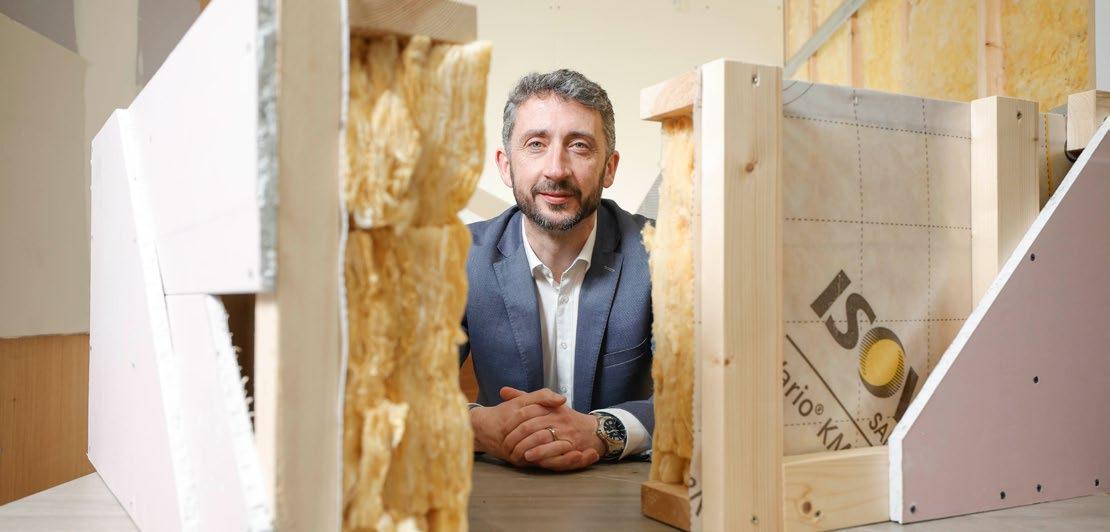
After a career with Saint-Gobain Ireland spanning more than 16 years, Pádraig Barry will retire at the end of May.
Pioneering airtightness and windtightness solutions provider Ecological Building Systems have further strengthened their team with the addition of Sabina Kucz as their newly appointed marketing manager.
Sabina joins the company, which is focused on supporting the optimisation of building performance, building health and durability, with more than 20 years’ experience in both offline and online marketing, and over five years’ experience in the construction industry.
As the new marketing manager, Sabina will be responsible for developing, implementing, and executing strategic marketing plans in the UK and Ireland, to maximise and develop sales and awareness across the Ecological Building Systems product portfolio.
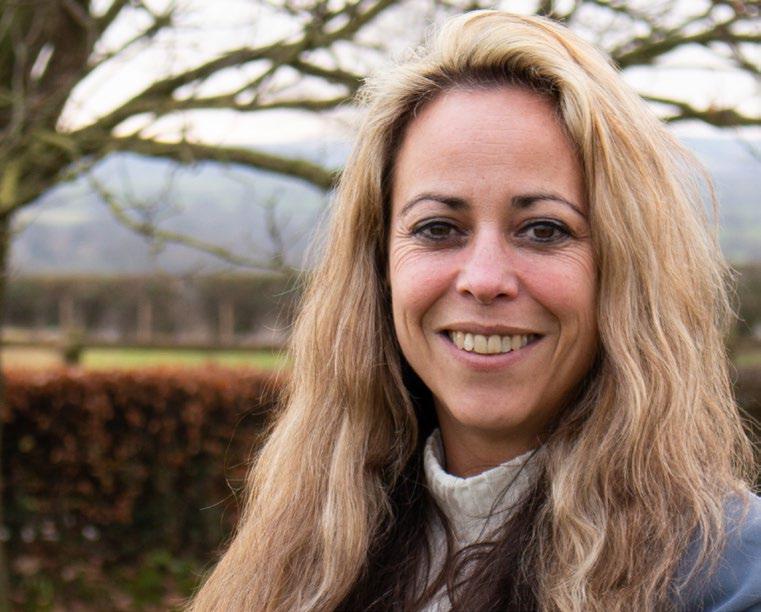
With energy savings and sustainability at the forefront of the conversation, the company is in a period of rapid growth. In this role, Sabina will utilise her knowledge and experience to assist in strengthening the message that Ecological Building Systems is committed to better building techniques using ecological products.
She comments: “I have followed Ecological Building Systems for some time and know they have developed a reputation for being one of the most trusted and respected, forward-thinking companies; that deliver products and systems that achieve airtight, breathable buildings. I am very excited to be joining the team and very much look forward to helping relay the message of a “Fabric First” approach to better building techniques and products.”
Adrian Crosson, director and general manager of Ecological Building Systems Ireland commented: “Sabina joins the management team at an exciting period of growth within our company and the wider industry. We have ambitious plans and targets to build our brand and her invaluable contribution and experience will enable us to meet these head on. She is a very welcome addition to our team.”
To contact Sabina please email: Sabina@EcologicalBuildingSystems.com
For further information visit www.ecologicalbuildingsystems.com •
Speaking on his appointment Kieran said: “I am delighted to be appointed managing director of Saint-Gobain Ireland. I want to thank Pádraig for the stellar work done under his leadership and the substantial contribution he has made to this organisation during his sixteen years of service.”
Holohan stressed Saint-Gobain Ireland’s role as a key contributor to the construction of safe and sustainable buildings in Ireland. “As a worldwide leader in light and sustainable construction, we have a key role to play in building a carbon-neutral economy in Ireland,” he said. “I look forward to leading our exceptionally talented team to continued success and further growth as we play our part to ensure Irish buildings are efficient, safe, sustainable, and great places to live and work. I will dedicate myself to ensuring the growth ambitions for the organisation are realised and that we build on our strengths to deliver the best possible service to our loyal customer base.””
A world leader in light and sustainable construction, Saint-Gobain designs, manufactures and distributes materials and services for the construction and industrial markets. Its integrated solutions for the renovation of public and private buildings, light construction and the decarbonisation of construction and industry are developed through a continuous innovation process and provide sustainability and performance. The group’s commitment is guided by its purpose, “Making the World a Better Home”. The company has pledged its commitment to achieving carbon neutrality by 2050.
Saint-Gobain’s long history in Irish construction is represented through its Gyproc & Isover businesses, which combine to offer expertise in fire, energy, durability and sustainability. The company has been operating in Ireland since 1936, with operations in Kingscourt, Cavan and Magheracloone, Monaghan and headquarters in Kilcarbery, Dublin, employing over 240 people. The company is a founding member of the Irish Green Building Council and accredited by the Top Employers Association. •
76 | passivehouseplus.ie | issue 44 MARKETPLACE PASSIVE HOUSE+
(below) Kieran Holohan, Saint-Gobain Ireland’s incoming managing director.
What goes around comes around - why the history of refrigeration points to the future of heating
As efforts to decarbonise buildings gain pace, heat pumps powered by an increasingly clean grid are looking like an irresistible force. While reducing emissions from operational energy use rightly remains front and centre, embodied carbon is the next target – including the heat pump’s refrigerant. Toby Cambray goes back to refrigeration’s beginnings to find a route to a low carbon future.
Regular readers will recall that heat pumps and their role in retrofit have been a recurring topic in this column. Initially I suggested that it was time to put the sacred cow of ‘fabric first’ out to pasture, or at least think about its importance in the context of national retrofit, heated by heat pumps via an increasingly low carbon grid. We must still insulate, for comfort and health, and indeed to minimise infrastructure costs, but heat pumps are at a higher level of readiness to scale out, and if done thoughtfully, need not preclude a subsequent fabric retrofit.

Lloyd Alter then queried whether there was an issue with oversized heat pumps following a heat pump first, fabric later retrofit: does this cause short cycling and a loss of efficiency? The answer is not really, especially with modern inverter-driven heat pumps, assuming everything has been otherwise well-designed and commissioned. That said, dramatically oversized heat pumps often underperform. While assumption is the mother of all cockups, this is a pragmatic approach that is reflected in the new AECB CarbonLite Level 1 Retrofit Standard. On the Zero Ambitions podcast Lloyd recently drew attention to the issue of upfront carbon with heat pumps, in particular those nasty refrigerant gasses. So, we’re going deep on refrigerants and refrigeration.
If you were able to engineer suitable compressors, valves and heat exchangers, pretty much any fluid could be used as a refrigerant. You start in the gas state, squeeze it up to high pressure (which makes it hot), take the heat out (which makes it condense) and use it in your heating system. Then let the pressure off (which makes it expand and cool), and it sucks in heat from the outdoor air (which makes it boil back into a gas), and round you go again.
In principle this could happen with all fluids. It’s just a matter of creating the right
combinations of temperatures and pressures. This is much more practicable (in terms of the necessary pressures) and useful (in terms of resultant temperatures) for a group of substances we call refrigerants. The need for fluids with just the right behaviour under temperature and pressure is at the heart of the challenges refrigeration engineers have faced for the last 200 years: it turns out that many of the good candidates have unfortunate side effects. But let us start at the beginning.
A condensed history of refrigeration
Natural scientists including Benjamin Franklin and Michael Faraday had experimented using changes in pressure to create cooling effects as early as 1758. In the 19th century USA, the ice trade rapidly developed, where ice was transported from the north to warmer climes, where it was used in simple ice boxes and cold storage; the benefits to the food industry led to the rapid growth of the ice trade. A passive house specific aside – large blocks of ice melt surprisingly little during transport due to a good form factor, when compared to say an ice cube.
James Harrison (1851). These early advances employed ether, ammonia or alcohol as the refrigerant fluid. The refrigeration industry burgeoned with demand from the food and beer industry. Somewhat ironically, the refrigeration industry’s out-competing of the ice industry was helped by concerns about ice tainted by environmental pollution. This competition was also the origin of a unit of refrigeration still used in the US – the ton. Refrigeration salesmen equated the cooling capacity of their equipment to the equivalent daily weight of ice the customer could avoid buying. One ton of cooling capacity is about 3.5 kW, the latent heat of fusion of a ton of ice over 24 hours.
Until 1930, refrigeration remained an industrial process. Machines were big, expensive and dangerous. The fluids in use were often flammable, toxic or both. Methyl chloride and sulphur dioxide were widely used, and explosions and leaks of toxic gasses were not uncommon. Industrial refrigeration was therefore used to produce ice for consumers who used it in their homes instead of ‘natural’ ice. In response to safety concerns, in 1930, the Frigidare company first synthesised Freon which, being non-
The vapour compression cycle, the principle on which the overwhelming majority of heat pumps and indeed most refrigeration in use today works, was first proposed in 1805 by Oliver Evans. Patents for designs were sought by Jacob Perkins (1834), John Gorrie (1842), Alex Twining (1850) and
toxic and non-flammable, paved the way for the mass adoption of domestic refrigerators. Freon is a trade name for a whole family of compounds that chemists call chlorofluorocarbons (CFCs).
In the 1970s, it was realised CFCs were damaging the ozone layer and phase-out
ph+ | dr toby cambray column | 77 COLUMN DR TOBY CAMBRAY
The vapour compression cycle – the principle on which the overwhelming majority of heat pumps work was first proposed in 1805 by Oliver Evans.
began with the 1987 Montreal Protocol. Specifically, it was the chlorine that caused the problem. This agreement is sometimes championed as an example of international agreement on environmental pollution. It is an ongoing tragedy that we have not achieved the same agreement with respect to fossil fuels. One reason for the success of the Montreal Protocol was that it has been relatively straightforward to introduce replacements for CFCs and their ilk. CFCs were phased out in favour of hydrofluorocarbons (HFCs) and the ozone layer has been mostly recovering ever since.
It is less commonly known that many refrigerants have a disastrous impact on global warming, on top of the ozone layer issues associated with pre-1987 compounds. HFCs are particularly powerful greenhouse gasses. To set this in context it is useful to introduce a metric called global warming potential (GWP), which measures the impact of a gas on the greenhouse effect, relative to CO2. One kg of gas with a GWP of 2 has the same climate change impact as two kg of CO2. Methane is a useful point of reference here because its release from livestock, permafrost, so-called fugitive emissions and so on, is a significant issue with respect to climate change. Methane has a GWP of 28 – dramatically more impactful, per kg emitted, than CO2
A complication with the definition of GWP is that some gasses break down in the atmosphere. CO2 is quite stable (one of the reasons the greenhouse effect is a problem), whereas methane is removed, on average, in around 12 years. The time frame over which the GWP is calculated therefore influences the value significantly. Estimates are often based on 100 years. This begs another question; given the climate emergency is upon us, and the next 10 years are crucial, what is an appropriate timescale to use for
making these decisions? Furthermore, the GWP does not usually include the up-front carbon. Although there’s plenty in the atmosphere, even pure CO2 (which, spoiler alert, is a potentially useful refrigerant) has a carbon footprint because it takes energy to isolate it.
If you were shocked at the relative power of methane to induce climate change, wait till you hear about refrigerants. Until very recently, and to some extent even now, two of the most common refrigerants in heat pumps were R-134a and R-410a. While neither of these gasses damage the ozone layer, their GWP100 values are 1,430 and 2,088 respectively. For context, heating an average size passive house dwelling (and its domestic hot water) with an air source heat pump (ASHP) would cause the emission of roughly 350 kg. A domestic ASHP might contain one or two kg of refrigerant, so a total leak would be equivalent to say 3.5 tonnes of CO2. Very roughly, a bad leak of an older refrigerant is equivalent to 10 years of operational emissions in a very low energy dwelling.
Reasons to be cheerful
In 2016, the signatories to the original Montreal Protocol agreed the Kinshasa Amendment, to phase out HFCs due to their significant impact on the climate. The UK for example is phasing down HFCs by 79 per cent from 2012 levels by 2030, via a combination of reporting regulations and quotas. This intervention has spurred the rapid development of alternatives in heat pumps, which in some respects brings us full circle. In the early days of refrigeration, engineers were using what we would call today natural refrigerants – as opposed to those that must be synthesised. Today, natural refrigerants are once more in vogue because they mostly have no impact on the ozone layer,
and much smaller, if any influence on global warming. These gasses are often unremarkable substances when you look up the meaning of the somewhat confusing R- numbers beloved of engineers. Available today are small ASHPs containing R-32 (Difluromethane, GWP of 677), R-744 (CO2, GWP of 1) and R-290 (Propane, GWP <10).
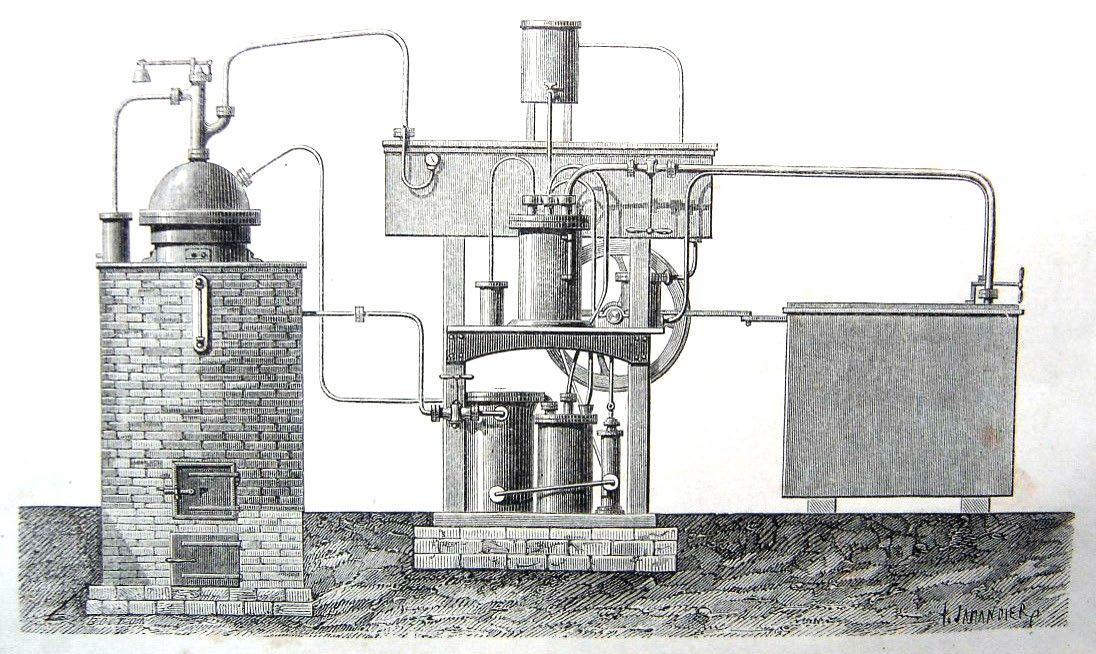
While there is no such thing as a free lunch, the disbenefits and compromises necessary for these gasses to work are not unreasonable. Propane is of course flammable and is also somewhat toxic; R-32 is flammable and is moderate as a GHG. Flammability has been a sensitive topic in the UK since June 2017, but one could argue such gasses are acceptable in monobloc systems where the gas is entirely outdoors. R-32 also must be held at high pressure to achieve the temperatures necessary for a domestic heat pump. As well as being more costly to engineer, the high pressure makes leaks more likely. This is a key challenge with ultra-high pressure CO2 based heat pumps, although leakage is much less of a climate issue due to the low GWP. As well as the high pressures, natural refrigerants generally have a lower specific cooling capacity than their more harmful synthetic counterparts. This means you need more of the particular refrigerant to deliver each kW of heating (or cooling), but also you will need physically larger compressors and heat exchangers. This will increase upfront carbon (more copper, aluminium and steel) as well as costs. As much as I’d like to, I’ve not undertaken an extensive market survey scrutinising and comparing EPDs, but I suspect these costs are acceptable and tend to be outweighed by the environmental impacts of older refrigerants so we should not begin a campaign for the overturning of the Montreal Protocol.
Ten years ago I tried and failed to buy a CO2 heat pump for our office, ending up with an R-134a device. Such things existed but not on the market in the UK. Today the landscape is very different – the Kinshasa Amendment is ratified, and the industry is loudly proclaiming its innovative developments in the field of natural refrigerants. This is to be welcomed, but we should bear in mind that the change was largely driven by boring old regulations. Thank heavens for red tape. The move towards less harmful refrigerants is not entirely without issues, although these are largely within the purview of manufacturers. On the whole though these are reasons to be cheerful. n
Toby Cambray is a founding director at GreenGauge and leads the building physics team. He is an engineer intrigued by how buildings work or fail, and uses a variety of methods to understand these processes.
DR TOBY CAMBRAY COLUMN 78 | passivehouseplus.ie | issue 44
(above) Patented in 1859, Ferdinand Carré’s ice making device, an absorption refrigerator that used ammonia as the refrigerant.












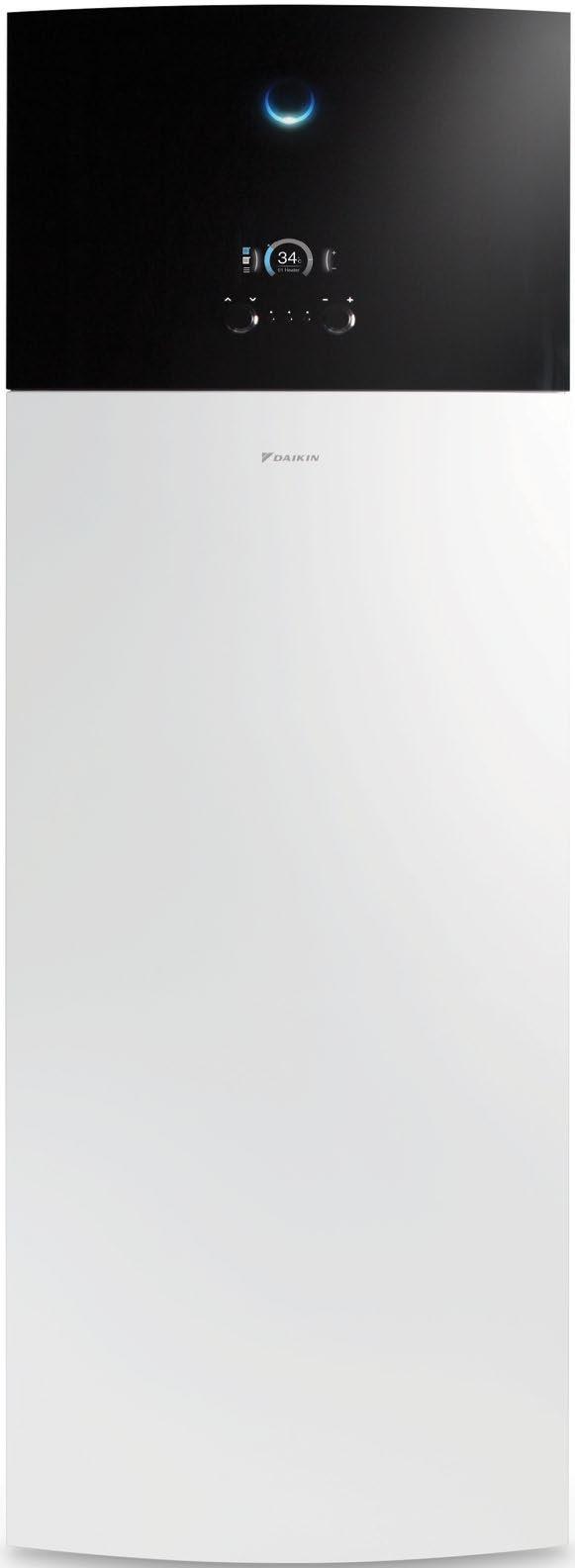
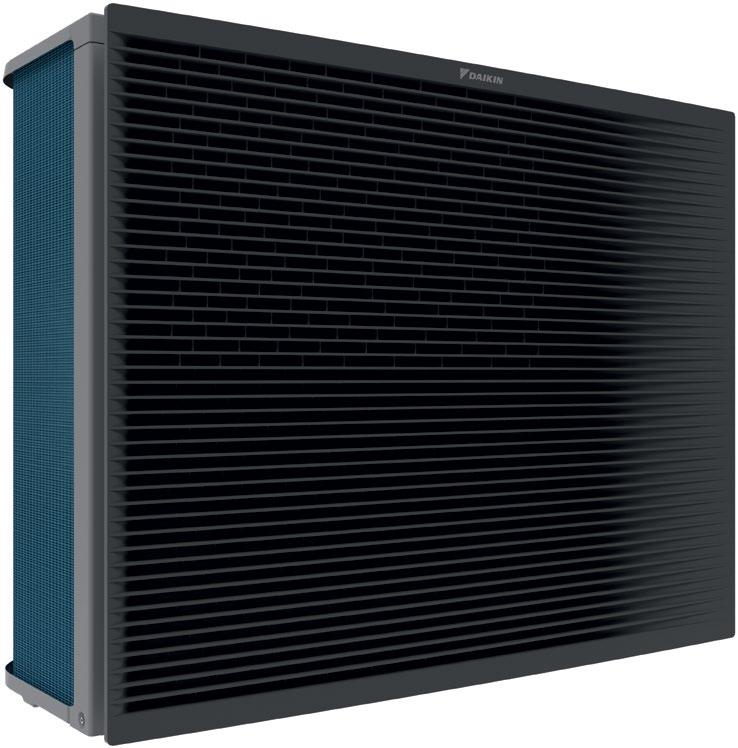
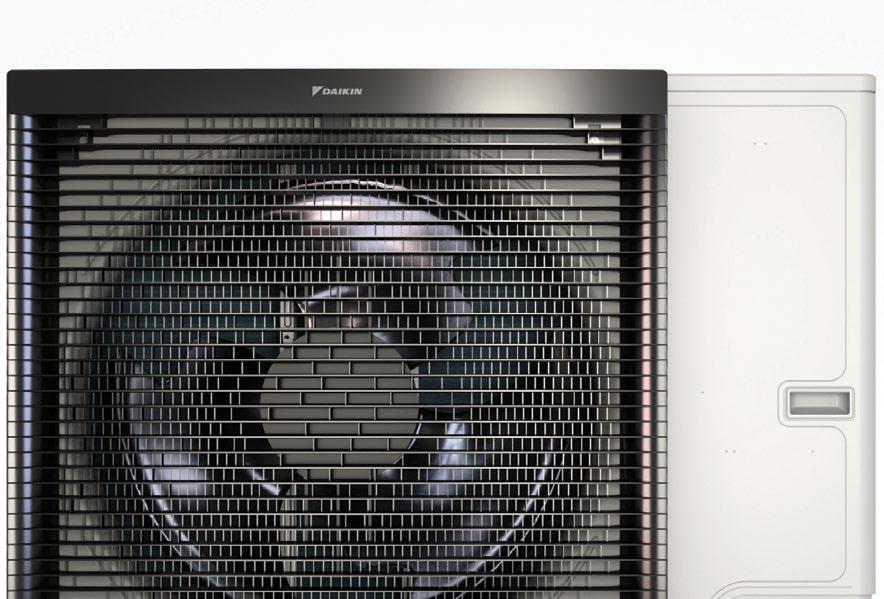



Daikin Altherma 3 Welcome renewable heat into your home For more information visit www.daikin.ie or email heating@daikin.ie for dedicated design support European market leader in heat pump technology Both low and high temperature options available meeting all heating demand requirements Complete range of highly efficient R-32 heat pumps from 4 -16kW Market leading heating and DHW efficiencies, providing COPs up to 5.1 and 3.3 respectively Smart Control as standard allowing control of your system from your phone or smart speaker Assorted range of outdoor and indoors units to integrate flawlessly into any new or existing home Established service partner network all around Ireland trained by Daikin R-32 Daikin Home Energy Upgrades Learn about












































































































































































 By Jason Walsh
By Jason Walsh















































